
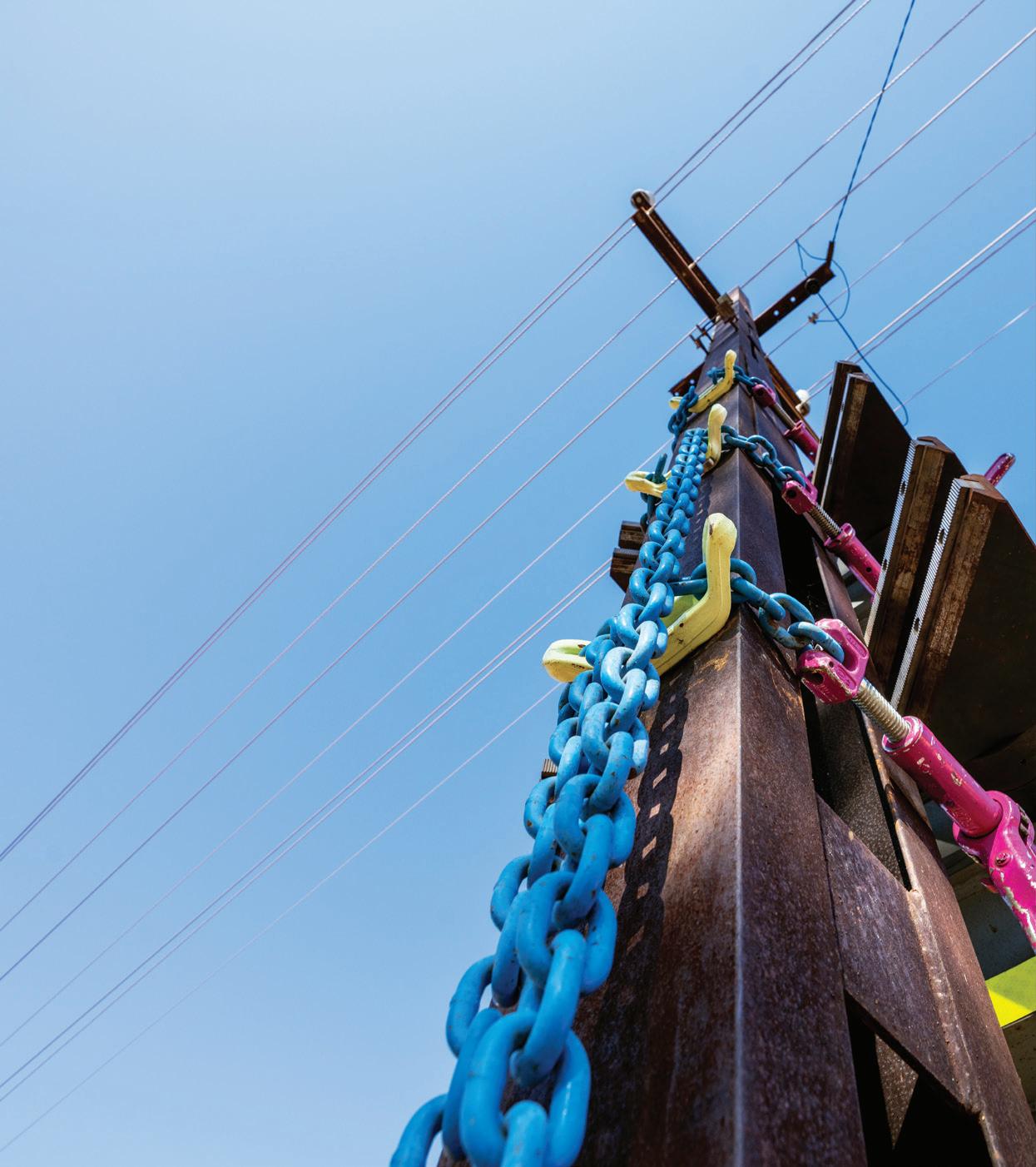
WATER SEWER ELECTRICITY GAS Engineering, Construction & Maintenance www.utilitymagazine.com.au Issue #32, November 2021
UPGRADING CORRODED POWER POLES ON THE SPOT STAYING LIVE Tracking COVID-19 IN WASTEWATER HOW ENERGY RETAILERS ARE KEEPING UP WITH THE COMPETITION
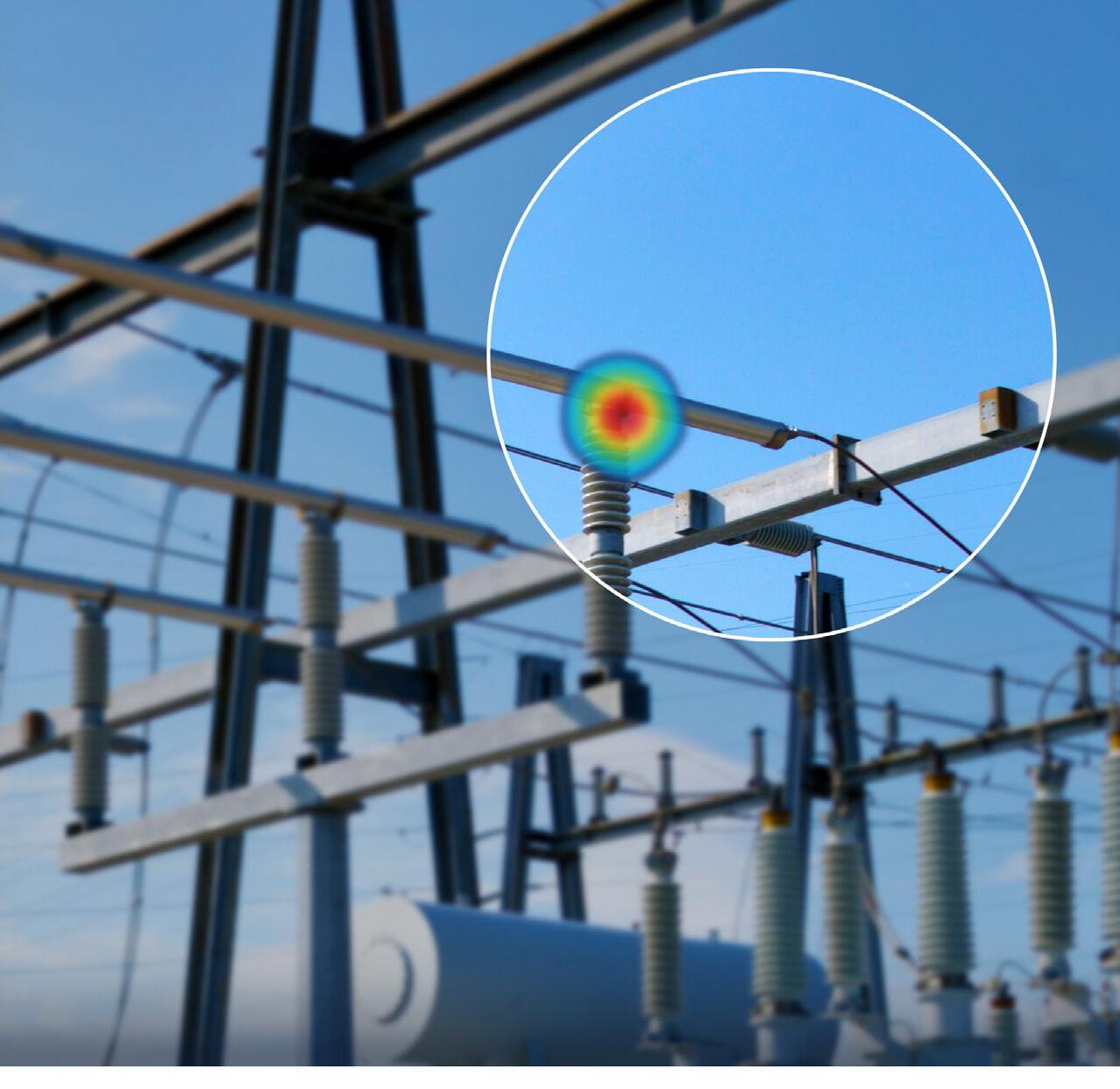

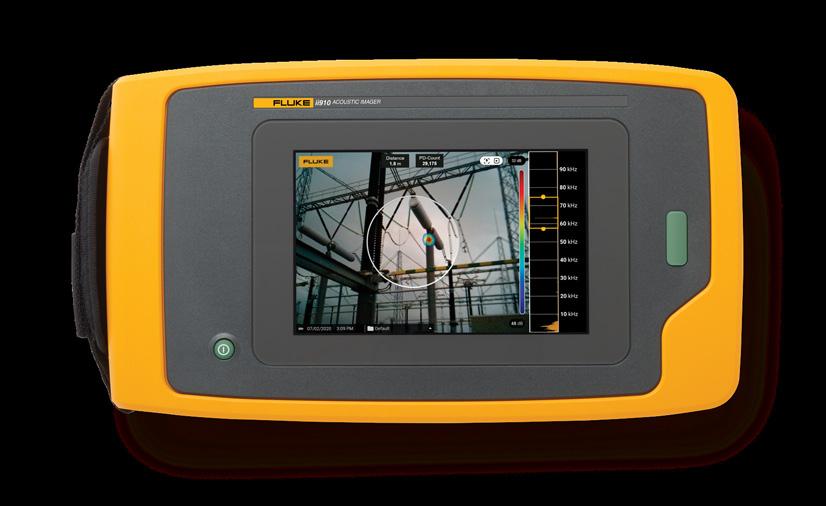
Fluke ii910 Precision Acoustic Imager
Quickly, easily, and safely monitor your equipment for partial discharge.
Partial discharge is a very serious issue that you would be like to be able to monitor quickly and easily. Whether you are inspecting insulators, transformers, switch gears or high voltage power lines you need to be sure that you can spot problems quickly and early. Partial discharge that goes unchecked can cause blackouts, fires, explosions, or even death from arc flashes. In addition, there is a significant monetary risk of downtime. Finally, a better way to safely detect partial discharge and prevent downtime before it occurs.

Learn more: fluke.co/ii910u11

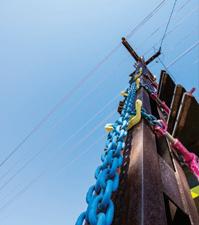
FROM THE EDITOR
I’m very excited to be writing this letter as the new editor of Utility, and introducing you to this wonderful edition of the magazine. I’ve stepped into the editor’s role after spending the last few years editing Utility’s sister publication, Infrastructure. I’ve worked across all of our magazines over the last six years and it’s been fantastic moving back into the utility space.

a wider look at different aspects of utility safety, among others.
info@monkeymedia.com.au
utilitymagazine.com.au
info@utilitymagazine.com.au
ISSN: 2203-2797
My predecessor Charlotte did a great job building Utility into what it is today – a respected industry voice for Australia’s utilities – and I hope to continue this legacy. With that in mind, I’d love to hear from you. Utility exists to give you that latest news, updates and thought-leading content on the issues that impact your day-to-day working lives.
Our aim is to have your challenges, concerns, opportunities, achievements and innovations reflected in every issue, so I encourage you to get in touch if you would like to pitch a potential story idea, discuss a future collaboration, or talk about some of the biggest industry issues you want to see in the pages of this magazine. My contact details are at the bottom of this page.
My team and I have jumped straight into this bumper issue to cover features including the biggest renewable projects underway around the country, an in-depth look into the role utilities have been playing over the last year detecting COVID-19 in wastewater, the innovation and product expansion happening in the retail and billing side of the industry, and
Some of the biggest issues I’m seeing in the utility industry revolve around the increasing need for our assets to be more sustainable as we move towards a net zero future, as well as the digitisation of the sector and the implementation and growth of new technologies. It all boils down to a commitment to deliver sustainable, reliable and affordable water and energy.
It would be remiss of me not to mention the biggest challenge that has been playing out over the globe for the last two years, COVID-19. Australia is collectively tired. Here in Melbourne, this edition of the magazine was made in lockdown number six – earning the city the title of longest lockdown in the world, with Sydney also joining us with strict lockdowns and restrictions.
It’s hard and people are over it, but utilities, as an essential industry, have continued to ensure the lights stay on and the water is running. When the country has to deal with something as unprecedented and unpredictable as a pandemic, it’s imperative that everything continues to function, and I think it’s fair to say all of our utilities have been doing a tremendous job. The Utility team and I can’t wait to further delve into the industry and continue to bring you the latest information, and we hope you enjoy this edition.
Jessica Dickers Editor
UTILITY • NOVEMBER 2021 Editor Jessica Dickers Assistant Editor April Shepherd Journalists Annabelle Powell Lauren DeLorenzo Design Manager Alejandro Molano Designers Jacqueline Buckmaster Danielle Harris Luke Martin Business Development Managers Rima Munafo Brett Thompson Marketing Manager Radhika Sud Publisher Chris Bland Managing Editor Laura Harvey Published by Cover image highlights our article on Power and Water's innovative pole replacement program. www.mcrobertcontracting.com.au office.admin@mcrobert.com.au and walls with PVC for 100% gas tight lining Patented technology ✓ MANHOLE REFURBISHMENT AFTER BEFORE Assess structural integrity asset Detailed interactive report with 3D modelling ✓ 3D LASER SCANNING AND ASSET INSPECTION UTILITY MAGAZINE NOVEMBER 2021 UPGRADING CORRODED POWER POLES ON THE SPOT STAYING LIVE Tracking COVID-19 IN WASTEWATER HOW ENERGY RETAILERS ARE KEEPING UP WITH THE COMPETITION WATER SEWER ELECTRICITY GAS Engineering, Construction & Maintenance www.utilitymagazine.com.au Issue #32, November 2021 Monkey Media Enterprises ABN: 36 426 734 954 C/- The Commons 36–38 Gipps St, Collingwood VIC 3066
monkeymedia.com.au
P: (03) 9988 4950
welcome November 2021 ISSUE 32 1
Drop me a line at jessica.dickers@monkeymedia.net.au or feel free to call me on 03 9988 4950 to let me know what you think. Don't forget to follow Utility magazine on social media - find us on LinkedIn, Twitter and YouTube.
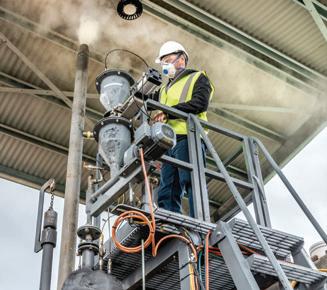


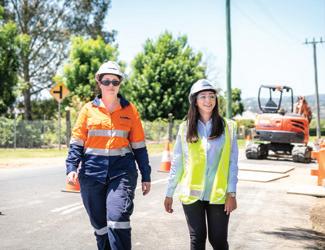
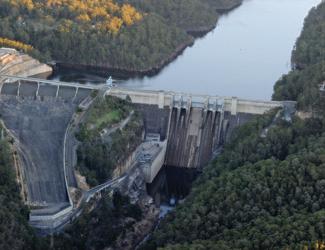
What are the benefits of selecting a microtunneling contractor with versatile equipment?
When it comes to microtunnelling, there are a number of challenges that can derail a project, costing time and money. That's why choosing a contractor with versatile equipment is important, as it increases the likelihood that your project will successfully be completed on time and on budget.
2 CONTENTS Renewables at a Glance: Australia's biggest up-and-coming projects 20 Reusing biosolids in the wastewater sector 24 Minding the citizen-utility gap 26 Economical water treatment through blending 28 LAND ACCESS A renewable energy future requires licence to operate ........ 30 Building a Digital Flood Twin of Tasmania 32 Wastewater sampling: utilities collaborating to track COVID-19 34 New technology transforms resiliency readiness 38 Implementing a cyber security plan to protect water and wastewater infrastructure .......... 40 CORROSION Engineering innovation ramps up rusted pole replacement program 42 Charting a path for utility digital transformation 46 Meeting 5-minute settlement regulatory requirements 47 A new billing system for Australian water utilities 48 Expanded product offerings: the future of energy retail? 50 With traditional revenue sources dwindling and energy retailers now competing for fewer customers, many companies have repositioned themselves as customer solutions providers, expanding their products to include insurance or telecommunications services. HORIZONTAL DIRECTIONAL DRILLING Albany to Denmark pipeline secures Denmark's water future 76 How HDD supports infrastructure asset resilience 80 Celebrating 85 years of innovation 82 DAMS Reimagining dam safety management 84 Water level and pressure instruments to meet all applications 88 84 82 50 34 24 90 UTILITY • NOVEMBER 2021 WWW.UTILITYMAGAZINE.COM.AU
RETAIL, BILLING AND CRM
RENEWABLES DISASTER MANAGEMENT
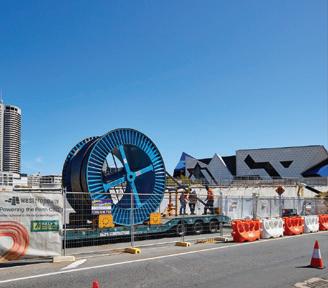

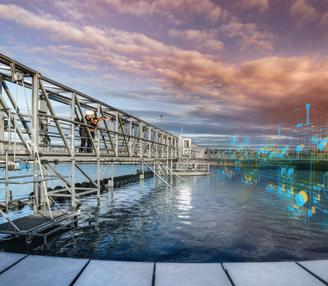
November 2021 ISSUE 32 3 74 In each issue Welcome from the Editor ������������������������������������������������������������������������������������������������������������� 1 A word from Energy Networks Australia ���������������������������������������������������������������������������������� 4 A word from WSAA ����������������������������������������������������������������������������������������������������������������������� 6 News briefs ������������������������������������������������������������������������������������������������������������������������������������ 8 Advertisers’ index ���������������������������������������������������������������������������������������������������������������������� 92 Editorial schedule ���������������������������������������������������������������������������������������������������������������������� 92 QLD-NSW Interconnector boosting reactive power and grid stability 54 Powering up Perth: the Western Power Hay to Milligan Project 58 The invisible threat you can now see ........................................ 60 Boost productivity with PowerFlex 6000T medium voltage drives ... 62 Listen up: TasWater’s active leakage management technology ............ 64 In a bid to address water losses in the network, TasWater has implemented active leakage management, featuring technology that listens for leaks that may not be visible to the naked eye. Manage water assets during a crisis by leveraging smart devices 66 Industrial reverse osmosis ......... 68 Essential Energy’s new digital and training safety initiatives 70 Inspiring confidence and improving process safety 72 Technology reducing costs for pump maintenance and downtime for water utilities 74 58 64 UTILITY • NOVEMBER 2021 WWW.UTILITYMAGAZINE.COM.AU TRANSFORMERS AND SUBSTATIONS LEAK DETECTION SAFETY
IS IT TIME TO RETIRE NETWORK UTILISATION MEASURES?
BY CHRIS GILBERT, SENIOR ECONOMIC ADVISER, ENERGY NETWORKS AUSTRALIA
How do you measure success? As the pathway to a two-way energy system becomes more well-trodden, yard sticks that measure how well networks utilise their assets need to change. The relevance of utilisation measures is under question – as they don’t show what they claim to anymore.
Utilisation measures have been referred to by various energy policy and regulatory bodies, as well as public agencies throughout the years, in different contexts.
At its most fundamental, network utilisation measures how well a network’s assets have been used to meet maximum demand and have been used as a signpost as to whether network investments are delivering value for customers.
The most common utilisation measure is calculated as the very unpleasant phrase ‘non–coincident summated raw system annual maximum demand’. In English this means the peak of each zone substation’s highest demand, at different times across the year without normalisation for temperature, divided by the total capacity of all zone substations on a network.
TIMES HAVE CHANGED
Network utilisation was traditionally very stable in a one-way system prior to the introduction of heightened state reliability targets. Overzealous reliability targets, in some cases, drove additional network investment to mitigate against potential disaster on the electricity network’s most demanding days. These investments coincidentally resulted in some minimally used capacity and a reduction in measures of network utilisation.
In the years since, old state-based reliability targets have been wound back and distributed energy resources (DER) such as solar PV and battery uptake, have continued to surge. The measure of network utilisation has crept upwards as zone-substation capacity declined and distributors adapted
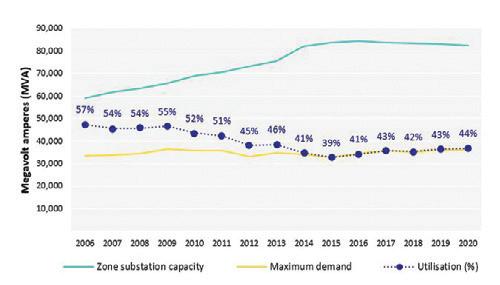
to invest in new areas where it was needed most, like highly populated areas and those with high DER.
As DER continues to become a staple in the electricity system, its continued uptake is muddying the waters on what network utilisation measures actually show.
WHAT DO UTILISATION MEASURES ACTUALLY SHOW?
Customers are demanding increased ability to export solar and connect their DER, creating local demand for network usage that may require additional network investment to facilitate. While DER might create network congestion at the local level, it can also result in a reduction in the overall demand requirement at the zone substation level.
This reduction in demand can have the effect of reducing utilisation measures, while also requiring additional investment in network reinforcement, raising questions about what these measures represent in a two-way energy system.
Whether fortunate or by design, utilisation measures most often cited are related to peak demand on each zone substation. This traditionally occurs in the evening when DER output is low and its impact on reducing utilisation is less severe, but still exists.
In today’s electricity system, customers are showing strong preferences for DER uptake and distributors are rightly targeting investment to enable these preferences. Is it sensible then, that enabling customer preferences might be having unintended negative impacts on measures often associated with network performance?
This conundrum raises an interesting question about the usefulness of utilisation measures in a high-DER future, and whether we should be looking at alternatives.
CAN WE DO BETTER?
Discussing utilisation measures in the context of network performance may have made sense when we had single direction transmission ‘highways’ and large baseload generation centres, but much less so in a high-DER world with scattered, non-synchronous generation centres.
Network regulation in Australia doesn’t directly draw on utilisation measures for benchmarking or productivity assessment, and rightly so. It’s probably time to consider retiring utilisation measures and shifting focus to measures that have more meaning to customers in practice.
4 UTILITY • NOVEMBER 2021 WWW.UTILITYMAGAZINE.COM.AU A WORD FROM ENERGY NETWORKS AUSTRALIA
FIGURE 1 – NETWORK UTILISATION OF ELECTRICITY DISTRIBUTION NETWORKS. SOURCE: AER STATE OF THE ENERGY MARKET 2021, P. 168

THE ROCK DRILL FOR A RANGE OF CONDITIONS
The D40x55DR S3 Navigator® horizontal directional drill helps deliver excellent productivity in a broad range of conditions, from hard, medium and soft rock. Dual rod technology delivers powerful down-hole drilling action and the flexibility to select the right tooling to match ground conditions. Maximise jobsite productivity with 40,000 lb (177.9 kN) of thrust and pullback and 5500 ft-lb (7457 Nm) of rotational torque. Demo the D40X55DR S3 and experience the difference.
VERMEERAUSTRALIA.COM.AU | 1300 VERMEER
/ VermeerAustralia
Vermeer and the Vermeer logo are trademarks of Vermeer Manufacturing Company in the United States and /or other countries. © 2021 RDO Equipment Pty Ltd (trading as Vermeer Australia). All Rights Reserved.
A WORD FROM WSAA
FLUSHABLE PRODUCTS STANDARD TO HELP CLEAN UP MESS
After a couple of years of work, Standards Australia has released the Draft Standard, DR AS/NZS 5328 Flushable Products, for public comment.
The draft Australian/New Zealand Standard defines the criteria for material suitable for toilet flushing, along with appropriate labelling requirements.
The Draft Standard has been developed by a technical committee including manufacturers, water utilities, peak bodies and consumer groups.
Wastewater systems are key to protecting public health and the environment, however when any blockage occurs, there is a risk that wastewater may spill from the system and create public health and environmental risks, along with otherwise unnecessary costs to water utilities and customers.
WSAA and the urban water industry in Australia and New Zealand have been concerned about the contribution of wet wipes products to pipe blockages for some time. The issue became even more serious during the COVID-19

pandemic, with utilities reporting increases in blockages of between 20 and 60 per cent at the height of the pandemic last year, as people flushed materials never intended to go down the toilet, like paper towel and wet wipes.
The Draft Standard will provide manufacturers with clear specifications and sets out methods for testing whether products are suitable for toilet flushing and compatible with wastewater systems and the environment. It also includes guidelines for manufacturers to clearly label products to better inform customers whether or not their products are suitable for toilet flushing.
If a product meets the Standard, and is therefore suitable for flushing, the packaging can display a “flushable” symbol. Packaging for non-flushable products that have a potential to be flushed, should clearly indicate that the product should not be disposed of via the toilet. The new labelling could be on products as early as mid-2022.
The Draft Standard, DR AS/NZS 5328 Flushable Products is available
for public comment for nine weeks until 1 November 2021. The public consultation period allows any parties concerned with the application of the proposed Standard to review the Draft and submit their comments. The Draft Standard can be altered during this time.
It is not an Australian/New Zealand Standard until finally issued by Standards Australia/Standards New Zealand. The Standard will be voluntary, however we will be encouraging manufacturers of products to comply with the Standard, including labelling requirements.
Everyone is encouraged to comment, in particular water utilities and councils, manufacturers, industry bodies and consumer advocacy groups. To comment you must register on the Standards Australia website. Once you have logged in, DR AS/NZS 5328:2021, Flushable Products can be found on the Standards Australia Connect Portal. Public comments must be submitted using Standards Australia’s template to be accepted.
To review the Draft Standard and comment please go to: www.standards.org.au/news/flushable-products-colon-public-commenting-stage.
Or for more information, please contact Dr Greg Ryan, WSAA’s Director Business Excellence, at greg.ryan@wsaa.asn.au.
6 UTILITY • NOVEMBER 2021 WWW.UTILITYMAGAZINE.COM.AU
more than just maps
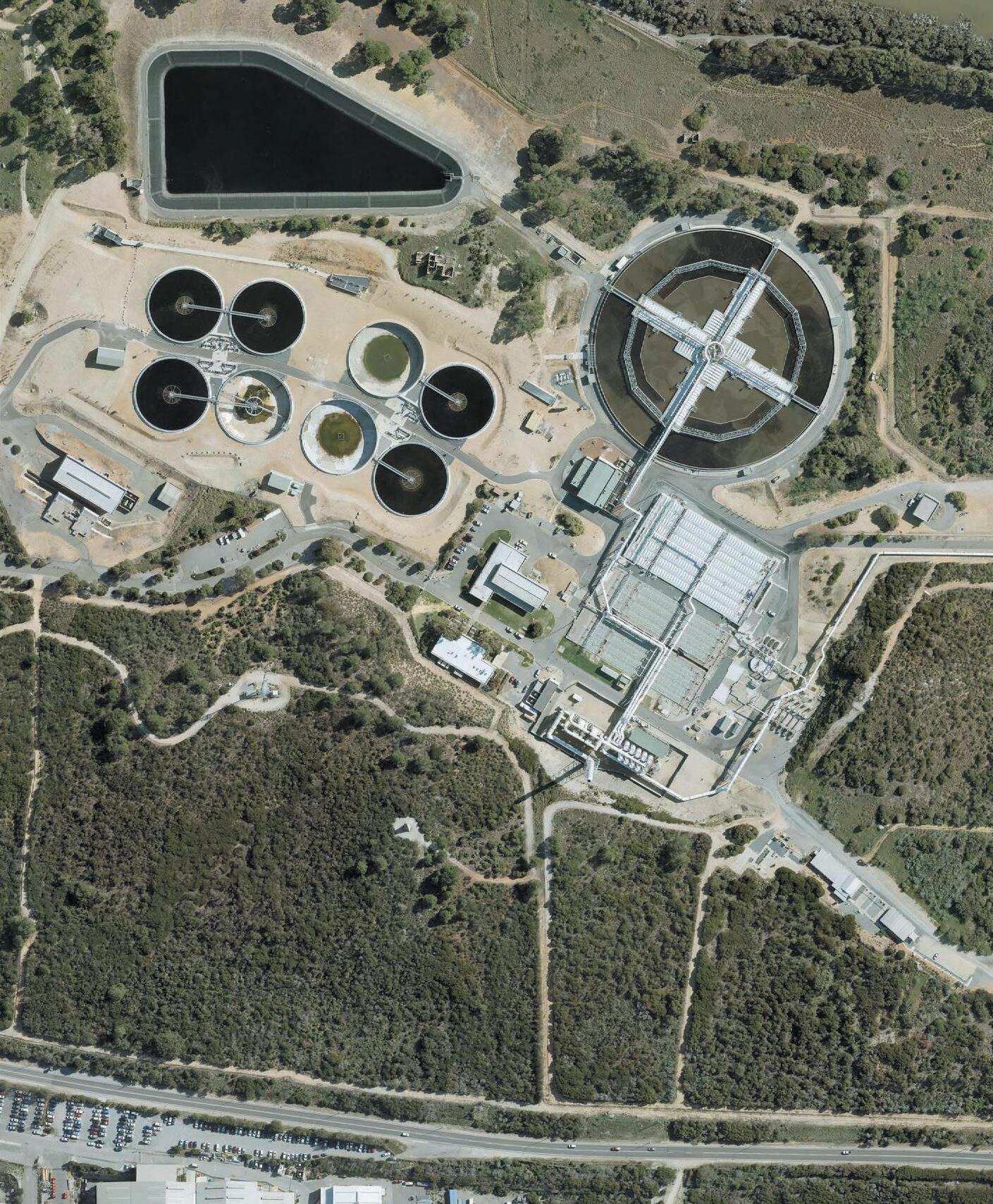
MONITOR UTILITY ASSETS FROM THE COMFORT OF YOUR DESK
• Manage your infrastructure reliably with frequent captures
• Respond efficiently to maintenance requests
• Monitor vegetation around critical assets
• Measure confidently with high spatial accuracy
• Flexible access via web-application or your own GIS
• Overlay rich cadastre and building insights
metromap.com.au
Scan to access free trial
MAJOR WATER UTILITY CEO TO STEP DOWN AFTER A DECADE
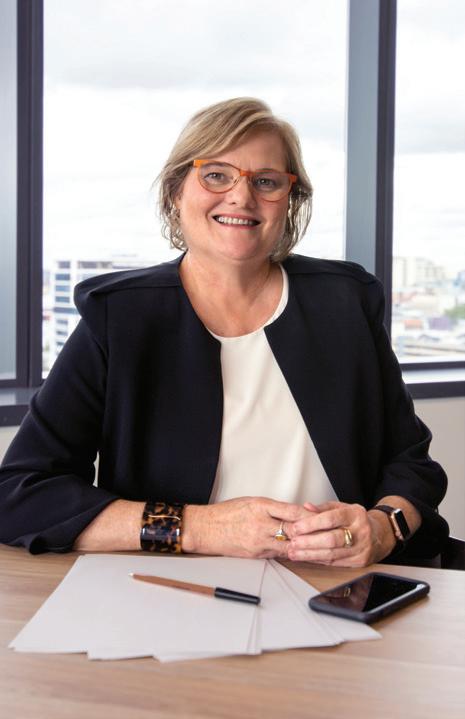
Urban Utilities has announced its CEO, Louise Dudley, will be resigning in August 2022, following ten successful years transforming the company into one of the world’s leading water authorities.
Urban Utilities Chair, Bronwyn Morris, said Ms Dudley was recognised as an exemplary leader in the water industry, serving on several Australian and international peak bodies.
“Next year will mark a decade as CEO for Louise and I’d like to acknowledge the outstanding contribution she has made in the transformation of Urban Utilities into an innovative, customer-focused organisation,” Ms Morris said.
“We’re pleased Louise will continue as CEO for another 12 months to oversee the delivery of a number of strategic projects and priorities and ensure a seamless transition to her successor.
“We remain excited for the future and look forward to building on our organisation’s strong foundations and
continuing to deliver for our customers and community.”
Ms Dudley was instrumental in the formation of Urban Utilities in 2010, which involved the merger of five local council water businesses to establish one of Australia’s largest water utilities.
“I’m extremely proud of the team that we have at Urban Utilities. Together, we have created a highperforming culture with a strong focus on customer service, enhancing our community and environment, and improving the wellbeing and safety of our employees,” Ms Dudley said.
After leaving Urban Utilities, Ms Dudley is looking forward to new professional opportunities including taking on board and advisory roles.
She is passionate about the water industry and will continue to serve as President of the Australian Water Association and as a Director of WaterAid and WaterStart Nevada.
The process to select Urban Utilities' next CEO will commence within October 2021.
SYDNEY WATER REVEALS NEW CHAIR
Sydney Water Corporations’ new Chair has been announced, replacing the outgoing Bruce Morgan, who will step down on 30 September 2021.
Prominent Australian businessman, Grant King AM, is the new Chair of Sydney Water Corporation. Mr King was appointed as a non-executive director of Sydney Water on 9 June before taking the reins of Chair on 1 October.
Mr King said he was delighted to be taking on the new role at such a pivotal time for Greater Sydney and paid tribute to the leadership of his predecessor.
“Bruce has made a significant contribution to Sydney Water over the past decade and in that time helped to successfully steer the business
and indeed Greater Sydney, through successive droughts, floods and more recently COVID,” Mr King said.
“Sydney Water has a key role to play in the future development of Greater Sydney, particularly in terms of resilience and liveability.”
Mr King is also the Chair of the Climate Change Authority, HSBC Bank of Australia, CWP Renewables, GreenCollar, Areventa and Melanoma Institute of Australia, a Non-Executive Director of the Origin Foundation, Great Barrier Foundation, O’Connell Street Associates and a member of the University of NSW Foundation.
He also holds a position as Professor of Energy Economics and is Chair of the Energy Institute at the University of NSW.
“I’m delighted to carry on Bruce’s legacy and look forward to working with the Board and the highly committed people of Sydney Water to create a better life for the citizens of Greater Sydney,” Mr King said.

UTILITY • NOVEMBER 2021 WWW.UTILITYMAGAZINE.COM.AU 8 NEWS
UNITED ENERGY’S WORLD-FIRST POLE-MOUNTED BATTERY to transform renewable integration
The Australian Renewable Energy Agency (ARENA), on behalf of the Australian Government, has announced $4 million in funding for United Energy to trial the use of pole-mounted batteries to operate as virtual power plants, supporting more rooftop solar and demand management services.
The first of its kind in Australia, the $10.98 million project will see 40 custom-built batteries manufactured and mounted to electricity poles across United Energy’s distribution network.
The batteries will operate as a virtual power plant (VPP), helping to manage peak demand across the low voltage distribution network in South Eastern Melbourne and the Mornington Peninsula, and increasing hosting capacity for rooftop solar.
Each of the 30kW batteries will be capable of providing at least two hours of storage and will be installed at strategic locations across the network.
The batteries will be manufactured locally by Thycon in Melbourne’s north and mirror the design of existing distribution transformers that are already mounted to poles across United Energy’s network in Melbourne’s bayside area.



In addition to reducing stress on distribution transformers in times of peak demand, the batteries will also be able to regulate voltage and increase the hosting capacity of solar PV in the local grid, providing benefits to all customers.
United Energy has signed a deal with Simply Energy for the market trading rights of the VPP. When the batteries are not required by United Energy, Simply Energy will operate them to provide wholesale power and frequency control ancillary services.
The project follows a successful pilot by United Energy that saw two battery units installed in early 2020 in the Melbourne suburbs of Black Rock and Highett to demonstrate the feasibility of pole-mounted technology.


CUSTOM CABLE SEALS harcor.com.au Master Security Licence No. 407319937 Custom cable seals can be used to indicate the valve’s position and what flows through the valve. Ask about our fantastic pricing on nitrile & latex gloves email sales@harcor.com.au for more information UTILITY • NOVEMBER 2021 WWW.UTILITYMAGAZINE.COM.AU 9 NEWS
JEMENA ANNOUNCES AUSTRALIAN-FIRST GREEN FINANCE FRAMEWORK
Jemena is releasing an Australian-first sustainable finance framework, to satisfy investor demand for more sustainable investment options.
The Green Finance Framework was developed in collaboration with global investment banks HSBC and ING, and is believed to be the first of its kind to be delivered by a traditional energy company operating in Australia.
The Green Finance Framework follows Jemena announcing its ambition to achieve net zero emissions by 2050, and will see the business use funds raised from green instruments such as bonds, loans, and promissory notes to finance and/or refinance projects, which will have a positive impact on the environment.
The framework applies to companies within the State Grid Singapore Power Australia Assets (SGSP Australia Assets) Group, including Jemena and engineering, project management, operations and maintenance services company, Zinfra.
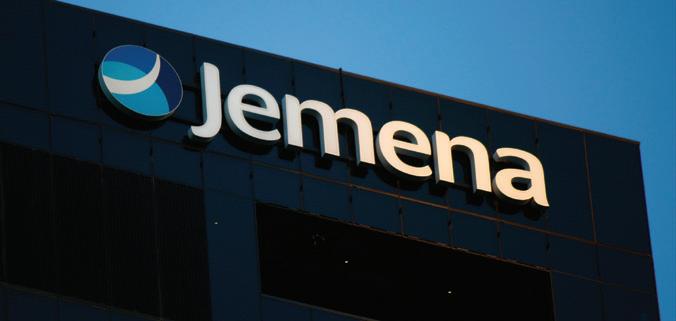
Jemena’s Chief Financial Officer, David Gillespie, said the framework reflects the Group’s contribution to the United Nations Sustainable Development Goals, particularly goal seven – affordable and clean energy –and goal 13 – climate action.
“This is a natural evolution of our Group’s Sustainability Strategy which focuses on supporting the development of new technologies as part of the energy transition,” Mr Gillespie said.
“Our Green Finance Framework gives confidence to investors that
they are backing projects which will make a difference in lowering carbon emissions, while also helping to create the energy system of the future.”
Net proceeds of green instruments issued by Jemena will be used to fund projects in four major categories: renewable energy, energy efficiency, clean transport, and climate adaptation.
Administration of the framework will be subject to external review, and will be reported annually as part of the Group’s annual reporting process.

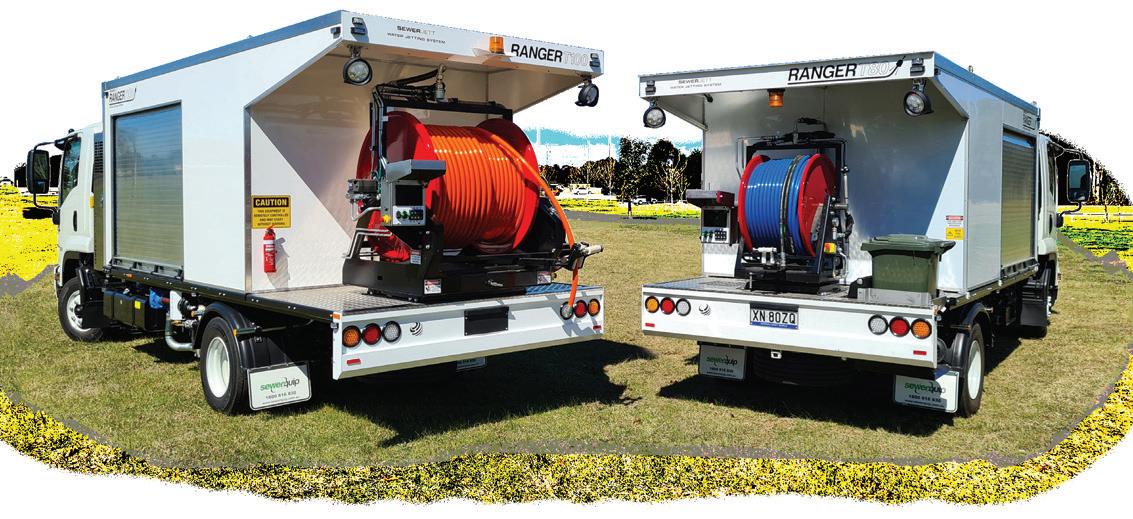
10 Call now 1800 816 830 Truck
Systems AUSTRALIAN MADE enviroline.net.au Practical, powerful, safe, efficient and reliable truck jetting range from Enviroline. 2 YEAR WARRANTY AUSTRALIA WIDE SERVICE PROUDLY AUSTRALIAN MADE Ranger T100 267LPM@ 2250PSI 180m x 1” I.D Jetting hose Ranger T80 160LPM@ 2600PSI 180m x ¾” I.D Jetting hose UTILITY • NOVEMBER 2021 WWW.UTILITYMAGAZINE.COM.AU NEWS
Jetting

WSAA calls for quick action on IA water recommendations
The Water Services Association of Australia (WSAA) has responded to reforms posed in Infrastructure Australia’s 2021 Infrastructure Australia Plan, joining the Productivity Commission in calling for a renewed and modernised National Water Initiative and calling on all governments to progress water-related recommendations from the Plan.
WSAA has welcomed the release of the Plan, which outlines a 15-year roadmap to improve the resilience and sustainability of essential infrastructure, including urban water.
The 2021 Plan responds to the 180 infrastructure challenges and opportunities identified in Infrastructure Australia’s 2019 Australian Infrastructure Audit, and sets out detailed recommendations to deliver better infrastructure for all Australians.
The 2021 Plan includes waste and social infrastructure for the first time, alongside energy, transport, telecommunications, and water.
It also focuses on three cross-cutting key themes: Place (Cities, Regions, Rural and Remote Areas, and Northern Australia), Sustainability and Resilience, and the Infrastructure Industry.
The water-related plans focus on creating resilient, secure and quality water supplies available for all Australians, to create attractive, liveable and resilient communities.
The Plan also acknowledges the need for consistent and reliable water and wastewater services in remote communities.
The WSAA said that, after Australia experienced two of the worst droughts recorded in recent history, they believe it is time to update the national water plan.
Key water-related takeaways from the Plan are:
• Consistent approaches to measuring water security risk to significantly improve governance of Australia’s water resources, supporting transparent and reliable decisionmaking that addresses the needs of local communities
• Stronger planning processes enabled by water security information to support better health and environmental outcomes, with reduced frequency and intensity of water shortages, enhancing community sustainability and unlocking social benefits
• Implementing a consistent approach to assessing water needs and measuring water security risk to help ensure regional, remote and rural communities have comparable levels of quality and access to services
• Prioritising water investments based on more accurate assessment of water security risk to improve the reliability of services that support economic productivity for both communities and businesses; in the long-term, this can improve affordability by reducing expenditure on reactive activities and improving efficiency.
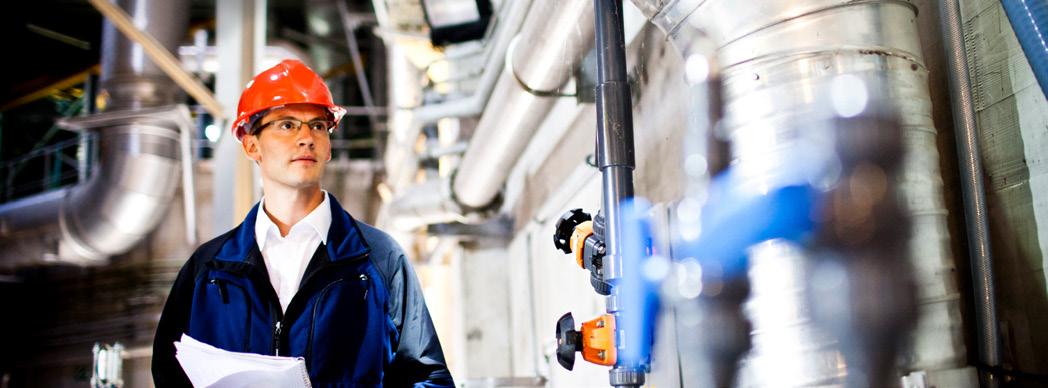
Innovative Water Solutions
Through its innovative solutions, Veolia Water Technologies enables industry, local authorities and citizens to optimize their use of resources for more efficient, environmentally-friendly and socially responsible outcomes.
We understand the importance of increasing the value of water and we do so by supplying high quality water, treating and reusing wastewater, producing and/or recovering energy, extracting raw materials and capitalizing on valuable byproducts.
www.veoliawatertechnologies.com.au
UTILITY • NOVEMBER 2021 WWW.UTILITYMAGAZINE.COM.AU 11 NEWS
WATER TECHNOLOGIES
© Veolia Photo Library
POWERCOR TRIALS NEW DRONE TECH ON BALLARAT POWER NETWORK
The Ballarat region has acted as a testbed for Powercor’s new drone technology, which is able to inspect powerlines promptly and in great detail.
Remotely-piloted drones have inspected more than 30km of powerlines around Ross Creek, Cambrian Hill, Napoleons and parts of Buninyong in recent weeks.
The work is in addition to Powercor’s ongoing program of asset inspections, which are also being conducted by crews in vehicles, on foot and by helicopter.
A specialist team is trialling the Matrice 300 RTK – a powerful industrial drone platform with an advanced flight controller system, six-directional sensing, real-time video transmission, thermal imaging and obstacledetection systems.
This follows a trial of a similar technology in the Otways in September 2020, with results from the new Ballarat trial to inform whether the technology is suitable for inclusion in Powercor’s continuous inspection program.
Powercor Head of Network Asset Management, John Mifsud, said the drone inspections had covered a large area, with high definition cameras used to capture the condition of powerlines quickly and easily.
Mr Mifsud said the area south of Ballarat was chosen due to its topography and environmental factors, as well as network characteristics that make the location a good trial site.
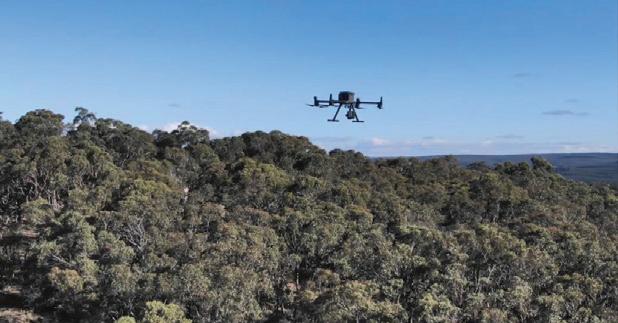
The drone trials also complemented extensive foot patrols in the area in early 2021, following reliability issues over summer for customers south of Ballarat.
“This trial is about finding new ways to keep our network operating safely and reliably,” Mr Mifsud said.
“While these drones won’t replace our existing inspection methods, we’re looking at whether they have a permanent role in our program in the future.”
Powercor manages its network of almost 90,000km of powerline and 588,000 poles through a rigorous inspection and maintenance program, on top of a network-wide vegetation management program clearing trees and shrubs well away from powerlines.

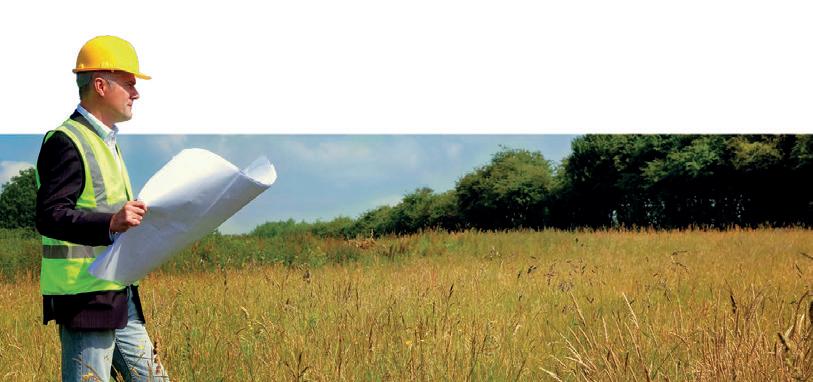
UTILITY • NOVEMBER 2021 WWW.UTILITYMAGAZINE.COM.AU P E Level 2, Suite 26/20 Enterprise Drive Bundoora, Vic, 3083 1300 1 L ANCO (52626) tenders@lancogroup com au lancogroup.com.au Your business partner for engineering solutions Since 1998. “We don’t purely just design; we help our customers realize their goal, if you give us an idea we can provide a efficient and effective engineering solution” Accredited consultant with Melbourne Water, Retail Water Corporations – Metropolitan and Regional Areas Corporate Profile Insurance Category Level of Cover $ Professional Indemnity $10 million Public Liability $20 million Work Cover n/a A list of applicable insurances includes: Name of Entity: Lanco Group Pty Ltd ABN: 27 160 328 478 Company Address: University Hill Business Park South Level 2, Suite 26/20 Enterprise Drive Bundoora, Vic, 3083 Company Structure: Private Company Quality ISO 9001 Environment Health & Safety AS 4801 ISO 14001 2 NEWS

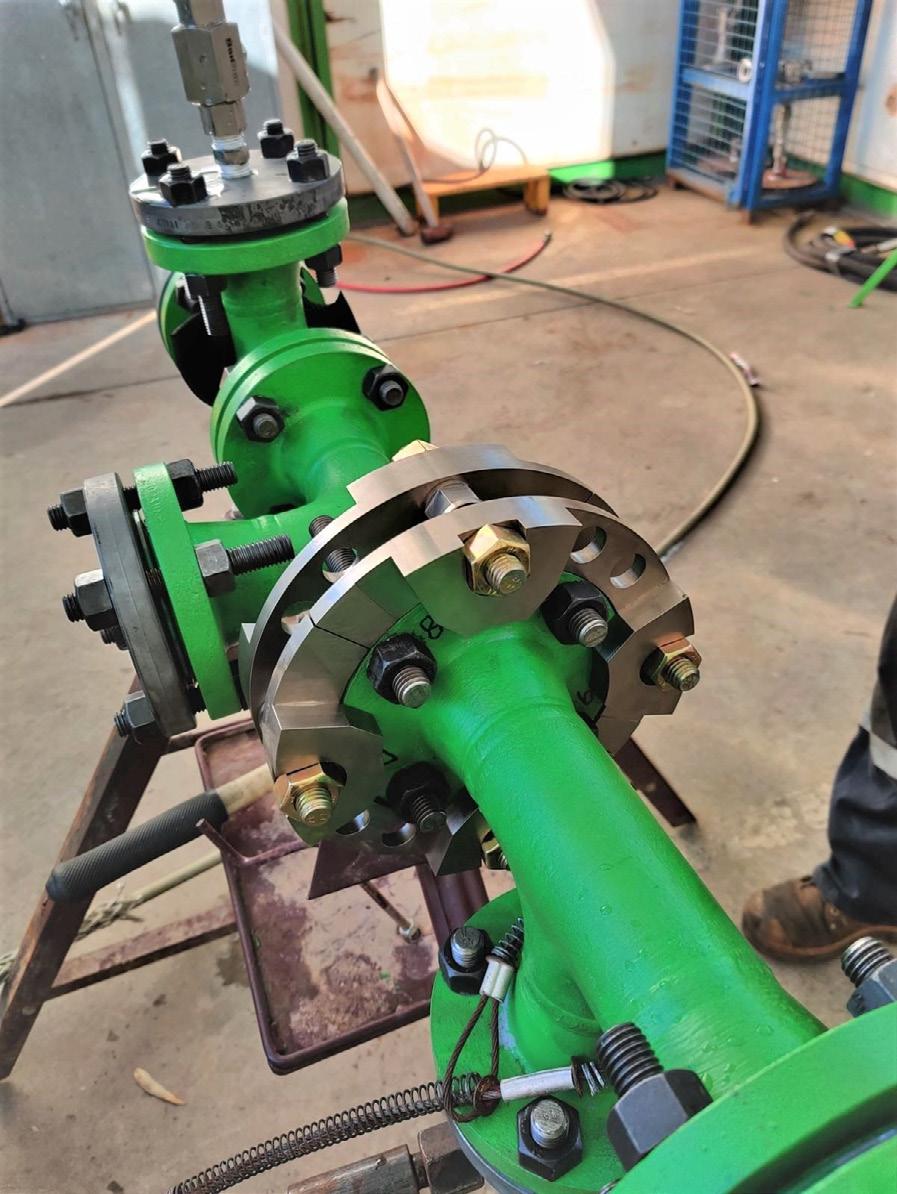

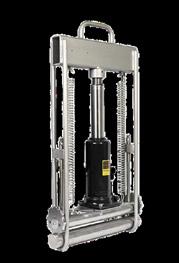


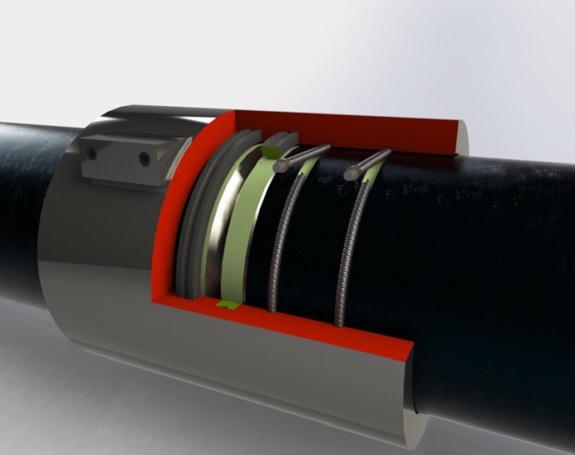


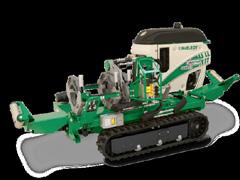
SRJ Technologies Asset Protection Range 1 3 0 0 7 9 4 0 9 6 w w w . p s s s a . c o m . a u s a l e s @ p s s s a . c o m . a u PSSS also offers..... Proudly Presents..... Construct ; Maintain ; Preserve Your Pipeline Assets HDPE Tooling & Machinery Pipeline Pigs & Pigging Equipment Pipe Cutting & Bevelling HDPE Butt Fusion

NEW HIGH-TECH ROTARY LOBE PUMPS
Boerger has surprised the world of pumps with a new generation of its BLUEline rotary lobe pumps, the BLUEline Nova, with the high-tech pump available in six sizes and with flow rates of up to 110 m3/h. The German manufacturer promises not only excellent volumetric efficiency but also maximum choice of sealing systems.
Boerger is well-known for its high-quality rotary lobe pumps with flow rates of up to 1,450 m³/h. Presenting the new generation of its BLUEline rotary lobe pumps, Alois Börger, Managing Director of Boerger, said, “The development of the BLUEline Nova has benefited from our 30 years of experience in pump manufacturing. With the help of computer flow simulations and physical test bench hours, we were able to improve the pumps even further.”
Mr Börger said the rotors and casing were made for one another. This newly developed one-piece DIUS rotor ensures an almost pulsation-free pumping at pressures of up to 12 bar, while the wide sealing surfaces of the screw-profile rotor prevents backflow of the medium.
“Boerger has also modified the pump chamber to utilise the dual-lobe rotor to its full potential. The geometry of the inlets and outlets, as well as the wrap angle of the casing, were particularly optimised. We were able to considerably improve the volumetric efficiency of the pump. To this end, we have adjusted the pump chamber to the rotor geometry in a flow-optimised design,” Mr Börger said.
The BLUEline Nova comes in two variants: with or without protection plates and liners. In its clean version, protection plates and liners are not required. The pump with minimum dead space can be cleaned according to the hygiene
procedures, CIP (Cleaning-In-Place) and SIP (Sterilisation-InPlace).
In its tough version, the pump is equipped with protection plates and liners for pumping abrasive media containing solids. With a new innovative fastening system, the ‘tough’ version of the Nova pump ensures the best volumetric efficiency ever achieved in a rotary lobe pump. In case of wear, the protection plates and liners will be replaced quickly and easily due to its MIP® design (Maintenance in Place).
The large seal chamber of the BLUEline Nova provides space for different sealing systems, therefore ensuring connection of external supply systems is possible, and without issues. Different motors can also be selected for driving the BLUEline Nova rotary lobe pump. Upon request, the drive can be directly flanged to the pump and, due to the elimination of the coupling, the unit is now even more compact. In addition, this version does not require a base frame.
Like all Boerger pumps, the BLUEline Nova rotary lobe pumps can be manufactured according to the European ATEX guidelines for use in potentially explosive atmospheres. An API-676-compliant design, production according to the FDA regulations, or a technically tight pump design according to the German TA Luft requirements, round off the various options for versatile applications.
For more information, please visit www.newblueline.com.
UTILITY • NOVEMBER 2021 WWW.UTILITYMAGAZINE.COM.AU 14 NEWS | Sponsored editorial
FLOW OPTIMIZATION SECOND TO NONE
THE NEW BLUELINE NOVA ROTARY LOBE PUMP

The BLUEline Nova sets new standards in pump technology. With or without protection plates and liners – the BLUEline Nova achieves unrivaled volumetric efficiencies.
Made for one another – the newly developed DIUS rotors in combination with the flow-optimized pump chamber ensure perfectly smooth running at pressures of up to 12 bar.
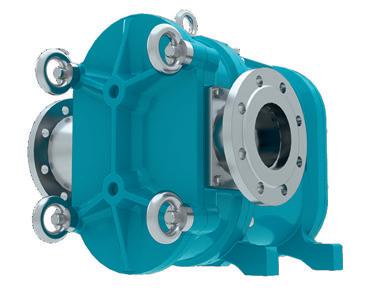
MADE TO LAST
EXCELLENCE –
www.newblueline.com NOVA BLUEline
Boerger Pumps Asia Pte Ltd • 16 Boon Lay Way #01–48 Tradehub 21 • Singapore 609965 • P: +65 6562 9540 • asia@boerger.com
THE KINLEY ESTATE OUTFALL SEWER
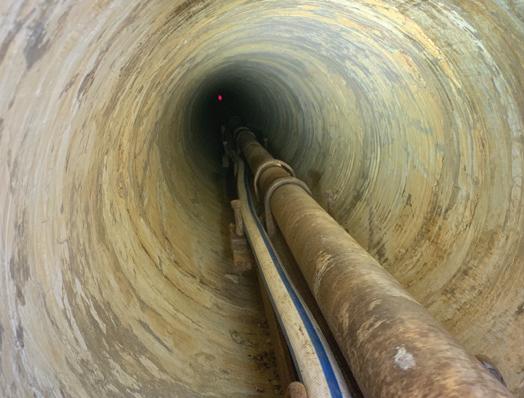
Fulton Hogan’s outfall sewer project in Melbourne’s Kinley Estate overcame several challenges in ground conditions and traffic flow disruption thanks to Pezzimenti Trenchless’ laser guided microtunnelling techniques.
Open cut was not an option for this project due to possible disruption to traffic and residents. The project required full traffic flow during microtunnelling, including residents having access to their properties, and traffic both ways was enabled during the project due to its minimal footprint. Fulton Hogan also had a limited permit to work on the road which meant a very tight program.
Other challenges included groundwater, needing to maintain the very flat grade, and a transition in ground conditions from clay to siltstone, which required a change in
cutters. Pezzimenti also had to drill into the existing sewer line and stop drilling just 300mm away from the existing pipeline.
INNOVATIVE PROJECT SOLUTIONS
In order to overcome these challenging conditions, the project used a laser guided microtunnelling technique. This was due to the depth of the outfall sewer and because the location required the sewer line to be designed along Hull Road in Lilydale and into the existing sewer.
Microtunnelling of 350m of 345mm
OD Clover GRP pipe took place along and crossing Hull Road, into the subdivision, with bore lengths of 50m, 94m, 117m and 89m, and tunneling through ground conditions such as clay and siltstone.
All bores and pipes were installed within a three week window, with depths ranging from 4.5m deep to over 7m in depth, with a design grade of 1:300. Pezzimenti’s experience, expertise and state-of-the-art laser-guided microtunnelling system helped ensure the project was a major success.
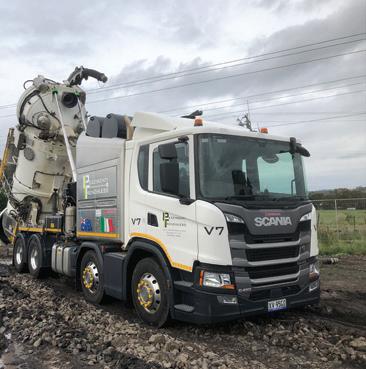


UTILITY • NOVEMBER 2021 WWW.UTILITYMAGAZINE.COM.AU 16
DELIVERING
NEWS | Sponsored editorial Unit 2 / 85 Heatherdale Road, Ringwood Vic 3134 PO Box 2500, North Ringwood Vic 3134 P: (03) 9872 4596 | F: (03) 9872 3293 | E: info@pezztrenchless.com.au Still the market leaders in laser guided microtunnelling Bore diameters from 325mm up to 2800mm Used for gravity sewers, water mains, storm water, gas and electrical conduits. Specialists in “free bore”, sleeve boring and pipe jacking in all sizes The Next Generation in Trenchless Technology
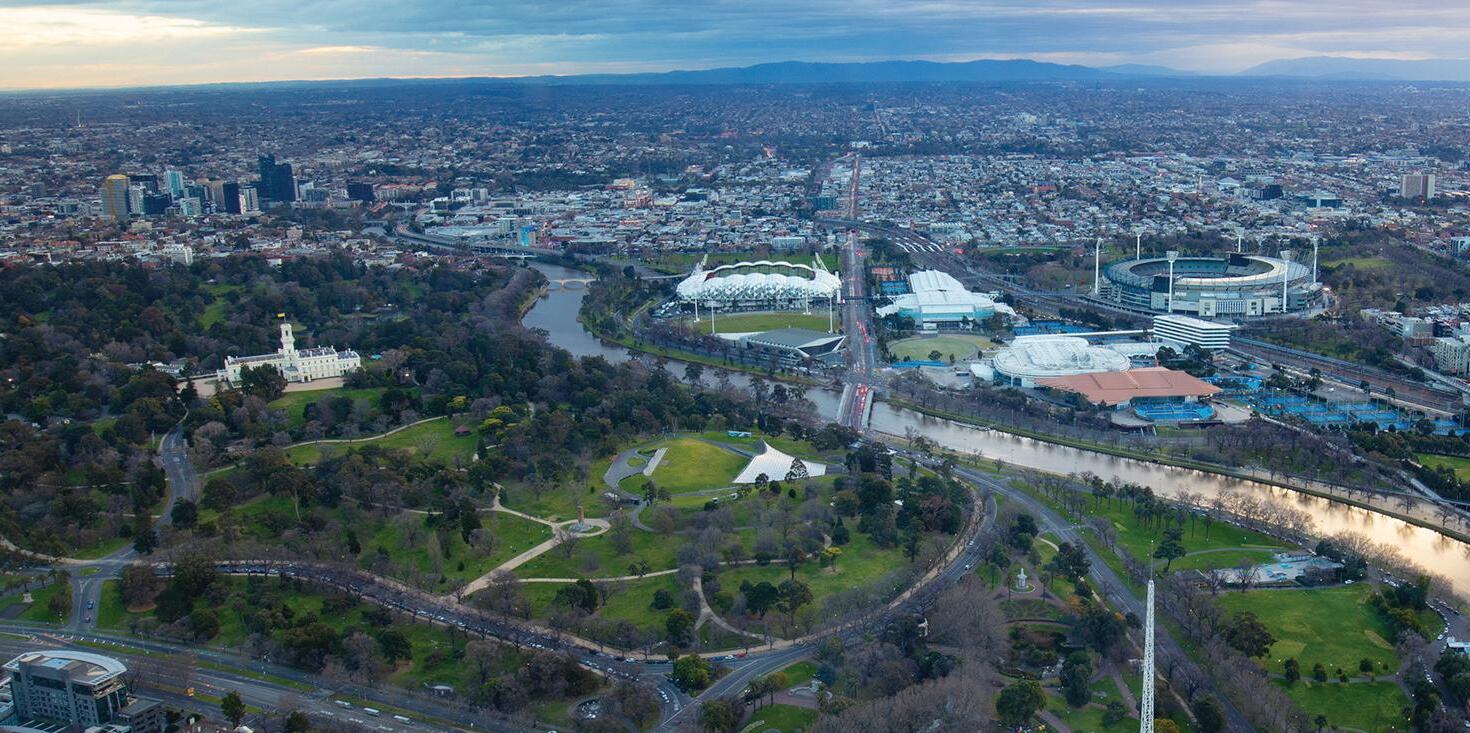
iota.net.au
The IoT platform, fit-for-water.
TECHNOLOGY GIVING UNDERPERFORMING SEWERS A SECOND CHANCE
In areas that have a large quantity of restaurants, fats, oils and greases (FOG) are an ongoing issue to be dealt with, and if left to worsen, can create an underperforming sewer catchment that requires costly surcharging and maintenance.
That’s where the FLUSHER II and its cutting edge technology can help, providing a super simple solution, designed to maintain the serviceability of underperforming sewer catchments.
The FLUSHER II is a unique patented flush generating flap valve, that is designed for cleaning and maintaining drains and sewers.
FLUSHER II reduces effluent for a short period at a predetermined hydraulic head, then an automated gate releases a high-volume, lowpressure column of effluent through the catchment network, scouring and mobilising sediment downstream,
which will prevent future silt build up and FOG blockages.
THE SAFER WAY TO CLEAN SEWERS
The FLUSHER II upstream velocity, which will encounter significant increases, can be controlled by adjusting the equipment, ensuring the right effect can be achieved easily.
By storing and then suddenly releasing the natural flow present in drains and sewers, the FLUSHER II generates an enhanced hydraulic flush energy.
This energised flush action repeats continually, without the need for
A passive gate device for controlling and maximising hydraulic flow in sewers
• Reduces operational costs
– No more water jet sewer cleaning
– No more Silt & Debris removal
– Less surcharge & blockages
• Installed in Maintenance Holes
– Easy to install
– Easy to maintain
– For DN150 to DN450 sewer pipes
• Resistant to rag jamming and blocking
• Inherently “fail safe” during storms
• Data Logger and Telemetry Module
– Know what’s happening and when
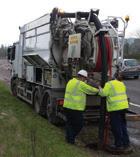

power, jetting costs, or a hefty carbon footprint.
In comparison to the sewer cleaning method of water jetting, the FLUSHER II can be a much safer alternative, as there is no physical work needed after installation, and because it eliminates generation and release of contaminated water droplets and aerosol.
FLUSHER II is designed for optimal benefit in problem areas and keeps maintenance costs down.
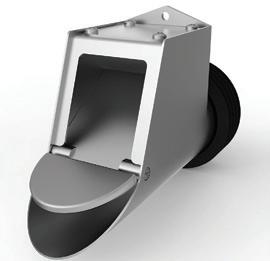
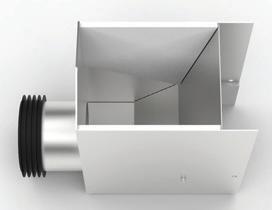
enquiries@aussietrenchless.com
www.aussietrenchless.com
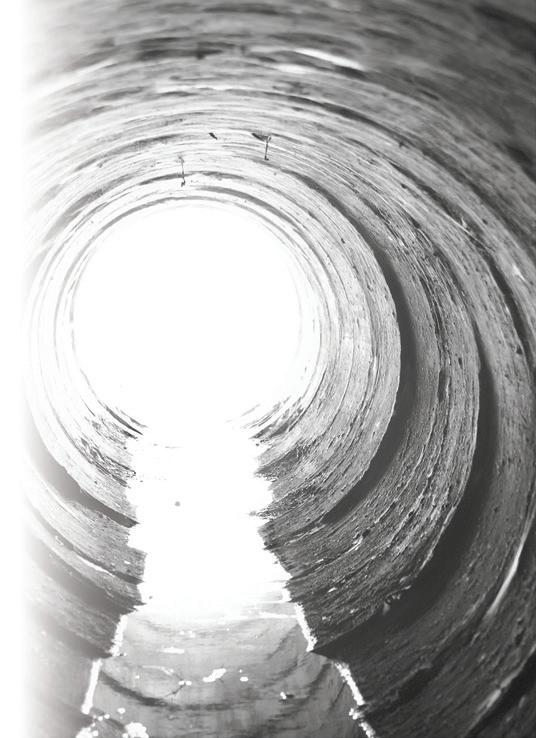
UTILITY • NOVEMBER 2021 WWW.UTILITYMAGAZINE.COM.AU 18
NEWS | Sponsored editorial
FLUSHER II +61 418 691 989
2229 Australia
6/58 Box Road, Taren Point NSW
more about
To find out
the FLUSHER II, visit www.aussietrenchless.com
PROVIDING SOLUTIONS FOR:
• Municipal Sewage Treatment
• Commercial & Industrial Estates
• Government Projects
• Residential Developments
• Urban Subdivisions
• Resorts & Caravan Parks
• Mining Accommodation
• Airports & Infrastructure
• Service Stations
• Defence Assets



1800 057 771 | truewateraustralia.com
SEWAGE & WASTEWATER SPECIALISTS
• DESIGN • MANUFACTURE • INSTALLATION • MANAGEMENT
us about our CONNECTmi® and TELEmi® products for dynamic real time Asset and Management.Monitoring
CONSULTANCY
Ask
RENEWABLES AT A GLANCE:
AUSTRALIA'S BIGGEST UP-AND-COMING PROJECTS
 by April Shepherd, Journalist, Utility Magazine
by April Shepherd, Journalist, Utility Magazine
As the impacts of climate change worsen and put Australia's energy future under the microscope, renewables are set to play a significant part in the country’s pathway to a low-emissions future. Utility has collated Australia's most ambitious renewable projects across batteries, bioenergy, solar, wind and hydro, to reveal how the country is making the most of its abundant resources.
As the effects of climate change start to unfold in real-time, Australia is investing in the renewable energy industry.
Australia’s growth of renewable uptake is almost double the global average, with renewable electricity generation doubling over the last decade, and 21 per cent of the country’s total electricity generation coming from renewables in 2019.
The uptake has been driven by solar and wind, with rooftop solar growing a massive 25 per cent in 2019, and largescale solar growing rapidly; contributing to two per cent of all generation in Australia.
According to a recent International Renewable Energy Agency (IRENA) report, Renewable Capacity Statistics 2021, Oceania’s renewable growth rate was the highest in the world, boasting a 18.5 per cent rise – in comparison,
Europe had a six per cent rate and Asia 15 per cent.
Renewable energy uptake will play a significant role in the transition of the National Electricity Market (NEM) to creating sustainable, clean and reliable energy.
BIG BATTERY POWER
Big batteries are playing a crucial role in the transition to renewable energy, by acting as the ‘power banks’ of the energy world.
Traditionally, coal, gas and hydro energy have provided the grid with stability, using frequency control and inertia. Inertia is supplied by energy sources that have large rotating rotors, acting as a defence for service disruptions, because if the power source wanes, the rotor will keep spinning.
However, as these types of energy suppliers reduce in the grid, so does the grid’s back-up storage.
Battery Energy Storage Systems (BESS) provide a backup supply for renewable energy sources, overcoming the problem of intermittent supply when it is not sunny or windy. When conditions for renewables are ideal, BESS can store excess power created for use when conditions are not as good, or when service is in demand.
THE VICTORIAN BIG BATTERY
The Victorian Big Battery – a 300MW battery the size of a football field in Geelong – began in 2019 and is set to be one of the biggest batteries in the world.
The project is a collaboration between French renewables company Neoen and Tesla Megapack technology – a modular system that is high-density
UTILITY • NOVEMBER 2021 WWW.UTILITYMAGAZINE.COM.AU
20 RENEWABLES
and designed for grid-scale commercial projects, allowing the project to be installed quickly.
The Tesla battery Megapacks are pre-assembled with battery modules, bi-directional inverters, a thermal management system, controls and an AC main breaker, in the one enclosure.
The project’s timeline:
• 2019-2020: Development stages, involving meeting landowners, choosing a site, designing and gaining government submission approval and ensuring the battery has a grid connection agreement and suitable finance
• 2021: Construction stage (estimated to take around ten months), received the battery equipment during May, June and into August, construction including building, testing accreditation, grid connection and storing and discharging electricity, with both 180 MVA 220/33kV transformers energised
• 30 July 2021: During initial testing a megapack caught fire, but the site was electrically isolated and emergency services called
• 2 August 2021: Megapack doors removed for temperature check and the site was declared under control. Investigators state that the cause was most likely a leak within a cooling system in a megapack
• 29 September 2021: Reenergisation testing set to recommence after investigations by experts from Victoria state groups concludes
• End of 2021: (to be officially confirmed) Operations to begin, estimated to be active for 20 or more years
The project aims to boost renewable capacity in Victoria, in line with the state’s targets of 40 per cent renewables by 2025 and 50 per cent by 2030.
The battery also acquired a grid-services contract with AEMO, unlocking 250MW peak capacity for the Victoria-NSW Interconnector, and partnering with AusNet, who will provide the connection for the battery.
BIOENERGY
Bioenergy, or energy from waste, is a form of renewable energy that generates energy from converting biomass into heat, biogas, liquid fuels and electricity.
Biomass resources are organic and come from forestry, agriculture or waste streams that are available on a renewable basis – the process often creating byproducts that can be used in other ways, such as biomassbased concrete.
Biomass conversion technologies include combustion, gasification, transesterification, pyrolysis, anaerobic digestion and fermentation, or linked to biorefining processing. The benefits of bioenergy include reduced emissions, waste disposal, and improved air quality.
• 2019: Construction underway
• 2020: Major foundations and civil components completed and the mechanical erection of boiler steelwork well-advanced, installing combustion grates for the two boiler lines (part of technology supplied by Keppel Seghers)
• 2021: Project is moving into its critical stage of boiler water wall installation; prefabricated elements that contain water and steam piping to receive heat from the waste combustion process
• 2022: The project was originally set to be completed by the end of 2021, but has been re-forecast to be finished by the second half of 2022
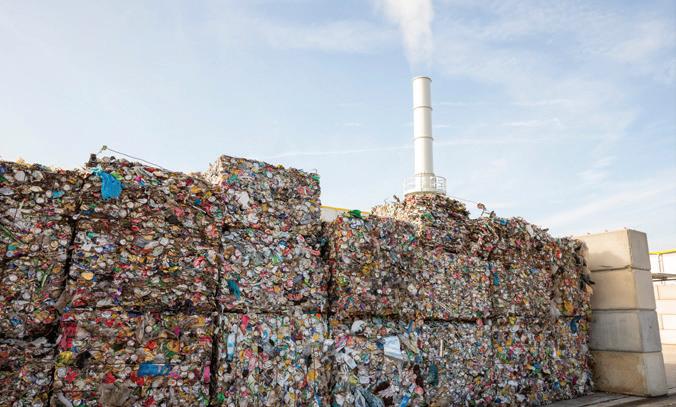
THE KWINANA WASTE-TOENERGY PROJECT
The waste-to-energy (WtE) project in Kwinana, an industrial hub located 40km south of Perth, is an emerging waste facility.
The waste-to-energy project will use Keppel Seghers (the environmental technology arm of Keppel Corporation) moving grate technology to thermally treat waste and convert the energy recovered from the process into steam, producing electricity.
Some materials will be recovered in the process, such as metallic objects, which will be recycled, and other materials will be reused in construction.
The project’s timeline:
• 2018: The project received financial closure in October with Avertas Energy
The project will be the first wasteto-energy facility on a utility-scale in Australia, aiming to divert around 25 per cent of Perth’s rubbish (postrecycling) to landfill sites.
The waste-to-energy project is aiming to export 36MW of energy to the local grid on a yearly basis, which could power 50,000 houses.
The project will avoid 400,000 tonnes of carbon dioxide being emitted yearly, similar to taking 85,000 cars off the road.
SOLAR POWER
Solar energy is Australia's most popular and well-known renewable power source as it is accessible and abundant. It is easy to think of solar as the country’s face of renewables.
Solar energy is a relatively simple process compared to other
UTILITY • NOVEMBER 2021 WWW.UTILITYMAGAZINE.COM.AU
21 RENEWABLES
renewables; solar panels convert sunlight into direct current electricity and solar inverters convert this electricity to alternating current power. If a household or business has its own rooftop solar panels, it can run off this power, and even sell electricity to the grid.
THE AUSTRALIA-ASIA POWER LINK (AAPOWERLINK)
The AAPowerLink will build the world’s largest solar farm and world's biggest battery storage facility, located in the Northern Territory. The AAPowerLink plans to deliver a 5,000km transmission system to not only supply Darwin with competitively priced renewable electricity, but Singapore and Asian markets as well. Energy will be generated by a 14GW solar farm with 33GWh battery energy storage, located near Elliott, in the Northern Territory. Energy generated at this facility will be transmitted 800km to Darwin and then 4,200km via undersea high voltage direct current (HVDC) transmission networks to Singapore.
The project timeline:
• June 2019: Project announced
• July 2019: Project awarded granted Major Project Status by Federal and NT Governments
• January 2021: Northern Territory Government and Sun Cable sign the Project Development Agreement (PDA)
• August 2021: Proprietary optimisation software for the entire AAPowerLink system, including the Singapore and Darwin electricity markets is developed, completed the 750km Australian section of the subsea survey, and appointed PwC as Project Advisory Partner
• October 2023: Financial close and construction to begin
• 2027: Commercial operations to commence
The AAPowerLink project is valued at over $30 billion, and will include 3,750km of HVDC submarine cables, 14,000 MW of solar arrays, 3GW of dispatchable electricity, and aims to supply up to 15 per cent of Singapore’s total electricity needs.
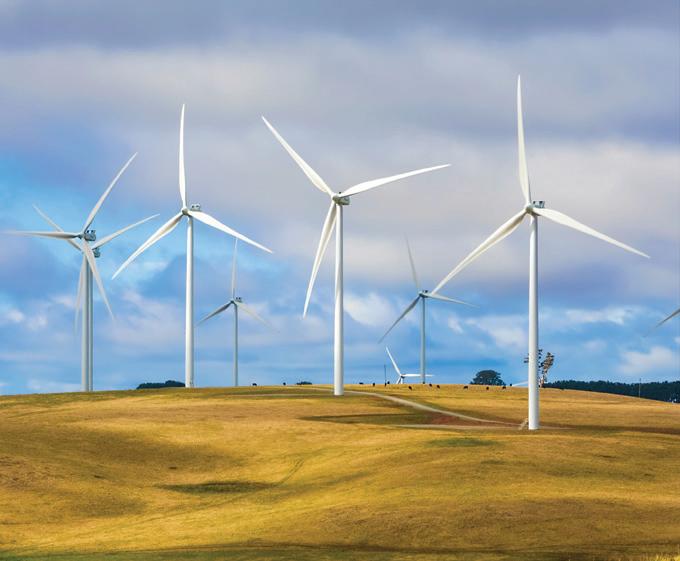
WIND
Alongside solar, wind is one of the most well-known sources of renewable energy, with the use of wind energy beginning in Australia in 1987.
Wind power is one of the cheapest forms of energy to produce, and now makes up eight per cent of all electricity generated in Australia (as of 2019) and 35 per cent of all renewable energy in the country, with the Australian Clean Energy Council (AEC) stating that there is approximately 6,279MW of installed wind power capacity in Australia.
The Federal Government has also recently passed new legislation, The Offshore Electricity Infrastructure Bill 2021, to establish a framework for the construction, operation, maintenance and decommissioning of offshore electricity transmission and generation projects.
The legislation is set to support a wave of investment in offshore electricity generation and transmission projects, including offshore wind farms – boosting opportunities for renewables.
RYE PARK WIND FARM
Set to be the biggest wind farm ever built in NSW, Rye Park Wind Farm will be located near the small southern tablelands town of Rye Park, near Yass.
The Tilt Renewables project reached financial close in August 2021 and will
be located on a ridgeline positioned at a right angle to the prevailing wind, providing optimal wind conditions. The farm will be connected to the NEM through Transgrid's 330kV Yass to Gullen Range Line, by building a new 330kV connecting substation.
The project timeline:
• December 2020: Tilt Renewables announces that the offtake agreement with Newcrest Mining for the supply of electricity and green products for a 15 year period from the Rye Park Wind Farm has been finalised
• August 2021: Project reaches financial close
• End of 2021: Construction to commence
• 2023: Operational (to be officially confirmed)
The project will create around 250 jobs during construction and a further ten long-term jobs during operation, with plans to be operational not long after the Liddell Power Station closes in 2023, according to Tilt Renewables Chief Executive Officer, Geoff Dutaillis.
HYDROPOWER
Hydropower, or hydroelectric power, is one of the oldest forms of renewable energy, using the natural flow of water and converting this movement into electricity.
UTILITY • NOVEMBER 2021 WWW.UTILITYMAGAZINE.COM.AU
22 RENEWABLES
Hydropower has been used for thousands of years, typically using the techniques of hydroelectricity and Pumped Hydro Energy Storage (PHES) for generation and storage.
Hydroelectricity typically involves reservoirs or dams, where water can pass through a generator, called a turbine, setting the blades into motion and turning this motion into energy.
PHES can store large amounts of electricity for a long time, and focuses on storage of energy and reliability for consumers. It does this by using excess energy, possibly from a renewable source such as wind, to pump water from lower dams to higher ones, storing energy in the upper reservoir (much like a battery).
This energy can then be released, creating hydroelectricity at any time, which is critical to ensure power reliability and avoiding blackouts.
SNOWY 2.0
Snowy 2.0 is a pumped hydro expansion of the original Snowy Scheme, completed in 1974, and the largest committed renewable energy project in Australia.
Located on the Snowy Mountain Scheme in NSW, in the Kosciuszko National Park, the 2,000MW expansion will link the two existing dams on the mountain; Tantangara and Talbingo, with 27km of tunnels, whilst also building an underground power station one kilometre beneath the mountains.
The new power station has turbines that are reversible, meaning that the water can be pumped back to the top dam, reusing it to create reliable clean energy on-demand. This is especially important as solar and wind electricity increases and large scale storage, like Snowy 2.0 will be required.
The project will supply 350,000MW hours of large-scale storage, enough to power 500,000 homes at once and be able to deliver electricity to the grid within ninety seconds.
The project timeline:
• 2017: Snowy 2.0 announced, feasibility study commenced and publicly released, geotechnical investigation program began
• 2018: Snowy 2.0 declared a Critical State Significant Infrastructure by the NSW Government, final investment decisions (FID) made and final FID report released
• 2019: Exploratory works approved, principal contractor
Future Generation Joint Venture appointed, construction begins with early works underway at Lobs Hole
• 2020: Construction progresses with concrete tunnel segments underway and permanent bridges and tunnel portals in the works, first tunnel boring machine (TBM) arrives on-site
• 2021: Construction continues, TBM called ‘Lady Eileen Hudson’ set to begin excavation
• 2025: First power generated expected
• 2026: Project expected to be completed
The project is partly funded by the Federal Government, who have committed $1.38 billion, with Snowy Hydro to fund the remaining.
Snowy 2.0 aims to help Australia convert its grid to low-emission and renewable energy, whilst creating reliable energy for major cities Melbourne and Sydney.
Ambitious projects like Snowy 2.0, show what Australia's future of embracing renewable energy can look like, providing a solution to one of the biggest hurdles the country has faced when reducing coal energy in the grid; reliability.
These projects will ensure that the country's future low-emission grid has enough storage to support Australia through any disruptions and adverse weather events.
With Australia boasting some of the largest renewable projects in the world, and the potential for offshore renewable generation given the go-ahead, the country's renewables future is bright.

UTILITY • NOVEMBER 2021 WWW.UTILITYMAGAZINE.COM.AU
23 RENEWABLES

REUSING BIOSOLIDS IN THE WASTEWATER SECTOR
24 RENEWABLES
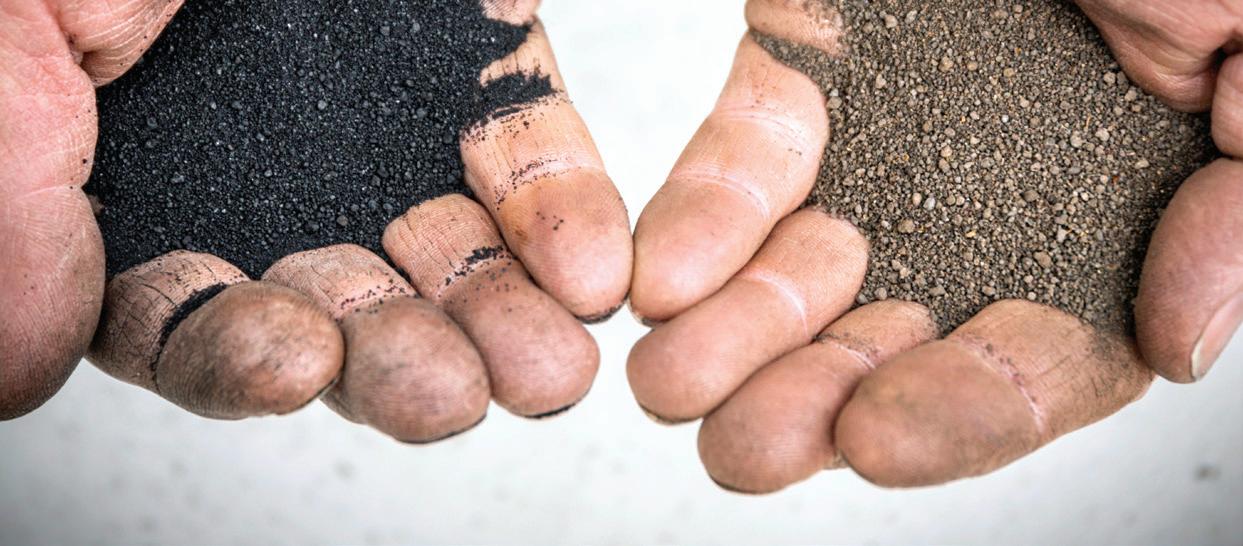
South East Water is involved in a new wastewater management project to transform leftover biosolids headed for landfill into reusable products for farmers.
Developed by RMIT University and the first of its kind in Australia, the innovative technology uses a process called pyrolysis, whereby high temperatures destroy pathogens and microplastics in biosolids to create biochar – a carbonrich form of charcoal for use by farmers and the wider agriculture industry to improve soil health.
Currently around 30 per cent of the world’s biosolids resource is stockpiled or sent to landfill, creating an environmental challenge.
The Biosolids to Biochar project is a circular approach to wastewater management, with the new technology having the potential to eliminate landfill waste across the water industry.
South East Water is helping to deliver the Biosolids to Biochar project in partnership with RMIT University, Intelligent Water Networks and Greater Western Water, with the technology currently in trial at the Melton Recycled Water Plant in Melbourne.
WORKING WITH OTHER INDUSTRIES
Steve McGhie MP, Member for Melton representing Acting Minister for Water Richard Wynne, recently toured Greater Western Water’s Melton Recycled Water Plant for a first-hand demonstration of the new technology.
“This collaboration will enable the water industry to find alternative markets for biosolids, reducing waste going to landfill and allowing 100 per cent of products to be reused or recycled,” Mr McGhie said.
“By creating a safe product with a steady supply stream, we’re also providing our farmers and the wider
agriculture industry a product which is completely natural and can improve soil health and fertility. This project is incredibly exciting for both industries and I can’t wait to see the outcome of the trial.”
Mr McGhie said this project is an excellent example of like-minded organisations working together with a shared commitment to sustainable solutions.
“By reusing and adding value to biosolids, we recover local resources, reduce landfill and create renewable energy to reduce our greenhouse gas emissions,” he said.
South East Water's Managing Director, Lara Olsen, said that supporting these kinds of innovative emerging technologies is an important part of South East Water’s commitment towards reduced emissions and a circular economy approach towards wastewater.
“The disposal of biosolids is a challenge across the water industry. South East Water is continually looking for ways we can work with others to create innovative solutions to protect our environment and to help our customers and community.
“This technology is important as it can be scaled to any size, making it a possible solution for both urban and regional water utilities” Ms Olsen said.
TRANSITIONING TO A CIRCULAR ECONOMY
Associate Professor, Kalpit Shah, Deputy Director (Academic) of the ARC Training Centre for Transformation of Australia’s Biosolids Resource, RMIT University, said that developing new ways to squeeze the full value
from waste resources is critical in our transition to a circular economy. He said the Training Centre is thrilled this Australian-first technology has reached full trial stage.
“At the heart of RMIT research are our strong partnerships with industry, and we hope this collaborative trial will enable us to accelerate the translation of our innovation into new homegrown technologies that advance sustainability and make a real impact in water and agriculture,” Professor Shah said.
Maree Lang, Managing Director Greater Western Water said that she is delighted that Greater Western Water is also a part of this project.
“With a growing customer base and one of the largest service regions in Victoria, it’s so important that we find ways to add even more value to the work that we do. This project is an excellent example of like-minded organisations working together with a shared commitment to sustainable solutions,” Ms Lang said.
“By reusing and adding value to biosolids, we recover local resources, reduce landfill and create renewable energy to reduce our greenhouse gas emissions.”
Dean Barnett, Program Director, Intelligent Water Networks (IWN), said IWN is also excited to be part of this innovative technology trial – turning a waste product into a usable resource, which meets its objective of a circular economy for its members and the broader water industry.
The next stage of the trial will involve scaling up the technology, with a dedicated unit in place at a Water Recycling Plant (WRP) over a longer period of time.
UTILITY • NOVEMBER 2021 WWW.UTILITYMAGAZINE.COM.AU
25 RENEWABLES
MINDING THE CITIZEN-UTILITY GAP
When it comes to sustainability, how often do citizens feel connected, obliged or responsible?
Not so long ago, sustainability was seen by many as a peripheral ‘green’ issue, hardly central to our lives. However, that mindset has been changing. Increasingly, people, communities, businesses and governments are choosing to address and adapt to a range of disruptive forces which are now bringing the impacts of mankind’s effect on our planet’s delicate ecosystem to the fore. This is where utilities and policymakers can make a difference and forge deep, empowering relationships with citizens.
At the helm of the sustainability movement are citizens. The traditional views of one-way delivery of services are transforming to a different form of relationship based on engagement and empowerment, bringing both of the key players in the race to net zero, from backstage to front and centre. Utilities are finding new ways to connect and collaborate to better manage precious resources.
At Smart Energy Water (SEW) we make the case for a fully integrated sustainability model through new digital tools to help address the citizen experience gap.
CITIZEN EDUCATION A PRECURSOR TO ENGAGEMENT
Raising awareness and sensitizing citizens around the sustainable development goals remains a critical precursor to their engagement and collective participation. As primary agents of their own development and wellbeing, the engagement and participation of citizens and communitylevel actors is invaluable and can be leveraged for greater action, monitoring, and impact. To save energy and water, utilities need to build on awareness and identify programs meant to promote truly sustainable outcomes. With digital tools and smart platforms enabling two-way communication, citizens can start to feel motivated and encouraged to co-innovate.
ENGAGING CITIZENS ON THEIR OWN TERMS
Engaging citizens as primary change agents enables the development of communities and makes these citizens,

their communities and cities, ‘smart’ across a range of factors. Utilities and governments are starting to encourage ownership of goals, connect citizens with actionable insights for their everyday living, and empower them to hold their governments and utilities accountable to their responsibilities and obligations.
Now, to better manage energy and water, utilities can engage citizens with personalized one-to-one conversations, consistent omni-channel experience, self-service through mobile and web, and get smarter with AI-powered conversational bots and analytics. The utility experience can morph into an everyday ‘living’ experience with people managing their homes, offices, vehicles etc.
EMPOWERING CITIZENS ANYTIME ANYWHERE
Digital is the backbone for the modern-day citizen experience, with smart cities, e-mobility, smart homes and beyond. With intelligent technologies, it has become easier to perfect self-service and communication, in addition to simplifying utilities’ work.
By embracing cloud, AI/ML, mobility, advanced analytics etc. utility providers are set to easily become more resilient and adaptive. The agile innovation comes with leveraging the digital-first approach, vitally important to stay relevant in the current ecosystem. These systemic changes empower the citizens to do more, saving energy and water proactively.
We have begun these journeys with Australian and New Zealand utilities. We’re bringing innovation that’s helping utilities leverage digital tools to transform its customer experience, empowering connected citizen journeys. Utilities are finding it cost and time effective to uplift and execute their engagement strategy by adopting SEW’s Smart Customer Mobile (SCM®) digital CX platform.
It has provided them with an easy and secure way to manage accounts, track usage, get real-time notifications, collect payments, reward sustainable behaviour, support capital works and connections processes, and enable rich personalised experiences for different customer segments. The intuitive UI/UX, offered on mobile apps and the web along with comprehensive prebuilt use-cases, have helped utilities elevate the experiences of both the utility personnel and end consumers.
About Smart Energy Water Smart Energy Water, with its innovative and industry-leading cloud platforms, delivers the best Digital Customer Experiences (CX) and Workforce Experiences (WX), powered by AI, ML, and IoT Analytics to the global energy and water providers. For more information, please visit www.sew.ai.
UTILITY • NOVEMBER 2021 WWW.UTILITYMAGAZINE.COM.AU 26
RENEWABLES | Sponsored editorial

Engage. Empower. Educate.
Engage. Empower. Educate.
Connecting People with Energy and Water Providers
Connecting People with Energy and Water Providers
Powered by AI/ML/IoT
Powered by AI/ML/IoT
Meet Smart Energy Water
Meet Smart Energy Water
Smart Energy Water with its innovative and industry-leading cloud platforms aim to deliver the best Digital Customer Experiences (CX) and Mobile Workforce Experiences (WX), powered by AI, ML and IoT Analytics (IX) to global energy and water providers . We partner with utilities to deliver solutions that are easy-to-use, integrate seamlessly with utility systems, and help build a strong technology foundation that allows utilities to become future-ready, by harnessing the power of digital technologies.
Smart Energy Water with its innovative and industry-leading cloud platforms aim to deliver the best Digital Customer Experiences (CX) and Mobile Workforce Experiences (WX), powered by AI, ML and IoT Analytics (IX) to global energy and water providers . We partner with utilities to deliver solutions that are easy-to-use, integrate seamlessly with utility systems, and help build a strong technology foundation that allows utilities to become future-ready, by harnessing the power of digital technologies.
Our Products
Our Products
Our innovative platforms help our utility clients engage and empower customers, reduce cost to serve, enable business growth and drive operational excellence.
Our innovative platforms help our utility clients engage and empower customers, reduce cost to serve, enable business growth and drive operational excellence.
#1 Digital Customer Experience (CX) Platform (SCM )
(SCM )
#1 Digital Customer Experience (CX) Platform
• Energy Efficiency & Water Conservation
• Energy Efficiency & Water Conservation
• Billing & Payments
• Billing & Payments
• Outages & Service Requests
• Outages & Service Requests
• Electric Vehicle & Smart Home
• Electric Vehicle & Smart Home
• Usage & Comparison
• Usage & Comparison
• Preference & Notification Centre
• Preference & Notification Centre
• Advanced CRM & Marketing Cloud
• Advanced CRM & Marketing Cloud
• Smart Messaging & Chatbots
• Smart Messaging & Chatbots
• AI powered Customer Service
• AI powered Customer Service
#1 Digital Workforce Experience (WX) Platform
#1 Digital Workforce Experience (WX) Platform
• Work Order Mgmt.
• Work Order Mgmt.
• Auto Scheduling & Dispatching
• Auto Scheduling & Dispatching
• Assets & Inventory Mgmt.
• Assets & Inventory Mgmt.
• Training & Learning Mgmt.
• Training & Learning Mgmt.
• Online & Offline mode
• Online & Offline mode
• Safety & Compliance
• Safety & Compliance
• Damage Assessment
• Damage Assessment
• Operational AI & Analytics
• Operational AI & Analytics
• GPS Route Tracking & Optimization
• GPS Route Tracking & Optimization

#1 Leader in Customer Experience Solutions for Utilities
#1 Leader in Customer Experience Solutions for Utilities
Want to know more about our platforms? Our industry experts are here to help.
Want to know more about our platforms? Our industry experts are here to help.
Write to us at info@sew.ai
Write to us at info@sew.ai
AI/ML/IoT Analytics (IX) Platform
AI/ML/IoT Analytics (IX) Platform
• AI powered Customer insights
• AI powered Customer insights
• Energy & Water Analytics
• Energy & Water Analytics
• AI / IoT driven Use Cases
• AI / IoT driven Use Cases
• Programs & Rebates Mgmt.
• Programs & Rebates Mgmt.
• Peak Load Mgmt.
• Peak Load Mgmt.
• Complaints & Violations
• Complaints & Violations
• Leakages & Flow Analysis
• Leakages & Flow Analysis
• Micro Customer Segmentation
• Micro Customer Segmentation
• District Metering Analysis
• District Metering Analysis
ECONOMICAL WATER TREATMENT THROUGH BLENDING
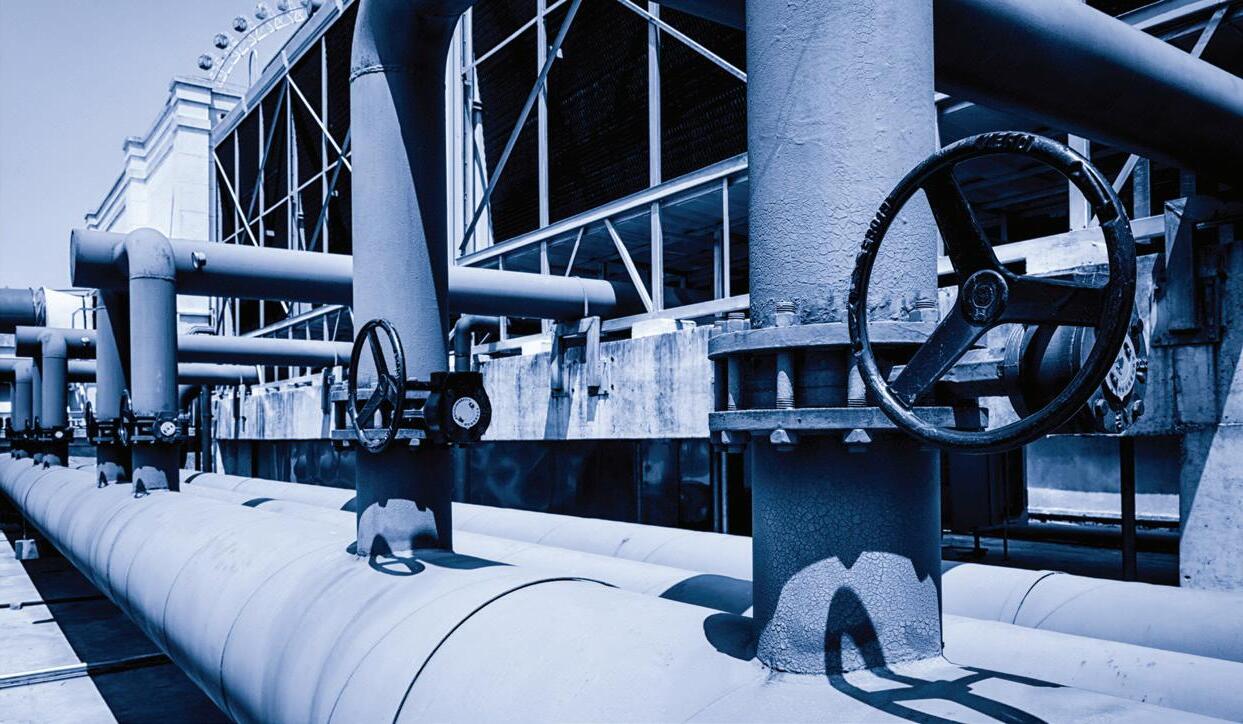
Water conducts and controls industrial processes in industries such as manufacturing and energy generation as well as in heating, ventilation and air-conditioning applications. Before it can be used, it has to be processed appropriately. One technique that is often used consists of blending raw water with processed water until the required quality is achieved, directly in the end user’s plant.
Two basic techniques are used for blending: proportional regulation and qualitative regulation. The type of treatment required determines which technique is best suited in any given case. This depends on the industry and the application concerned. Cooling towers and plant for ventilation technology (AC re-cooling) often require that the degree of hardness, the electrical conductivity, or the sulphate and chloride content be reduced. For irrigation systems in plant cultivation, the salt content is an important factor that needs to be measured to prevent substrate salinisation.
THE WATER TREATMENT TECHNIQUE DETERMINES
THE BLENDING PRINCIPLE
Where reverse osmosis is used to extract salts from water, what results is pure water known as the permeate, and because relatively few ions remain, it conducts practically no electricity. The salt content of blended water can then be determined very accurately by means of a conductivity measurement.
On the other hand, if an ion exchanger is used, knowing the conductivity is of no help because ions are simply ‘exchanged’, the conductivity remains almost the same. In such cases an alternative is needed – if possible, this may be simple proportional blending.
To produce blended water with a particular degree of hardness, both techniques require the raw water quality to remain essentially constant. However, if the raw water
hardness varies, then a combination of proportional regulation and qualitative regulation is needed.
In all cases, the regulation must be carried out exactly and rapidly, and even where boundary conditions change (e.g. variable flow rates), the quality of the blended water must meet the requirements as closely as possible to ensure constant production conditions.
A PRACTICAL BLENDING SOLUTION
Whether the raw water quality is constant or varies –modified blending principles are used. Therefore, the most practical solution consists of stand-alone operation that saves the plant operator from having to intervene in existing plant processes.
Bürkert Fluid Control Systems supply modular blending units that can deal with practically all usage scenarios that may arise. This is where the user profits from a broad product portfolio of components that are designed to work perfectly with each other. Analogue and digital interfaces are available if communication with the process is required.
FAST, ON-SITE INSTALLATION
The pre-assembled module with two infeed connectors and a blended water connector only has to be integrated into the existing water supply, or integrated into the water treatment plant as a pre-wired component solution. The values for the required quality or the blending proportions are pre-set, so the blending unit can be put into operation immediately.
RENEWABLES UTILITY • NOVEMBER 2021 WWW.UTILITYMAGAZINE.COM.AU 28

Industrial water prefer to partner with Bürkert
Using digital technology, Bürkert’s positioners and process controllers have pushed through the barriers of traditional solutions. These positioners are available for linear as well as quarter turn valves (and other pneumatic devices).

Request a quote
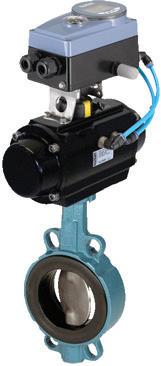
Type 8805
Consists of a quarter turn valve (ball or butterfly) and a pneumatic rotary actuator. Accurate end position setting, high flow values, high medium pressures and long lifecycle for reliability.
A RENEWABLE ENERGY FUTURE REQUIRES LICENCE TO OPERATE
by Kate Healey, Transmission Advocate, RE-Alliance
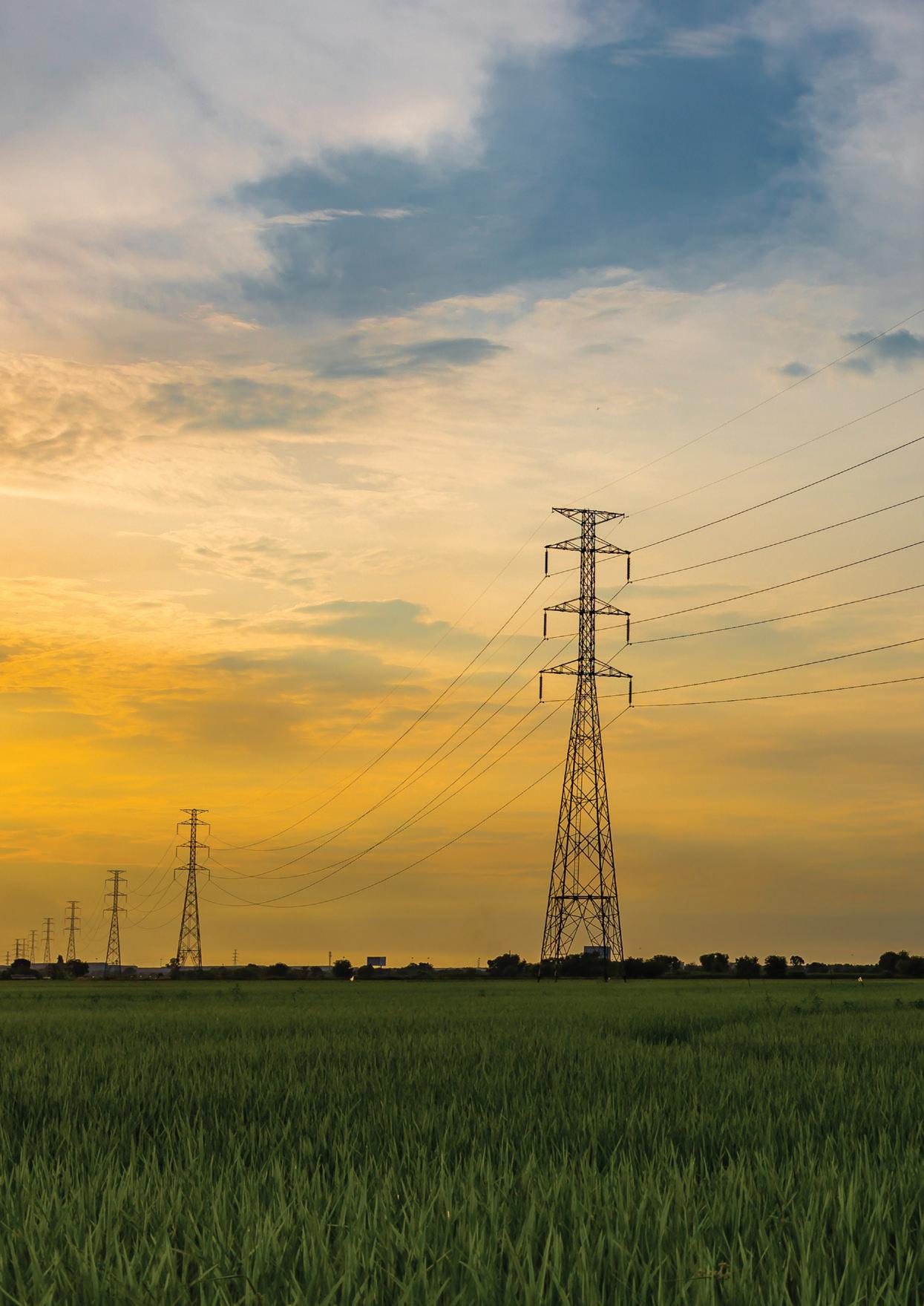
There’s been much talk of the role Renewable Energy Zones will play in Australia’s energy future. But before we can plan and build this critical infrastructure, there is a critical need to work with regional landowners to gain land access and ensure that the critical licence to operate is achieved.
LAND ACCESS
30
Renewable Energy Zones (REZs) will be the power stations of the future. Distributed over a region, solar, wind, pumped hydro and battery projects will collectively become the equivalent of conventional power plants, a reliable source of power that will feed into the National Electricity Market (NEM).
There is keen interest from investors and renewable energy developers to develop new projects in REZs. Recently, the NSW Government opened EOIs for renewable investors wanting to join the New England Renewable Energy Zone, set to host 8GW in total when complete. They received a massive 34GW of project proposals from over 80 proponents.
In light of the IPCC’s recent report, the urgent need for the successful roll out of the REZs has never been clearer. So with State Governments and renewable energy proponents onside, what is causing delay?
THREE BARRIERS TO OVERCOME
To carry the power to our homes, schools and workplaces, we need to build clean energy transmission lines that will connect the REZs to the existing grid. In its 2020 Integrated System Plan (ISP), the Australian Energy Market Operator (AEMO) identified 18 transmission projects worth billions of dollars to “plug in” REZs and transition our grid. So how can we expedite the roll out of this crucial new infrastructure?
There are three hurdles we must overcome.
The first hurdle is the regulatory arrangements for transmission lines. The Regulatory Investment Test for Transmission (RIT-T) is a cost benefit analysis which only includes energy market costs and benefits. It does not include the social or environmental costs borne by local communities. An ongoing problem is the failure of governments to agree to include climate change within the National Electricity Objective which governs the RIT-T.
The RIT-T process takes several years to approve a new project and slows down the pace of the urgent transmission roll out. Frustrated with the length of the process, the NSW and Victorian governments have passed legislation that will allow them to develop their own regulatory investment test in place of the RIT-T. If federal regulators want to retain their role in grid approval, they will need to hurry to outdo the states in developing a system fit for the task ahead.
The second hurdle is cost. Many of the ISP’s 18 projects will cost upwards of a billion dollars, in some cases several billion dollars. Current arrangements see the cost of new transmission lines recovered from all energy consumers through our energy bills. Another option, proposed by Craig Memery of the Public Interest Advocacy Centre (PIAC), is that renewable energy developers who benefit from new transmission lines should shoulder a portion of the cost. Government funding can and should also play a role.
State and Federal governments, as well as the Clean Energy Finance Corporation, have all recently committed hundreds of millions to support the planning and delivery of transmission projects.
The third hurdle is social licence. It's a tall order for farmers and landholders to accept large transmission towers being proposed on their properties. Landholders have little negotiating power in determining route-selection processes. Existing easement payments for landholders are one-off, unlike the annual payments received by wind turbine hosts, which can often be in the tens of thousands of dollars annually, and can be a meaningful droughtproofing mechanism for farmers living through increasingly unpredictable seasons.
COMMUNITY CONSULTATION AND ENGAGEMENT
The impacts of the energy transition should not, and do not, need to be a heavy burden for regional communities. If companies and governments prioritise best-practice community engagement, collaboration, and benefit sharing, regional communities hosting REZs and transmission lines can become beneficiaries.
There are current opportunities for communities to say how the rollout could be made fairer for them. NSW and Victoria are designing their access schemes and their replacement regulatory investment tests now. The AEMC has opened consultation on its Transmission Planning and Investment Review to identify issues with the existing regulatory frameworks in relation to the timely and efficient delivery of major transmission projects.
I recently authored a report, Building Trust for Transmission: Earning the social licence needed to plug in Australia’s Renewable Energy Zones, which recommends expanding landholder compensation and community benefits as follows:
• Earlier landholder and stakeholder communication and consultation during regulatory processes
• Social and environmental impacts are included in transmission line cost benefit processes
• Increased landholder compensation
• Appropriate neighbour compensation
• Community benefit sharing, which may include neighborhood improvement schemes to mitigate environmental and visual impacts and funding for local community groups
These could be funded in a range of ways, including through an expansion of the RIT-T to include social and environmental costs.
RE-Alliance will continue to advocate that the transmission industry use best-practice local engagement and for regulatory changes allowing community benefit sharing to ensure our energy transition is both fast and just for impacted communities.
Kate Healey is RE-Alliance’s Transmission Advocate and has previously worked at Energy Networks Australia and the Australian and New South Wales Governments on energy and climate policy.
RE-Alliance is an independent not-for-profit working to deliver a renewable energy transformation in Australia filled with sustainable, long-term benefits for regional communities.
UTILITY • NOVEMBER 2021 WWW.UTILITYMAGAZINE.COM.AU 31
LAND ACCESS
FLOOD TWIN OF TASMANIA BUILDING A DIGITAL

The devastating 2016 floods in Tasmania claimed lives, caused hundreds of millions of dollars in recovery and reconstruction costs, and changed landforms and river courses forever. Following this event, the Tasmanian Government started a project to improve strategic flooding intelligence for a better understanding of flood risks.
The Tasmanian Flood Map Project, supported by the expertise of WMAwater, SES Tasmania, Indicium Dynamics and Innovyze, was established to develop a digital twin of Tasmania to model current and future flood events and develop the tools to provide intelligence to emergency managers and responders.
Once completed, the project will allow for better community protection planning, land use planning, building tools, community responses, and support the effective investments in recovery – which will increase community resilience during future flood events. This project is a partnership between the Australian and Tasmanian Governments.
EXTENSIVE DATA COLLECTION
Project work includes the improvement of base information for the digital twin, establishment of the strategic modelling environment, production of 0.5 per cent, one per cent and two per cent Annual Exceedance Probability (AEP), a flood history of Tasmania for the 16 most significant recorded flood events, strategic flood maps and detailed flood studies of the most vulnerable locations; in which no contemporary flood studies are available.
A significant output delivered in the project is the development of a composite Digital Terrain Model (DTM) covering all of Tasmania. This involved the collection of over 12,000 square kilometres of new LiDAR data in less than a year. Drone based LiDAR collection for specific areas, merged with existing LiDAR acquisitions collected over the last 12 years, provided an information base of more than 175 LiDAR acquisitions and existing photogrammetric contours, to form two new products, including a ten metre and a two metre Digital Terrain Model for the entire Tasmanian land mass.
COLLABORATION BETWEEN INDUSTRY EXPERTS
The digital flood twin is being developed by WMAwater with support from SES Tasmania, Indicium Dynamics and Innovyze using the Innovyze InfoWorks ICM platform. The decision behind the selection of InfoWorks ICM was the platform’s powerful modelling and data management tools, user-friendly interface and ability to go ‘live’ as the SES develops its capacity. The project’s very large datasets can be easily managed, versioned, updated and maintained over time using the master database system.
WMAwater is a national leader in flood modelling and management. Its technical expertise has been engaged to develop the modelling methodology and all hydrologic and hydrodynamic model outputs. Rather than delivering a static flood map output that would date quickly, the project methodology has been developed so the model input data can be updated as the land profile and asset data changes – preparing the region for a future flood forecasting tool that can be used in real-time with the latest data.
Indicium Dynamics has significant experience in cloud computing, development, installation, and management of real-time data collection in the field, to complement feeds from the Bureau of Meteorology to support the evolution into forecasting projects. It is providing the IT infrastructure and platform support for the project, including setting up automated software deployment and upgrades for improved system management and disaster recovery.
The project continues to raise awareness of flood risk in the state of Tasmania and the benefits of the study will provide support to the community and their wellbeing during future flooding disasters.
Learn more at www.innovyze.com
UTILITY • NOVEMBER 2021 WWW.UTILITYMAGAZINE.COM.AU 32 DISASTER MANAGEMENT | Sponsored editorial
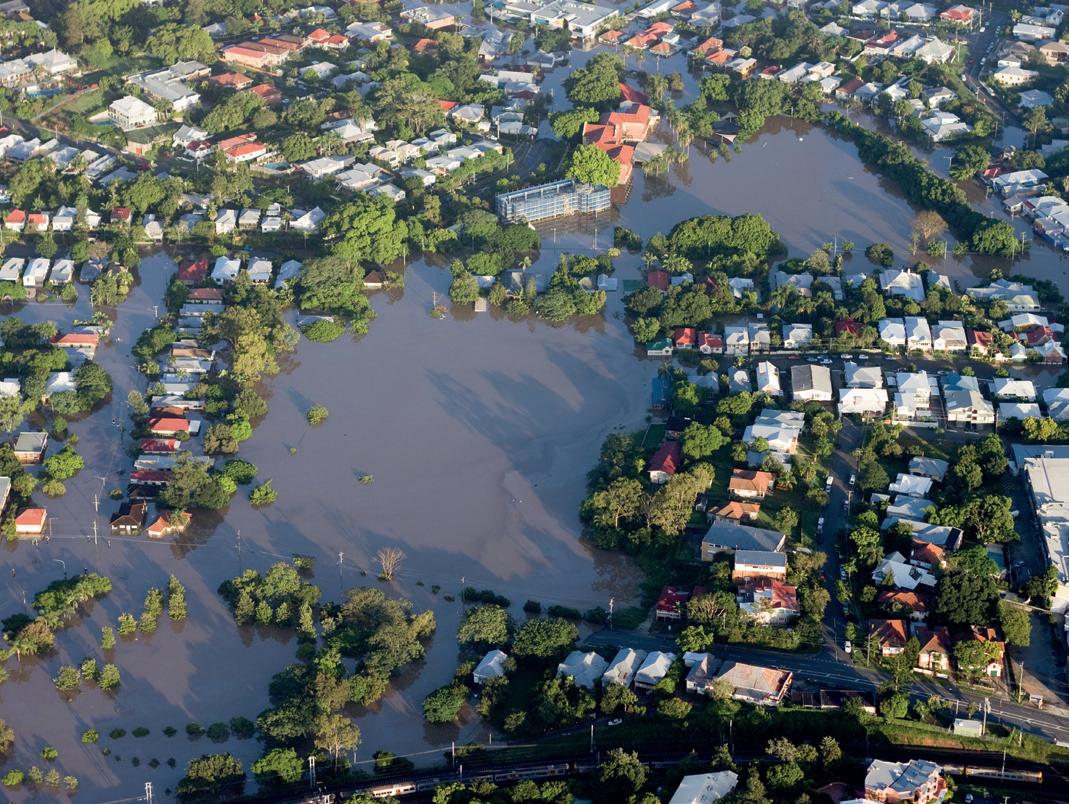
ARE YOU PREPARED FOR FLOOD SEASON?
Manage today, plan for tomorrow. As storm season approaches in Australia, the threat of heavy rainfall and flash flooding increases significantly along with substantial environmental and economic damages that impact individuals and communities.
Monitor, Measure, Prepare with InfoWorks ICM
Improve your flood resilience with advanced integrated catchment modelling software InfoWorks ICM by Innovyze. Trusted by cities and engineering consultants throughout Australia and the world, InfoWorks ICM leads the way in improving the performance of flood control to reduce flood risk and safeguard critical infrastructure.
www.innovyze.com

WASTEWATER SAMPLING:
UTILITIES COLLABORATING TO TRACK COVID-19
by April Shepherd, Journalist, Utility magazine

Wastewater sampling quickly became a key part of tracking the COVID-19 virus Australia-wide, combining research from the past and new fast-tracked methods to fight the pandemic. Water Research Australia tells Utility how collaboration made this project possible and the lessons learnt along the way.
DISASTER MANAGEMENT 34

Water Research Australia (WaterRA) members’ wastewater sampling and surveillance methods have been used to detect COVID-19 in Australia since the pandemic began, through the Collaboration on Sewage Surveillance of SARS-CoV-2 (ColoSSoS) project.
WaterRA developed the ColoSSoS project within four weeks of COVID-19 being declared by the World Health Organization (WHO) as a global pandemic, making an invaluable contribution to public health.
WaterRA has a 20-year track record of facilitating and delivering water-related research for members such as water utilities/agencies, health regulators, laboratories, and universities – with a heightened focus on water, wastewater, recycled water, and related innovative research.
The project is a result of WaterRA’s uniquely positioned organisation and longstanding research history, steeped in collaboration in the space of water and health – aiming to aid the pandemic response for members nationally and internationally.
THE DEVELOPMENT OF COLOSSOS
ColoSSoS partners track and monitor the presence of COVID-19 in the Australian sewerage network, detecting areas where cases have visited and live.
The project was born as the COVID-19 virus began, on 4 February 2020 – just weeks after the first case of coronavirus was detected in Australia on 25 January 2020 and before lockdowns, or stay-at-home orders as they were first known, began.
Dr Kelly Hill, the Project Director of ColoSSoS, said the project started when WaterRA and its members gathered, pulling together the first coronavirus fact sheet for the water industry.
Dr Hill said the group decided on research priorities to focus on, such as finding a simple way to discover if the virus can be found through wastewater monitoring when the virus is being shed by infected people in an outbreak situation.
“A project initiation was created in March 2020, while the actual national collaboration was an evolving project development process – we were building the plane while flying it – so to speak,” Dr Hill said.
“Within a week, an initial project governance map was created outlining working groups and mechanisms. Industry-wide workshops were held by WaterRA including our member organisations, and within two weeks, four working groups were developed each with objectives.
“This continued to evolve into the state node structure to ensure effective turn-around and reduce the likelihood of virus degradation through excessive transportation times.
“By the four-week timeframe there were 20 organisations signed onto the project, and by June 2020 this has grown to over 45 organisations. At its peak the program reached over 50 organisations.”
FOUR WORKING GROUPS
The project moved in four phases: Initiation, Method Development, Investigation and Continuous Improvement (which is exploring the possibility of routine surveillance and early warning potential).
To achieve the four phases, WaterRA created four working groups at the beginning of the pandemic to streamline their response:
• The first was a sampling group, initially featuring around 15 utilities across Australia, three State Departments of Health, and research organisations including Monash University. This then continued to grow with the expansion of sampling sites, more State Departments of Health joining, and inclusion of more water utilities
• The second focused on molecular analysis, featuring Sydney Water Laboratory Services, Australian Water Quality Centre (AWQC), ESR New Zealand, Victorian Infectious Diseases Reference Laboratory (VIDRL), the Walter and Eliza Hall Institute for Medical Research (WEHI), Australian Laboratory Services (ALS), and various department of health, and again grew with the additional State Departments of Health joining, the Commonwealth National Measurement Institute and more pathology laboratories around the country being set up for the testing of wastewater
35 WWW.UTILITYMAGAZINE.COM.AU
DISASTER MANAGEMENT
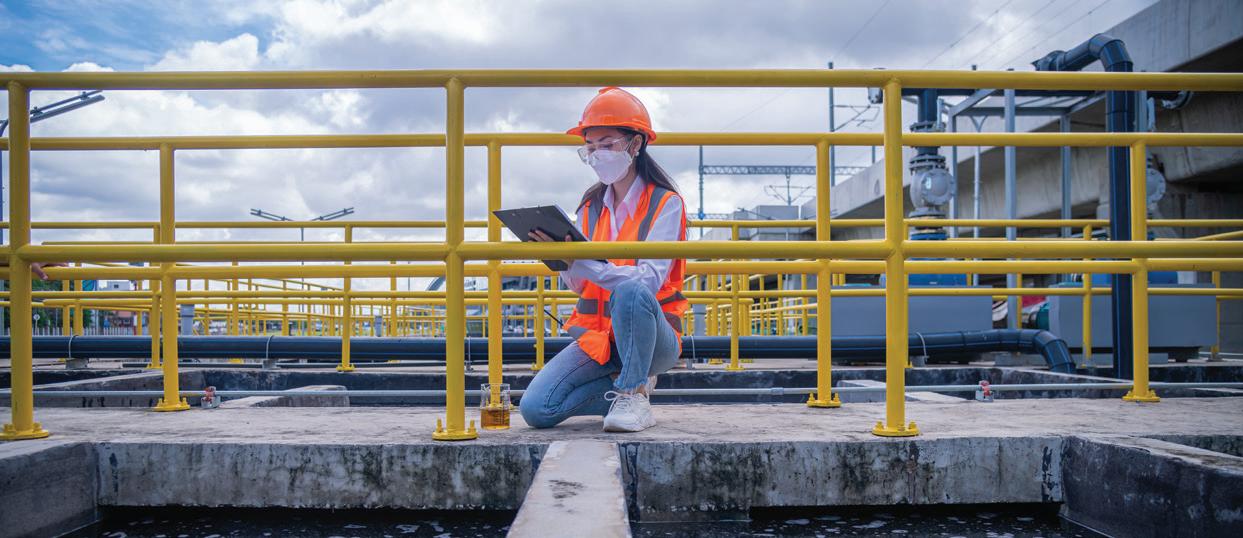
• The third is a data interpretation and integration group, mainly featuring State Departments of Health across Australia and ESR in New Zealand
• The fourth is a communication-focused group, (state health departments collaborating on public messaging of detections and consistency in public messaging), including the University of Newcastle, Water Research Australia and Communications specialists from various water utilities including Sydney Water and Melbourne Water
DEVELOPMENT AND HISTORY OF WASTEWATER SURVEILLANCE
Wastewater sampling to detect viruses has been in use since the 1960s, pioneered by Yale University whilst researching polio vaccinations, paving the way for the wastewater-based epidemiology (WBE) used presently.
Cell culture methods were developed and optimised in the 1980s and provided the basis of the early-years of detection and documenting infectious viruses in water supplies.
The ColoSSoS Project uses the over 20 years of health and water-based research undertaken by WaterRA, its predecessors, and peers, designing wastewater sampling surveillance methods to monitor outbreaks and assist in prevention.
The origins of WaterRA date back 20 years to the Cooperative Research Centre for Water Quality and Treatment (CRCWQT), with public health priorities coming to life in a 1996 CRCWQT project, The Early Detection of Outbreaks of Waterborne Gastroenteritis.
This project aimed to investigate and document a variety of existing surveillance systems relating to the detection of gastrointestinal disease in the community, and assess the feasibility of linking these with water quality data.
The above project set the groundwork for the wastewater sampling and surveillance methods that are used currently.
HOW DOES IT WORK?
Viruses are commonly found in wastewater, with two main types of viruses discovered:
• Viruses that are more resistant with an external protein capsule, such as adenoviruses which can cause bronchitis and pneumonia, as well as polioviruses
• Viruses with a lipid envelope, which is more flexible and known to be more fragile, such as influenza and coronaviruses – including SARS-CoV-2
Several research initiatives fast-tracked the development of the ColoSSoS projects, including sampling, extraction, storage, molecular analysis, and epidemiological interpretation.
Dr Hill said the project team learnt very quickly how to implement the resources they already had set up, how to utilise these to get results quickly, and that state-based health departments driving the developments were aiding the innovative methods and positive impact this information could have.
“Utilitising the expertise of WaterRA and Project Manager Dr Daniel Deere by selecting laboratories with existing accreditation/routine analysis expertise meant rapid and highquality information could be passed to the COVID response teams in each state,” Dr Hill said.
As the Delta variant of COVID-19 unfurls worldwide, the sampling and detection process remains relatively the same.
“The different variants being detected in wastewater are being detected through whole genome sequencing of the wastewater sample following a positive polymerase chain reaction (PCR – considered the standard for testing) detection,” Dr Hill said.
LESSONS LEARNT: FIGHTING PANDEMICS WITH COLLABORATION
Dr Hill said that one of the biggest takeaways from the project was the power of collaboration between utilities, health departments and laboratories, and what they could achieve in a short period of time.
“Collaboration of the right organisations and across disciplines is hugely beneficial. The history of WaterRA bringing together health, utilities and research organisations was a lucky coincidence that meant we could utilise the existing trusted networks to rapidly implement a useful collaboration,” Dr Hill said.
The magnitude of the situation inspired many to help, with one of the largest challenges of the project being the need to collaborate with the right utilities at the right time.
“When it comes to a pandemic response for public health, organisations without expertise often try to help out of goodwill – this is helpful later on, but can distract from the direction of urgent implementation,” Dr Hill said.
Once the system was up and running, the project faced another challenge; tracking the virus, whilst keeping confidentiality and effective public communication at the forefront of the discussion.
UTILITY • NOVEMBER 2021 WWW.UTILITYMAGAZINE.COM.AU 36
DISASTER MANAGEMENT
“At the beginning there was a huge emphasis on confidentiality by the health departments to allow them to interpret the wastewater data and to integrate it with clinical, case number and local jurisdiction data. This ensured the most appropriate response to wastewater data was being incorporated into COVID response plans and being communicated to the public effectively by the health departments,” Dr Hill said.
DEVELOPMENTS AND IMPROVEMENTS

As the virus evolves, so does the technology used to track it. Dr Hill and her team are constantly focused on how systems can be improved, and which areas should be the focus of future research.
“Virus detection in wastewater has been around for decades. We are working with our partners to improve on sampling methods, understand the potential benefits and risks of using passive samplers in the wastewater system, comparing them to auto samplers, grab sampling and testing their efficacy in various wastewater matrices,” Dr Hill said.
“Wastewater is a very difficult matrix to understand and work with, as it can vary from location to location, and throughout different times of the day.”

“This will be increasingly important as a toolbox for variant detection in future months as borders open and maintaining an understanding of variant movement throughout the community could be critical,” Dr Hill said.
As the future of our relationship with this virus develops, Dr Hill said maintaining laboratory expertise and proficiency will be prioritised.
“We are in the process of developing a second round of inter-laboratory proficiency tests which will incorporate aspects of variant detection and inhibition reduction,” Dr Hill said.
THE FUTURE OF THIS TECHNOLOGY
As we learn to live with COVID, Dr Hill explains how this technology could be used for other uses besides COVID – from drug testing to capturing an overall snapshot of public health.
“Into the future there is the potential for this type of work to be integrated with the wastewater surveillance of drugs (such as that being conducted by the Australian Crime Commission) and surveillance of other contaminants (i.e. perand polyfluoroalkyl substances and anti-microbial resistance) to provide an overall picture of population health,” Dr Hill said.
Dr Hill said that developments in whole genome sequencing, and how this could be used to provide certainty against PCR assays for variant detection will be a priority, especially as new variants of the virus start to evolve.
The work Dr Hill, her team and countless Australian utilities and other organisations have done, and continue to do, has not just been pivotal to the way the country has tracked the virus, but saved lives – showing the true power of collaboration in the utility sector.
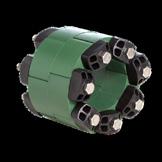
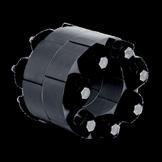

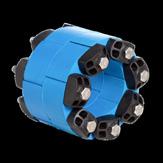
Link-Seal offer hundreds of solutions to seal pipe penetrations ranging in size from 10mm to 3.6 meters diameter.
Link-Seal are suitable for most types of pipes including PVC, HDPE, Copper and Steel
Resistant to water, oil, gas, aggressive chemicals and fire
Projex Group helps calculate the right Link-Seal size and model for your application Link

UTILITY • NOVEMBER 2021 WWW.UTILITYMAGAZINE.COM.AU 37
rat
-Seal Pipe Penet
ion Seal Solutions
114
@projex com au DISASTER MANAGEMENT
1800 001
mail
NEW TECHNOLOGY TRANSFORMS RESILIENCY READINESS
Hardening a power grid is a necessary but complex undertaking. Bringing the right resiliency assessment tools to bear can simplify and accelerate the process.
When Cyclone Seroja landed in April, it damaged 70 per cent of buildings in the towns of Kalbarri and Northampton. It also changed the conversation about how Australians prepare for catastrophic weather events. A team from James Cook University’s Cyclone Testing Station has recommended changes to regulations and building codes as destructive storms land ever farther south. Inevitably, the utility industry will also have to come to terms with the reality of increasing climatic uncertainty.
Whether recovering from one disaster or anticipating the next, cost-effectively enhancing the resilience of power grid structures begins with an accurate assessment of existing infrastructure health. That includes literally seeing all structural elements to assess possible weaknesses.
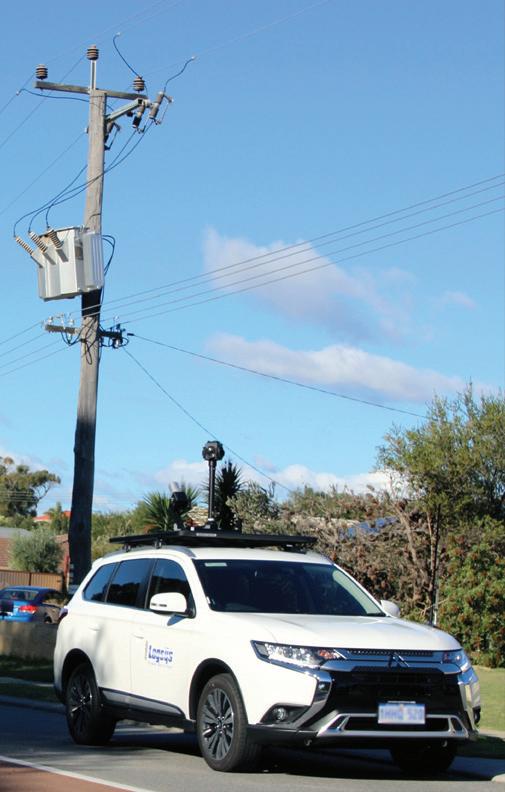
OsmoVision® offers an unmatched suite of cutting-edge hardware and software that can document power grid vulnerabilities and strengths like no other. This removes the need for inaccurate, labour-intensive, slow and costly measurement though calibrated pixel counting.
OsmoVision utilises a combination of proprietary LiDAR point cloud classification and imagery recognition tools to generate an accurate digital twin of utility structures. This turnkey LiDAR collection and processing system leverages the accuracy and repeatability of measurements and minimises potential data entry errors to improve accuracy, consistency, and efficiency of structural engineering analysis both at the individual structure level and when analysing entire lines.
The digital twin generated by OsmoVision enables the assessment of system resiliency by simulating its ability to withstand high-impact events. This will determine which areas of a structure above ground are more resilient and which areas are at risk of failure during a high-impact event, such as a cyclone.
To address points of poor resiliency, various hardening solutions are then simulated to support the determination of the best approach. Both resiliency analysis and pole owner business KPI’s are factored in during the hardening solution development, and the expected resiliency improvement is defined clearly for each critical KPI.
When planning for severe weather, an additional advantage of having a digital twin is the ability to anticipate the required equipment, staff, and materials needed for recovery and also where it will be required. This helps prioritise placement and staging of response-related inventory to reduce downtime after an incident.
In addition to the benefits of OsmoVision’s advanced technology, Logsys Power Services brings the expertise to support the structure owner’s decision making in matters of resiliency. Whether the need is to develop a plan and budget to implement a hardening solution, or to forecast the degradation of assets and its impact on resiliency, Logsys Power Services has experienced engineers, project managers and data scientists to answer those critical questions.
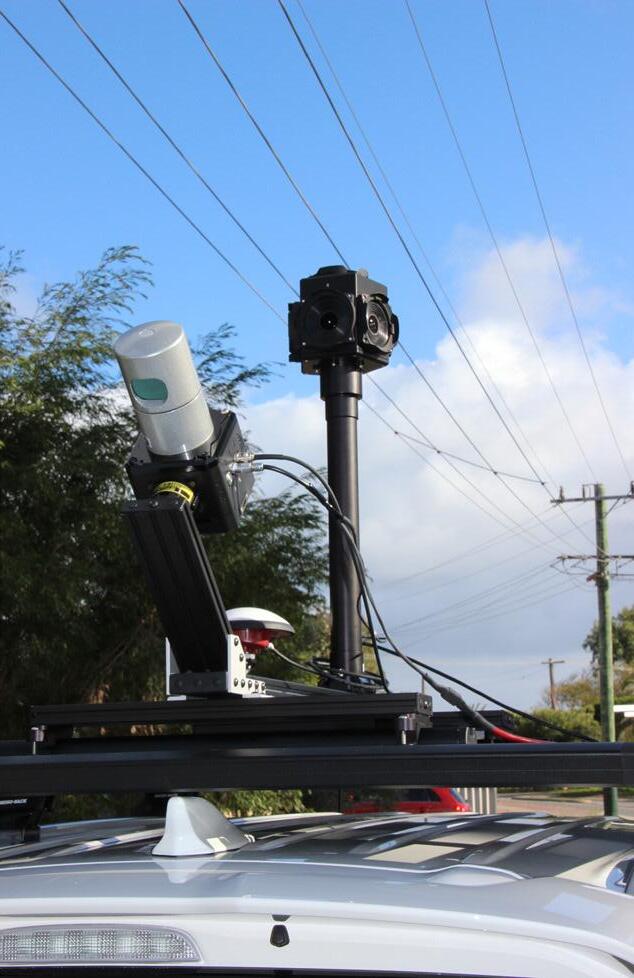
UTILITY • NOVEMBER 2021 WWW.UTILITYMAGAZINE.COM.AU 38
DISASTER MANAGEMENT | Sponsored editorial For more information on how OsmoVision® and Logsys Power Services can assist with grid hardening, head to www.logsys.com.au


OsmoVision
Advanced Structural Resiliency Study
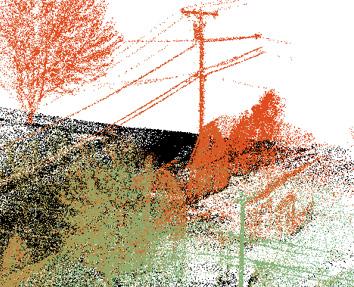
Cost-effectively enhance the resilience of power grid structures with an accurate assessment of existing infrastructure health.
• Generate a digital twin using our proprietary LiDAR point cloud classification and image recognition technology.
• Assess your system resiliency by simulating its ability to withstand high-impact events, such as a cyclone.
• Formulate system hardening solutions that improve your infrastructure’s structural resiliency.
(08) 9300 2950 | enquiries@logsys.com.au | logsys.com.au/osmovision an company
®
IMPLEMENTING A CYBER SECURITY PLAN TO PROTECT WATER AND WASTEWATER INFRASTRUCTURE

That was up by 13 per cent from the previous year with losses exceeding $33 billion. ACSC reported that a quarter of cyber security incidents were associated with critical infrastructure and essential services. One area that is critical for continuity of supply is the secure operation of Australia’s water and wastewater infrastructure.
While the details of the processes between fresh water supply and wastewater disposal differ significantly, the architecture of the automation and control system, as well as the respective communication and control mechanisms, are almost identical, particularly regarding safety.
The increased digitalisation of industrial automation and control systems (IACS) has the potential to significantly increase operational efficiencies while decreasing costs. However, with increased amounts of data comes the significant downside of increased vulnerability to cyberattacks which need to be mitigated.
DEFENSE-IN-DEPTH
A Siemens whitepaper, Cybersecurity: Defense-in-Depth Concept for Water and Wastewater Industry, highlights that increased digitalisation provides a fundamental rethinking of information and operational security, and access protection – as well as the entire process of defining and implementing industrial security concepts. Never has it been so important for vendors, solution providers and operators of control systems, to face the security threats they pose.
Critical infrastructure facilities require special IT and OT security solutions that ensure uninterrupted plant availability, real-time capability of critical IACS functions, and constantly updated protection and security controls against security threats.
In this regard, it is advisable to implement the so-called Defense-in-Depth concept, underpinned by IEC 62443 and provided by Siemens as a leading IACS vendor and IACS solution and service provider.
Cybercrime has increased in volume and sophistication during the pandemic, with the Australian Cyber Security Centre (ACSC) revealing in its annual threat report for 2020-21 that it had received 67,500 cybercrime reports.
Defense-in-Depth is composed of multi-layered security controls and measures such as plant security, network security and system integrity elements, which build the foundation for the industrial security concept, from the interface to management and administration systems via the operations level to the field level.
If the appropriate controls are used, the security of water and wastewater plants and networks can be continuously monitored in near-real-time, and attacks can be detected and prevented. System access and communication are analysed and documented so that companies can fulfill their obligation to identify and report environmental and security-related incidents in alignment with regulatory compliance.
A HOLISTIC SECURITY CONCEPT
Both organisational and technical measures must be carefully coordinated. A holistic security concept relies on people, processes and technology to be in synergy to achieve the necessary level of protection. The IEC 62443 standards addresses all parties involved – IACS vendors, solution and service providers, and operating companies. It defines responsibilities and relevant organisational interfaces, and it provides a framework for defining, implementing, documenting, testing and maintaining organisational and technical measures against intentional and unintentional security incidents.
Siemens – as a vendor and single-source supplier of industrial automation and control systems – is well positioned to support system integrators and operating companies in coping with these increasingly demanding challenges. Risks can be successfully minimised by taking security requirements and measures into account during the architecture, design, development and operation phase, and by implementing a holistic and adaptive security concept.
For more information, please visit www.siemens.com.au
UTILITY • NOVEMBER 2021 WWW.UTILITYMAGAZINE.COM.AU 40
DISASTER MANAGEMENT | Sponsored editorial


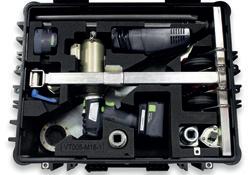

Easy transportation Simple implementation Operator and equipment safety 1300 FMT FMT (368 368) Melbourne 1/53-57 Rimfire Drive Hallam VIC 3803 Brisbane 2/5 Percy Drive Brendale QLD 4500 Perth 3/48 Hardey Road Belmont WA 6104 The water supply operator’s kit H2O WATER KIT
ENGINEERING RAMPS UP RUSTED POLE

You would not expect to find saltwater crocodiles in the suburban streets of Alice Springs. But a new innovation in town, named after famous Top End crocs, is a central feature of a power pole replacement program currently underway.
CORROSION
42
INNOVATION REPLACEMENT PROGRAM

AN AUDIT OF POWER POLES IN ALICE SPRINGS FOUND MANY OF THE TOWN’S POLES WERE AT RISK OF FAILURE DUE TO SUBSURFACE CORROSION.
43 CORROSION
The four engineering fixtures – named Sweetheart, Chopper, Dominator and Stumpy – were developed and patented by Northern Territory utility Power and Water Corporation.
Each measuring five metres long, the fixtures are largescale clamps that hold steel poles in position while works are undertaken to re-make corroded pole bases on the spot.
“Steel poles can fall over if the steel below ground rusts away and in the past, complete pole replacement has been the only option to address this issue,” Power Services Acting Executive General Manager, Dr Stephen Vlahovic, said.
“This is expensive, slow and disruptive for customers. It is a lot of work considering the only part of the pole that has deteriorated is below the ground.
“We developed the concept design of the pole fixtures and led the detailed design, technical analysis, fabrication and testing to develop a solution fit for the Territory.”

FLOOD SPARKS POWER POLE AUDIT
After the flooding of the Todd River in 2015 saw the failure of a steel power pole due to corrosion, Power and Water commenced an inspection of pole footings across Alice Springs.
The inspection data along with soil chemical analyses were analysed in the Corporation’s Geospatial
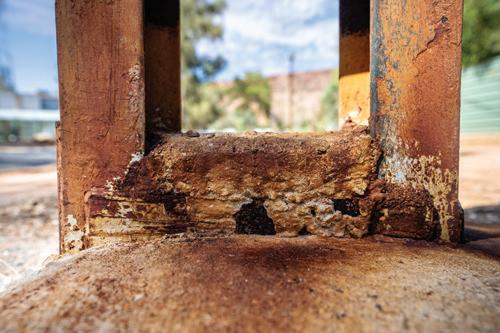
Information System to identify pole locations with a high likelihood of corrosion, and build risk profiles for each pole in consideration of the environment, social and physical influences.
The majority of the town’s power poles were found to be at risk of failure due to subsurface corrosion – an unexpected result given Alice Springs’ dry climate.
Replacing an in-service pole is expensive and customers experience a lengthy interruption to power supply while works are undertaken.
The current practice requires a power outage of around six hours and stresses the adjacent poles and wires, placing them at increased risk of failure.
In response to these problems, Power and Water engineers and maintainers, supported by a local engineering firm, invented the pole fixtures.
Four pole fixtures were manufactured by a local Territory business, each weighing in excess of 2.5 tons. Each fixture, which has the capacity to restrain up to 32 tons, will work on poles of any height, size or pole top arrangement, including legacy I-beam poles erected in the 1950s and 60s.
A POWERFUL BITE
After being trucked to a pole requiring maintenance, the fixture is lifted into place using a knuckle boom crane, all the while maintaining safe distances from the live electrical conductors.
The fixture’s steel jaws will clamp down on the pole, allowing the corroded below-ground section of the pole to be removed without a power outage in most cases.

THE FIXTURE’S STEEL JAWS CLAMP DOWN ON THE POLE, ALLOWING THE CORRODED BELOW-GROUND SECTION OF THE POLE TO BE REMOVED WITHOUT A POWER OUTAGE.
CORROSION
44
WWW.UTILITYMAGAZINE.COM.AU
“Once the pole has been clamped the corroded base of the pole can be re-made by removing the corroded base, welding on new steel and pouring the concrete footing to establish a barrier between the pole and the corrosive soil, preventing future corrosion,” Dr Vlahovic said.
“Any cables going from the pole top to underground are encapsulated in conduit and made into the pour without being disconnected.
“Once the concrete is set, the clamp is removed and the job is complete.”
And to monitor the hardness of the concrete, Power and Water is using sensors to determine the point at which the pole tip load will be overcome.
“We are able to monitor the temperature and moisture of the concrete, which then tells us when we are able to safely remove the fixture and move on to the next pole,” Dr Vlahovic said.
The fixtures are expected to help save millions of dollars in repairs and maintenance costs and will eventually eliminate the need for power outages during pole replacement work.
Dr Vlahovic said the use of the fixture could also result in minimal interruptions to the town’s streetscape and community, reduced traffic control requirements and limited customer outages.
“It’s an outstanding innovation,” he said.
To date, around 300 power poles have been rebutted.
The pole replacement project in Alice Springs was identified as being one of the largest planned capital

THE FIXTURES ARE EXPECTED TO HELP SAVE MILLIONS OF DOLLARS IN REPAIRS AND MAINTENANCE COSTS AND WILL EVENTUALLY ELIMINATE THE NEED FOR POWER OUTAGES
DURING POLE REPLACEMENT WORK.
investment programs for Power and Water’s Power Services team in recent times.
The use of the fixtures will also result in a 60 per cent savings compared to the previous pole replacement program options.


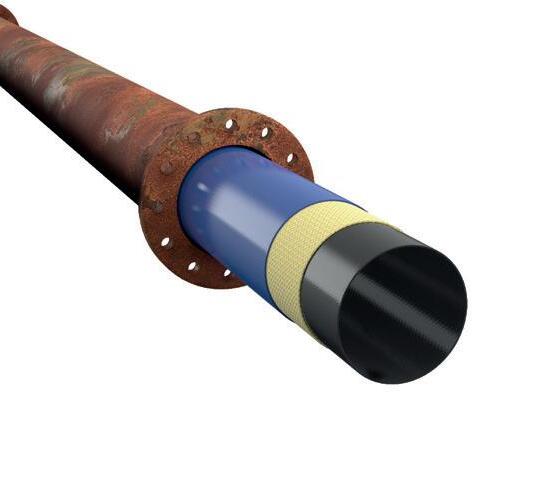







Trenchless rehabilitation of water mains and sewer rising mains
• Savings of up to 40% compared to open trench
• Renewal of up to 500 m per day
• Bends of up to 45°
• Small pits, minor installation footprint Raedlinger
www.primusline.com
WWW.UTILITYMAGAZINE.COM.AU 45 CORROSION HOST PIPE DESTINATION PIT
Pty Ltd.
Primus Line
Sydney, NSW 2000 | Australia info@primusline.com
Designed developed and made in Germany
C HARTING A PATH FOR UTILITY DIGITAL TRANSFORMATION
The energy and utility industries are experiencing a period of unprecedented transformation. The traditional one-way relationship between centralised, assetintensive utilities and the consumer, has been turned on its head.
We have entered a new energy paradigm where the emerging prosumer lies at the heart of a new decentralised and bidirectional energy system and an increasingly electrified economy.
To thrive in this new world, a successful future utility will need to build compelling, integrated value-added services, overcoming complexity to present a personalised and seamless user experience to the customer.
BUILD: ESTABLISH A CLOUD PLATFORM FIT-FOR-PURPOSE
This is the time to create cloud-native engagement and collaboration platforms that are flexible and scalable enough to keep up with transforming energy markets, able to integrate disparate data sources, provide deep analytical insight, and exceed increasing customer and stakeholder expectations.
Truly agile utilities require a cloud platform that’s built specifically with energy and water utility business models in mind.
SIX QUESTIONS TO ASK YOURSELF WHEN SELECTING A PLATFORM
1. Organisational agility
Can you quickly adapt to rapidly changing market conditions, regulations, and new forms of competition?

2. Speed to market
Can you easily configure integrated, multi-product offerings and promptly launch them in the market?
3. Software interoperability
Can you easily integrate internal applications, third-party applications, and future acquisitions?
4. Lower operating cost
Can you minimise the software, hardware, and human resources needed to manage business processes?
5. Frictionless experiences
Can you create personalised and seamless experiences for customers, communities, employees, contractors, partners and regulators?
6. Business transparency
Can you access real-time, predictive analytics to provide deep, actionable insight into business performance?
About Salesforce Industries
Salesforce Industries delivers industry-specific cloud and mobile software that embeds digital, omnichannel processes for customer-centric industries. It enables companies to achieve faster business agility and time-to-value from the cloud, across digital and traditional channels. Learn more at salesforce.com/au/utilities
UTILITY • NOVEMBER 2021 WWW.UTILITYMAGAZINE.COM.AU 46
RETAIL, BILLING AND CRM | Sponsored editorial
MEETING 5-MINUTE SETTLEMENT REGULATORY REQUIREMENTS
On 28 November 2017, the AEMC made a final rule to change the settlement period for the electricity spot price from thirty minutes to five minutes, with the changes to be implemented by late 2021. 5-minute settlement (5MS) provides a better price signal for investment in fast response technologies, such as batteries, new generation gas peaker plants and demand response. It is one of the biggest changes the Australian market has seen since the NEM was formed in the '90s, with the impacts on all those involved in the sector no less wide-ranging.
THE CHALLENGE
An Australian B2B Energy supplier needed to meet the regulatory changes for 5-minute settlement of interval metered customers and provide high availability, resilience and scalability required of mission-critical billing systems.
One of the largest considerations with moving to 5-minute settlement is the increase of data. With standing data changes and additional meter data to manage, Gentrack needed to handle the increased data load with around 70 different industry procedures affected and around six times more meter data to manage and store.
Choosing an accurate, market compliant software solution that can handle the increased data load and keep the mission critical meter to cash processes running within the available processing window is crucial in ensuring retailers and energy suppliers can make a smooth transition to 5-minute settlement.
THE SOLUTION
Gentrack’s approach to building cloud services to deliver functional components strategically provides value to customers in ever changing regulatory environments.
The development of Gentrack’s Meter Data Services on AWS predates the industry's 5-minute settlement regulatory changes. However, the scheduling of the 5MS industry program fast-tracked the urgency and implementation of this service to market, with the need to process large volumes of interval data as a by-product of the industry-wide changes in Australia.
Gentrack’s Meter Data Services on AWS is a fully managed cloud service that supports the ingestion, analysis, and querying of large volumes of meter data. It is designed to be used by multiple systems within the utility’s enterprise including Gentrack’s Billing System and other systems to support critical workflows and processes and provides:
• Efficient storage of meter data
• Processing of large complex account workloads
• Turning detailed consumption data into actionable insight
The product facilitates low latency access to meter data, aggregates energy usage, and gives controlled access to meter data, allowing providers the ability to scale using native cloud services with data while supporting all interval based NUOS calculations in the NEM.
It is designed not just for 5-minute interval data, but potentially finer increments, through the ability to scale using native cloud services and can execute many processes concurrently.
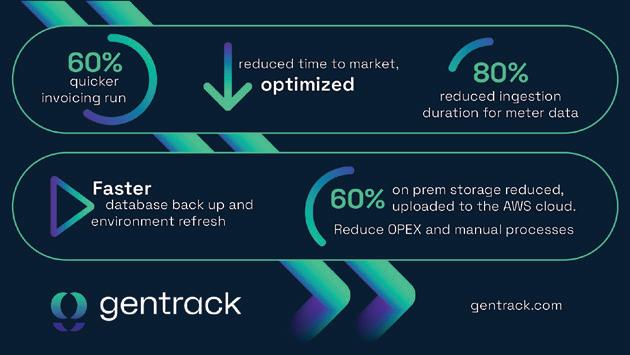
THE TAKEAWAY
The performance and scalability needed to meet data increases from 5MS also creates the opportunity to realise some efficiency improvements for retailers.
With this implementation, there was a 25 per cent timeframe reduction for processing meter data and associated invoicing cycles, allowing the retailer to bill their customers a day ahead of the previous process. This pulls forward significant cashflow for the critical first of the month billing cycle, and for subsequent cycles.

For more information, please visit www.gentrack.com

47 UTILITY • NOVEMBER 2021 WWW.UTILITYMAGAZINE.COM.AU
editorial | RETAIL, BILLING AND CRM
Sponsored
GENTRACK METER DATA SERVICES: CUSTOMER IMPACT
A NEW BILLING SYSTEM FOR AUSTRALIAN WATER UTILITIES
Aptumo, a cloud-based water customer billing solution powered by Echo Managed Services in the UK, is making positive in-roads into the Australian water sector. Coliban Water has successfully transitioned its billing and customer support software to Aptumo, and now North East Water has also chosen Aptumo to support its team in delivering an enhanced experience for its 55,000 customers across 39 towns in the area.
In response, Aptumo has established an Australian company based in Melbourne to attend to the existing requirements of Coliban Water and North East Water, and to service the needs of future Australian water utility clients.
Aptumo has made two significant appointments to its new Australian operations: Tony Kelly AM as a non-executive Director, and Richard Harris as General Manager. Both are well respected, experienced members of the Australian water sector.
“Our team on the ground in Australia allows us to provide local context to create successful billing solutions for the Australian water sector. This is complimented by the global expertise of the 120-strong team from Echo Managed Services,” Mr Kelly said.
“Richard and I are water people; we understand the meter-to-cash process. The creation of a local Aptumo office cements our commitment to assist Australian water utilities and their customers for the long haul.”
IMPROVING PRODUCTIVITY WHILE LOWERING COSTS
Aptumo, whose pioneering billing software is built on the Salesforce platform, is building the foundations for further expansion in the Australian market. The mission is to help more water companies transform their customer and stakeholder experiences, while lowering their billing costs.
The company behind Aptumo, Echo Managed Services, is part of a much larger company that owns two British water utilities. Echo currently provides billing services to about one third of British water utilities.
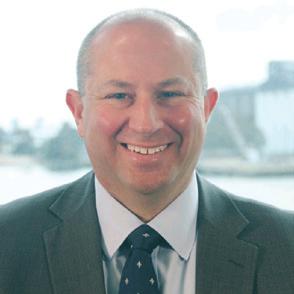
“Being built on the Salesforce platform, Aptumo offers rich out-of-the-box functionality, helps water companies improve productivity, offers their customers much more choice, and a better service,” Mr Harris said.
“Coliban Water’s successful implementation of Aptumo and the subsequent roll-out to North East Water means we now have an Australian version of Aptumo that provides other water utilities across Australia with significant start-up benefits and lower risks.
“Coliban Water has already agreed to share its ‘Use Cases’, business processes, testing regimes and functionality with other Victorian water utilities to reduce their risk and accelerate their implementation.”
A TAILORED AND INTEGRATED SYSTEM
Mr Harris said that being cloud-based, Aptumo is seamlessly upgraded regularly with minimal disruption to the organisation, which future-proofs the system.
“The bottom line is, compared to other Tier 1 systems, Aptumo is cheaper to own and operate, can be tailored by in-house staff to meet operational needs, and comes fully integrated with the Salesforce platform, the world leader in CRM.
“We are passionate about helping Australian water utilities capitalise on the potential of Salesforce. The substantial investment that Salesforce makes in new functionality guarantees the platform will keep up with customer expectations.
“We’re also committed to helping our clients advance their digital strategies, giving them more autonomy over their internal systems, reducing risk, and improving the productivity of their billing processes,” Mr Harris said.
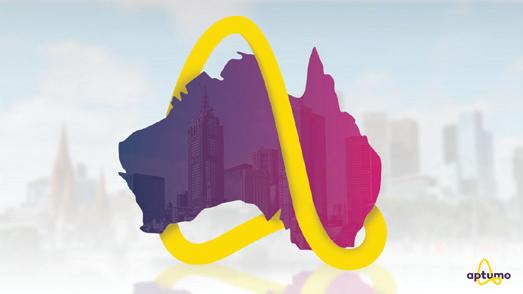
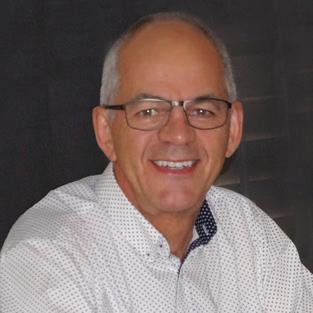
UTILITY • NOVEMBER 2021 WWW.UTILITYMAGAZINE.COM.AU 48
RETAIL, BILLING AND CRM | Sponsored editorial
NON-EXECUTIVE DIRECTOR, TONY KELLY AM
GENERAL MANAGER, RICHARD HARRIS


aptumo.com hello@aptumo.com Introducing Aptumo, the pioneering utility billing platform that brings you closer to your customers. Built by the water industry, for the water industry. Powered by Echo Managed Services, the UK utility billing specialist.
THE FUTURE OF ENERGY RETAIL? EXPANDED PRODUCT OFFERINGS:
by Lauren DeLorenzo, Journalist, Utility magazine
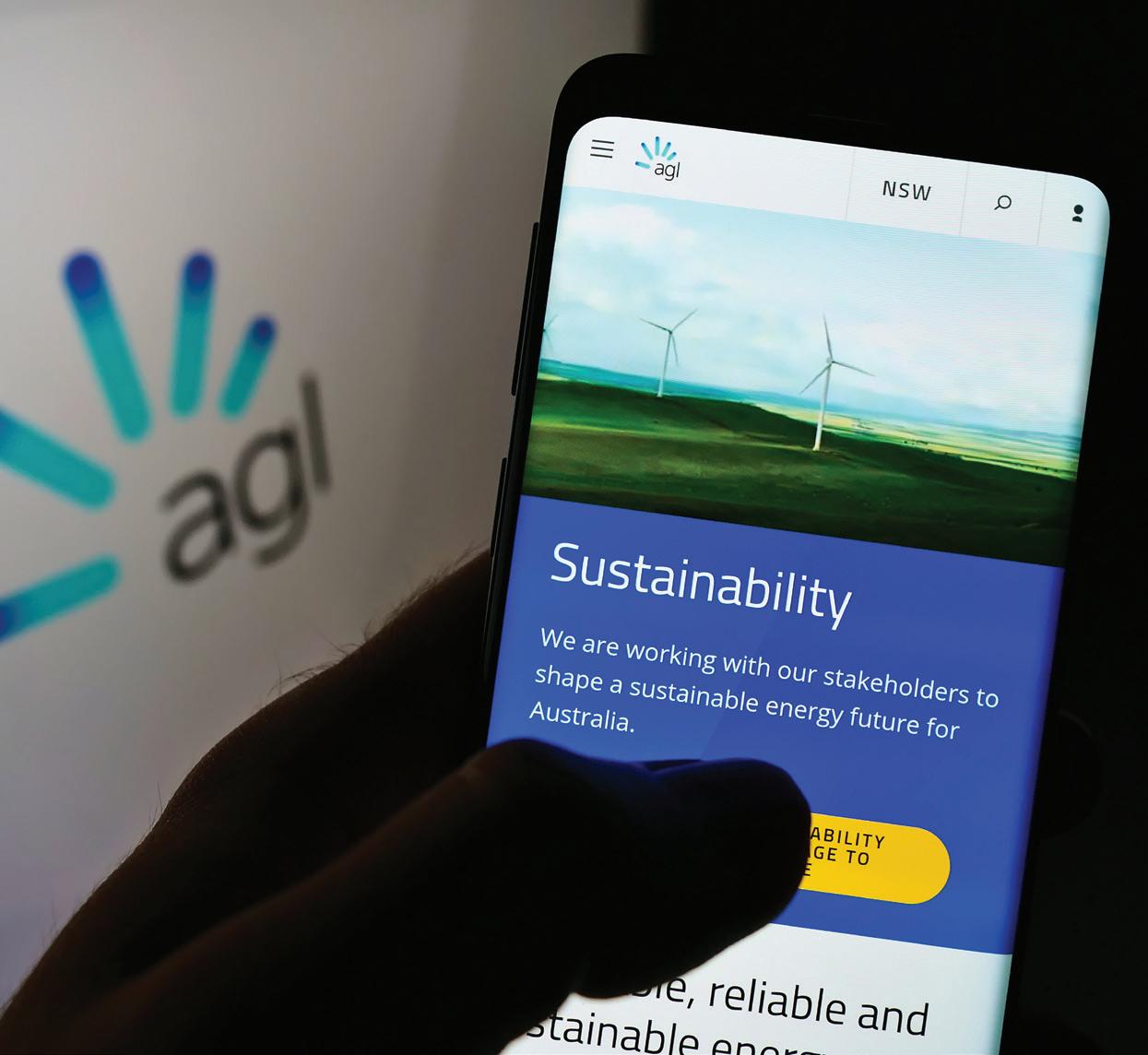
UTILITY • NOVEMBER 2021 WWW.UTILITYMAGAZINE.COM.AU 50 RETAIL, BILLING AND CRM
With traditional revenue sources dwindling and energy retailers now competing for fewer customers, many companies have repositioned themselves as customer solutions providers, expanding their products to include insurance or telecommunications services. Here, we pick apart this trend to see how a diversified product range could unlock a bright future for energy retailers.
In an ever-changing energy landscape where customers scrutinise refrigerator Energy Star Ratings, neighbourhood battery programs abound, and nearly three million Australian households use rooftop solar, energy retailers need to stay ahead of customer trends. Many of the major players in energy retail in Australia, including EnergyAustralia and AGL, are looking at diversifying their product offering, expanding beyond energy retail and looking at new products including telecommunications and insurance.
EY Partner Digital and Emerging Technology, Damien Hudson, said that evolving a product portfolio which includes adjacent services such as insurance and broadband, is a trend that started several years ago and has accelerated in recent years. Many of Australia’s energy retailers are now offering products such as solar PV, electric vehicles, battery products and smart home devices.
Customers are also seeing the potential economic benefits of renewable energy, and this increasingly environmentally-conscious customer base presents challenges for traditional energy retailers.
“Consumer demand for renewable energy generation is based on, not only
seeking an economic benefit by saving on energy bills and potentially selling energy back to the grid, but also they are seeking to make their contribution to a low-carbon, environmentallysustainable society powered by their own home-grown energy generation,” Mr Hudson said.
Traditional energy retailers are also facing competition from new digitalfirst market entrants, which leverage smart technologies to provide lower energy prices.
Consumer Data Right (CDR), which has carried across from the banking sector into the energy sector, will come into effect in 2021 and allow customers to share data with accredited third parties to provide more competitive quotes. This is expected to encourage more digital-first energy providers to enter the market.
“In the UK, Octopus Energy and OVO Energy entered the electricity market, leveraging their own software platforms (Kraken and Kaluza) to drastically reduce cost to serve and also allow rapid creation of new product or service offerings,” Mr Hudson said.
“Some local retailers have indicated they are making strategic technology investments in Kraken and Kaluza.
“Retailers will increasingly need to create deeper, more meaningful relationships with their customer base to retain them.
“Energy retailers need to be ready with compelling products and services that support the personal sustainability and economic goals of consumers.”
IDENTIFYING OPPORTUNITIES
A number of energy retailers have already updated their service offerings by repositioning themselves as customer service providers, and expanding into areas such as insurance.
AGL’s newly-established innovation hub, AGL Next, aims to develop and test new technology and business models to support the future expansion of the company’s products.
One of these initiatives is a $3 million investment in the start-up company Honey Insurance, through AGL Next’s Future Business Strategy. The move means that AGL is able to streamline customer essential services, and can add smart insurance products to its range of broadband, mobile and energy services.
Honey uses smart home technology such as sensors, which can detect and prevent incidents such as fire, water damage or theft. Bundling smart home devices and using sensors and

UTILITY • NOVEMBER 2021 WWW.UTILITYMAGAZINE.COM.AU 51
RETAIL, BILLING AND CRM
RETAIL, BILLING AND CRM
meters to reduce premiums is rapidly becoming the new standard.
“In addition to diversifying revenue sources, energy companies can develop a deeper understanding of customers, and use that insight to develop new offerings and quickly respond to rapidly changing demand,” Mr Hudson said.
“The customer experience can also be enhanced through having a single point of interface across a broader range of services.”
EnergyAustralia’s new Stack On product launch also highlights this push towards bundled services. The initiative allows customers to access utility, data and insurance services in one centralised service. Stack On provides options for electricity, NBN internet, mobile plans, home and car insurance.
These services are backed by Optus and Open Insurance, and the program is on trial through EnergyAustralia’s On by EnergyAustralia platform, which uses customer data to develop new services.
While the most consistently offered products for energy retailers are electricity, gas and broadband, common areas for increased service include a variety of smart home devices, solar panel and batteries, electric vehicle charging equipment and subscription services.
“Financing or leasing of solar, batteries and electric vehicles are financial vehicles that will also reduce barriers for customers and create a longer-lasting relationship with the retailer,” Mr Hudson said.
“For large electricity consumers, there is strong demand for ‘green’ products such as electricity from renewable sources and green certificates to enable their corporate ESG targets to be met.”
THE FUTURE OF ENERGY RETAIL
For energy retailers looking to reposition and expand products and services, the core needs of their customer base should first be understood.
“There are a number of things retailers can do to identify whether they should consider new service offerings, and if so, what those services should be,” Mr Hudson said.
“The steps are highly dependent on the starting position of each retailer and their objectives, but could include doing a scan of the market using Political, Economic, Social, Technological, Environmental, and Legal (PESTEL) type analysis, identifying the retailer’s own strategic advantages, understanding customer’s appetite for new products/services and determining the delivery model options which could include strategic partnerships.”
Data collection and analysis can drive innovation in this area. Retailers might also use market research to monitor emerging technologies and consider their potential implementation in services. For example, a retailer might monitor the development of smart home sensors to discover their application in new or existing services. Looking to adjacent sectors for new strategies or ideas to implement can also be relevant to monitor.
Mr Hudson said, “Increased ecosystem partnerships with start-ups, device and appliance manufacturers and financial services organisations will drive significant innovation in offerings and the way they are delivered.”
While a focus on innovation presents many opportunities, energy retailers must be able to expand offerings while keeping existing high-quality systems in balance.
“The challenge will be reducing cost-to-serve while expanding the diversity of products and services and keeping pace with high expectations for customer service experiences online, over the phone and face to face at the point of installation or service delivery,” Mr Hudson said.
“A seamless and well-coordinated customer experience where they may be dependent on commercial partners or third party service providers is a challenge, and will rely on digital enablement to orchestrate all parties.
“Maintaining a distinct brand and customer value proposition that differentiates them from the new market entrants will be critical, and then fulfilling the brand promise with quality service will be key to retaining and growing their position in the retail energy market.”

UTILITY • NOVEMBER 2021 WWW.UTILITYMAGAZINE.COM.AU 52

BILLING AND CRM UTILITY • NOVEMBER 2021 WWW.UTILITYMAGAZINE.COM.AU 53
RETAIL,
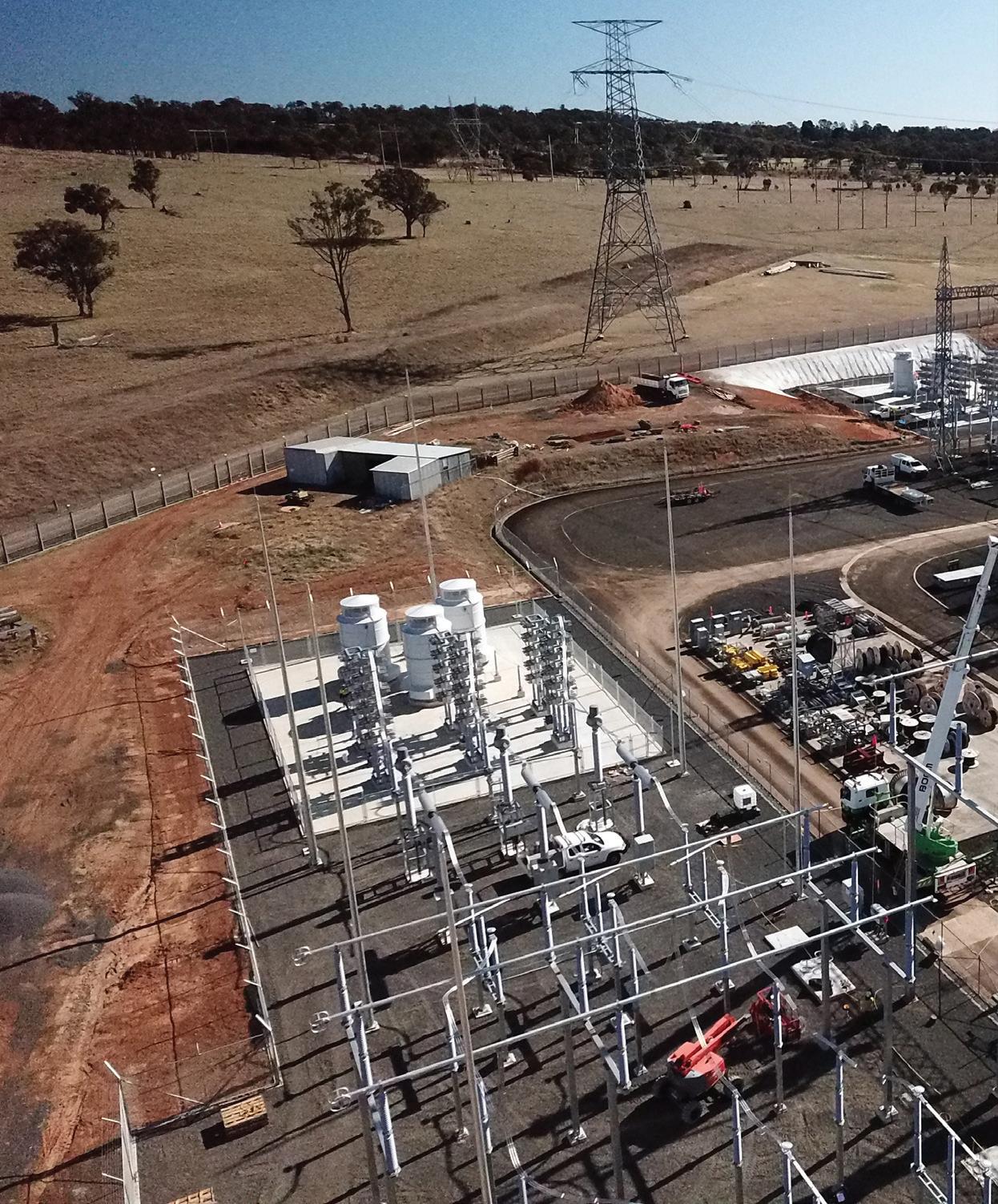
UTILITY • NOVEMBER 2021 WWW.UTILITYMAGAZINE.COM.AU 54
TRANSFORMERS AND SUBSTATIONS
by April Shepherd, Journalist, Utility magazine
CAPACITOR BANKS 3, 4 AND 6 AT TRANSGRID’S ARMIDALE SUBSTATION ARE BEING ENERGISED.
BOOSTING REACTIVE POWER AND GRID STABILITY QLD-NSW INTERCONNECTOR
TRANSFORMERS AND SUBSTATIONS

The Transgrid Queensland-NSW Interconnector upgrade, which has involved extensive work on substations and transformers, continues to progress, with the project’s goal of boosting interstate transmission capacity and reactive power in the grid close to becoming a reality.
The Queensland-NSW Interconnector (QNI) upgrade aims to ensure a steady power supply for customers by sharing energy across states and the National Energy market (NEM).
The upgrade began in early 2019, with a focus on providing more reactive power support for the grid, and was approved by the Australian Energy Regulator (AER) and fast tracked with support from the NSW and Federal Governments.
The $230 million project is still underway, with an estimated completion date of early 2022 and predictions of a massive $177 million in net benefits to customers once completed.
Transgrid’s QNI Project Director Josh Walker said the project is hoping to achieve more affordable power, support the move towards a renewable future, and enhance energy reliability.
“QNI is largely about providing more reactive power onto the grid, to increase network stability. This has involved major works at three substations to install Static Var Compensators (SVC), associated power transformers, and new capacitor banks,” Mr Walker said.
“QNI is part of our commitment to securing supply in an evolving energy landscape, increasing generation competition and supporting Australia’s transition to a lower carbon future.
“More interstate power flows will boost reliability ahead of the forecast closure of NSW’s Liddell Power Station.
“QNI will increase the power transfer capability between NSW and Queensland by approximately 190MW south and 450MW north.”
The project has passed several major milestones, having moved from the civil construction stage to the electrical installation stage, as well as reaching the 80 per cent completion mark in July 2021.
Substation upgrades at Tamworth, Dumaresq, Armidale, Muswellbrook and Liddell are also speeding ahead, along with installation of SVC transformers.
WHAT DOES THE PROJECT INVOLVE?
Transgrid is upgrading substations at Tamworth, Dumaresq, Armidale, with minor works at Muswellbrook and Liddell. Major works include the replacement of primary and secondary equipment, the expansion of substation footprints, installation of two SVCs, and installation of nine capacitor banks, to provide greater voltage stability and reactive energy.
The project also includes upgrading 300kms of 50 year old transmission lines, between Liddell Power Station, Muswellbrook and Tamworth substations. This has involved the replacement of 58 tower structures, replacing the old models with a simpler, taller design that allows a greater transfer of power.
Further project works included the raising of transmission line conductors by replacement of insulator arrangements
KEY PROJECT DATES
• Preliminary investigations and project scoping: early 2019
• Detailed design and site investigations: late 2019
• Approval by the AER: April 2020
• Construction starts: May 2020
• Estimated project completion: Early 2022
UTILITY • NOVEMBER 2021 WWW.UTILITYMAGAZINE.COM.AU 55
TRANSFORMERS AND SUBSTATIONS
SUBSTATION KEY WORKS
Dumaresq
Civil works at Dumaresq substation, located in New South Wales close to the Queensland border, are close to completion, with electrical works underway.
This substation’s footprint was expanded to make way for the new SVC units, new capacitor banks, SVC transformers and associated switch bays.
SVC units contain technology that can effectively control reactive power on the grid. Specialists from Siemens Energy, who supplied QNI with the technology, will commission the SVC units.
Key civil construction works on the Dumaresq substation include:
• Marshalling boxes
• Lightning mast and light poles
• Busbar supports
• Current breaker supports plus electrical conduits
• Cast in-situ pits, gutters and channels, storm water and yard surfacing
• Gantry construction
• Upgrade of towers
• Footprint expanded
• SVC units installed and constructed
• New capacitor banks added
• SVC transformers and associated 330kV switch bays
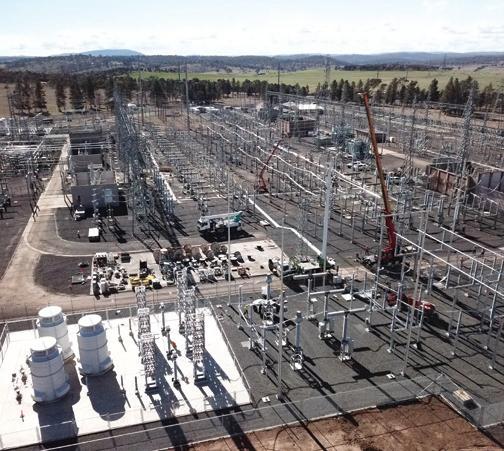
Armidale
Construction of new capacitor banks began in June 2021 at Armidale substation in New England, to enhance power system stability and increase transfer capacity. Four capacitor banks were energised by August 2021.
Key civil construction works on the Armidale substation include:
• Concrete footings, energisation and construction of the 330kV capacitor banks
• Marshalling boxes
• Lightning mast and light poles
• Busbar supports
• Current breaker supports, plus electrical conduits
• Cast in-situ pits, gutters and channels, storm water and yard surfacing
• Gantry construction
• Upgrade of towers
Tamworth
Tamworth substation, situated in north-east New South Wales, is a key aspect in the QNI project, with work beginning on the substation in July 2020. The work at Tamworth is predicted to be completed in early 2022, with capacitor banks likely to be energised in November 2021.
Key civil construction works on the Tamworth substation include:
• Constructing a new SVC compound, to house the SVC switchgear, control systems and three transformers
• Constructing a new services building
• Installing three new capacitor banks and associated switch bays
• Building noise walls and security fencing
• Replacing a transmission tower
Muswellbrook and Liddell
Muswellbrook and Liddell substations are located in the Upper Hunter Region of NSW. Only minor construction works were required at these sites, which include:
• Replacement of equipment substation equipment and conductors
Transmission Lines between Liddell and Tamworth
Works on uprating of the transmission line links were largely completed in July 2021. These works increase the thermal rating of the lines, by raising the conductor heights and clearances. This included:
• Installation of new pole structures
• Removal of old tower structures
• Replacing transmission line insulators/rearranging
• Ground contour re-grading and levelling
THE ONGOING IMPACT OF COVID-19
On interstate projects, collaboration and precise planning is key. Mr Walker said that collaboration and early engagement with design, construction and equipment suppliers was critical to achieving the best outcomes possible for the QNI project.
“Our suppliers have worked with us to drive innovative designs, integrate new technology and equipment into brownfield operational assets,” Mr Walker said.
COVID-19 has brought its own set of challenges to the upgrade, requiring work to be continuously managed by Transgrid in collaboration with State Governments. The pandemic also impacted international supply chains, which was a challenge as equipment was sourced from Europe and Asia.
“There have been issues with staff movements across state borders, as well as out of Sydney and difficulties with the entry of international technical specialists into Australia,” Mr Walker said.
UTILITY • NOVEMBER 2021 WWW.UTILITYMAGAZINE.COM.AU 56
CRANE AND ELEVATED PLATFORMS WERE USED IN CAPACITOR BANK ENERGISATION AT THE ARMIDALE SUBSTATION.
“COVID-19 has also reduced the availability of international shipping. Despite these challenges, all equipment is now on-site”.

ARMIDALE SUBSTATION DURING UPGRADE CONSTRUCTION WORKS FOR THE TRANSGRID QNI PROJECT.
THE VICTORIA-NEW SOUTH WALES INTERCONNECTOR
The QNI upgrade isn’t the only interconnector project Transgrid is currently working on; the Victoria-New South Wales Interconnector (VNI) is also underway, aiming to provide shared energy and increased capacity between the two states.
TRANSFORMERS AND SUBSTATIONS
“Both the QNI and VNI upgrades are about improving the supply of lower-cost power to NSW consumers. But the projects are vastly different in scope and execution,” Mr Walker said.
Mr Walker said VNI has been contained to major works at predominantly one substation site, with innovative Smart Wires technology enabling the use of existing transmission lines, whilst QNI required more substation works and SVC installation.
INTERCONNECTOR BOOSTING INDUSTRY JOBS
A project of this size can provide a significant boost to short-term and long-term employment, from construction jobs, to roles in operations and maintenance.
Mr Walker said the QNI project has seen up to 280 people employed during the civil construction stage of the works. Providing an economic boost to surrounding regions, not just from employment, but for local businesses in accommodation, hospitality and the ancillary sector.
“As well as providing direct employment, there will be longer term benefits as well, as the new substation equipment will need to be operated and maintained throughout its serviceable lifetime. Maintenance representatives are being familiarised with these new assets through involvement in the commissioning phase, and will be included within their ongoing program of works,” Mr Walker said.
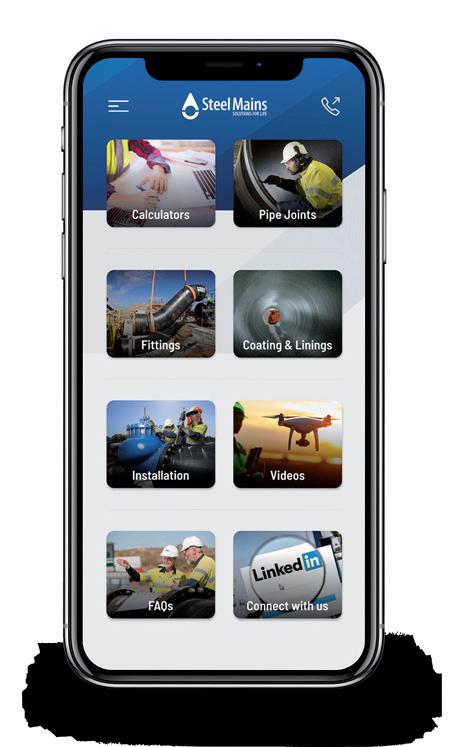
Easily accessible when you’re on the go.
essential pocket app provides immediate access to the full range of Steel Mains Sintakote® Pipeline Systems.
The app includes product literature such as brochures, installation guides, manual handling and FAQ’s.
An all-new pipe calculator function has been integrated to instantly compute and determine accurate product data on hydraulic loss, pressure ratings, pipe weight, pipes per truck and other critical information – all of which to help users make Download

WWW.UTILITYMAGAZINE.COM.AU 57
the free app today. PSMU2104H
Steel Mains pocket app
POWERING UP PERTH:
THE WESTERN POWER HAY TO MILLIGAN PROJECT
A major electricity infrastructure milestone was recently achieved in Perth, with work complete on the long-planned Western Power Hay to Milligan Project – a critical piece of state electricity infrastructure that secures power supply in the CBD, helping to deliver a bright future for the city and the state.
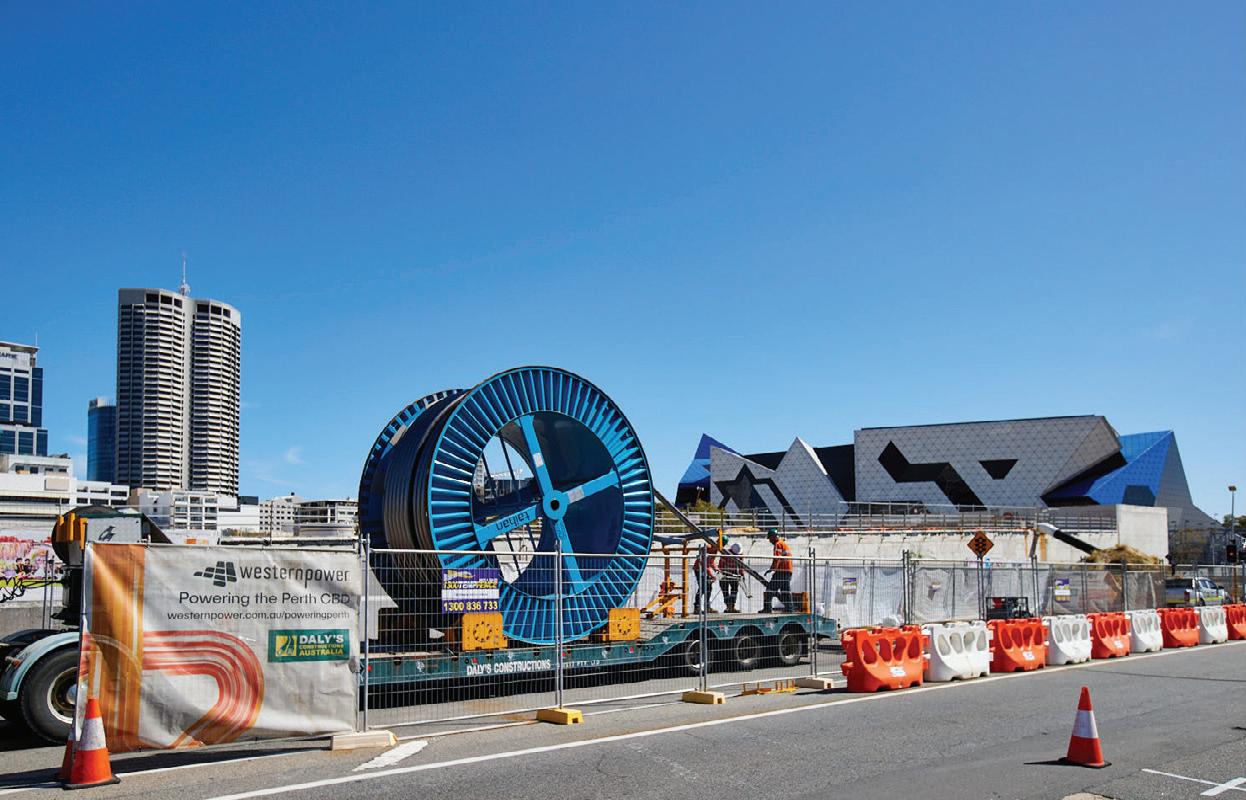
Western Power is a State Government-owned corporation responsible for building, maintaining and operating an electricity network that connects 2.3 million customers in the southwest corner of Western Australia.
Part of the $37 million Western Power project was the installation of a 132kV underground cable circuit between the existing Hay Street Substation (HAY) and Milligan Street substation (MIL) in the Perth CBD – to meet N-2 CBD reliability requirements.
A ROI was released to the market in late 2016 followed by a tender process in 2017. Following in-depth negotiations, Daly’s Constructions was awarded the project in August 2018.
The contract was awarded on an EPC basis, with Daly’s responsible for:
• Final route verification and selection
• Approvals from all stakeholders
• Cable system detail design to achieve a 175MVA summer rating
• Procurement of all materials including 132kV power cable, cable joints, accessories and all civil construction materials
• Cable hauling
• Cable jointing and terminating
• Construction and installation
• Pre-commissioning tests & handover
Daly’s partnered with Taihan Electric Australia to deliver the project.
CHALLENGES
Daly’s Constructions’ first project in Western Australia required detailed planning, especially involving mobilisation of resources, plant and equipment, as well as establishing suitable subcontractor and supplier arrangements.
In addition to working with Western Power, complex engagement, negotiations and approvals in the design phase were required from major stakeholders, including:
• Public Transport Authority
• Metropolitan Redevelopment Authority
• City of Perth
• Water Corporation of WA
• Main Roads WA
• ATCO Gas
One of the key challenges experienced during the project included: confirming a route that would satisfy third party approval requirements and minimise disruption to the CBD, whilst achieving the required circuit rating where the circuit is to be installed in close proximity to existing 132kV feeders.
UTILITY • NOVEMBER 2021 WWW.UTILITYMAGAZINE.COM.AU 58
TRANSFORMERS AND SUBSTATIONS | Sponsored editorial

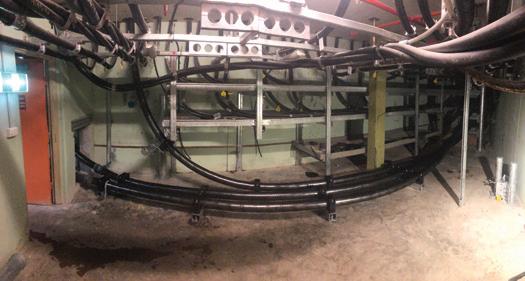
Almost 400 existing underground services along the 2km route, ranging from large storm water and rising sewer mains, to live power cables, HP gas mains and strategic optic fibre cables, were traversed with zero damages.
One of the more challenging road crossings was the Hay St and Milligan St intersection. This road crossing was completed over a weekend commencing on Friday evening, running back-to-back crews for 60 hours through to the Monday morning.
This involved the removal of oil filled 132kV cables and asbestos conduits, excavating at 2.7m depth in sand using shoring boxes adjacent to live traffic whilst crossing some 15 live services.
Other key challenges included:
• Multiple major crossings along the route: rail, major roads, ATCO gas, critical optic fibre cable, major public area
• The requirement that the road network was to be available at the completion of each night shift to enable normal traffic flows, thus limiting disruptions to the road network and the public. This was the first time this methodology was engaged on a transmission project in central Perth
• Two precast concrete joint bays were designed and manufactured, each weighing 24 tonnes
• Minimising community and business disruption: vehicle and pedestrian traffic, rail services, the Perth Arena, Art Gallery of WA, the State Theatre Company, hotels, cafes, use of predominantly night works, numerous car park access points, access between the CBD and Northbridge entertainment precinct
• Significant structural modifications to existing walls and floors within both substations required to facilitate cable and switchgear installation on the third level
• Complex environmental issues involving the testing, management and disposal of significant groundwater and acid sulphate soils, as well as archaeological and heritage aspects required liaison, monitoring and approvals
• Interface and coordination with Western Power’s GIS switchgear installation in Milligan St Substation
• The unprecedented COVID impacts that adversely affected the delivery and installation of key components
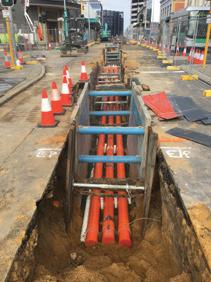
PROJECT HIGHLIGHTS
Western Power Project Manager, Ian Anderson, said one of the big successes of the project has been a new technique to lay the cable conduits in short sections in high traffic areas, reducing the impact on commuters.
“Each night, Daly’s excavated a short section of the route, say 20m, laid the conduits, installed thermal backfill and added fresh asphalt, ready to be driven over the next morning.
“It’s been a new way of working for us which worked really well. The disruption to everyday life in the CBD was incredibly minimal given the importance of the route we are taking and it has saved a huge amount of costs in traffic management.”
The project’s safety performance was outstanding, with no recordable incidents during the construction phase.
Two sleeve bores under the Perth metro rail system either side of the Perth train station were also a highlight. These were achieved after prolonged negotiations with the PTA and the minimal construction window approved for each shift. The drill shots were six metres deep with significant groundwater to manage.
Another success was the cable installation in an urban environment and up four levels in existing substations, as well as the cooperative and outcome-driven approach between Western Power and Daly’s facilitating the successful delivery of the project.
“The success of the project delivery is due to the collaborative approach with Western Power’s project team, major stakeholders, effective planning and Daly’s highly committed workforce,” Daly’s Director, Malachy Daly, said.
“This project was one of Daly’s Construction’s most challenging undertakings and relied heavily on some of our most experienced people to deliver it.”
LONG-TERM BENEFITS
• Modifications and enhancements to the Western Power transmission specification from project experiences and the effective implementation on this project
• The now demonstrated methodology of ensuring the road network is available at the conclusion of each night shift for future transmission underground projects
• Daly’s are well positioned in the Western Australia market to leverage off the excellent outcomes from this project
For more information, contact Daly’s Constructions at cable@daly.net.au or visit www.daly.net.au.
UTILITY • NOVEMBER 2021 WWW.UTILITYMAGAZINE.COM.AU 59
Sponsored editorial | TRANSFORMERS AND SUBSTATIONS
THE INVISIBLE THREAT YOU CAN NOW SEE

Tired of spending too much time detecting partial discharge? Engineered to locate partial discharge (PD), corona discharge, and gas and vacuum leaks, the Fluke ii910 Precision Acoustic Imager is the device you need.
The Fluke ii910 acoustic imaging camera's groundbreaking technology makes it a cost-efficient, safe, effective, and comfortable tool for teams who inspect and maintain power distribution and industrial high voltage equipment.
The Fluke ii910 is designed so that anyone can use it with little to no training. Simply turn on the device with one button, select your frequency range (or let the tool do that for you) and immediately start scanning for PD or leaks. Once you find a concerning image of a sound, you can use the Fluke ii910 to capture a video or photo to be used after you have added text annotations. If you want more details about a specific leak or PD, simply switch into PDQ or LeakQ mode.
DO IT FASTER AND SAFER
Partial discharge is a serious issue that teams monitor every day. Whether you are scanning insulators, transformers, switch gears, or high voltage powerlines, you need to be sure that you can spot a problem early. Partial discharge that goes unchecked can cause blackouts, fires, explosions, or even death when arc flashes occur.
Quickly scan the area and get all the pictures and videos you need with the simple one button capture and large 7” touchscreen LCD. Without cumbersome secondary cables or devices, you have total mobility and flexibility to swap between detecting and fixing the leak/PD.
No additional tools or equipment are required to operate the Fluke ii910. Gone are the days of wearing headphones and listening for very faint sounds, or squinting at a small screen to locate issues. Everything you need to locate issues from a distance is contained within the Fluke ii910, with no cords or other accessories hanging down and getting tangled. Simply pick it up, turn it on and start locating hidden issues.
SAFETY YOU CAN TRUST WITH PERFORMANCE YOU VALUE
The Fluke ii910 Precision Acoustic Imager is the perfect tool for high voltage electricians, electrical test engineers, and grid maintenance teams that are constantly inspecting and maintaining power distribution and industrial high voltage equipment. The Fluke ii910 makes maintaining high voltage equipment and preventing
For more information or to book a demo, please visit
potentially catastrophic events easier and safer than ever.
With the unit’s unique SoundSight™ technology, the Fluke ii910 translates the sounds that it hears into a visual representation so that you can quickly locate problem areas on the device’s screen. It has a high frequency range of 2-100Khz to allow for the early detection of potential issues, thereby facilitating early preventative maintenance planning.
SAFETY YOU EXPECT WITH THE RUGGED PRODUCT YOU TRUST
Safety is key when working on high voltage equipment, and at Fluke, safety is paramount. Due to the combination of specific microphone positions and a sophisticated algorithm, the Fluke ii910 Precision Acoustic Imager can detect PD and corona discharge from up to 120m away.
This means that you can remain even further away than the required safety distance while still being effective at locating problem areas. In addition, Fluke’s acoustic imaging technology is able to pick up reflections of sounds, so a direct line of sight is not required to locate a problem. Now you can locate PD without ever opening a cabinet.
UTILITY • NOVEMBER 2021 WWW.UTILITYMAGAZINE.COM.AU 60
TRANSFORMERS AND SUBSTATIONS | Sponsored editorial
fluke.co/ii910u11.


KWIK-ZIP’S HDX SERIES CASING SPACERS COMPLY WITH WSAA PRODUCT SPEC #324 – CASING SPACERS; REFER WSAA PRODUCT APPRAISAL REPORT #1523 Is your pipe spacer compliant? Call us for details on ordering P (08) 9725 4678 sales@kwikzip.com www.kwikzip.com
BOOST PRODUCTIVITY
WITH POWERFLEX 6000T MEDIUM VOLTAGE DRIVES
Simple, connected, easy-to-use. Rockwell Automation and NHP bring you the PowerFlex 6000T medium voltage (MV) drives, featuring common control architecture and TotalFORCE ® technology.
PowerFlex 6000T MV drives will simplify your integration and operating experience as they share the same control hardware, firmware and network interface software used in NHP’s latest generation of PowerFlex 755T low voltage drives.
Using a common control platform across your entire installed base of variable frequency drives lowers integration, operation and support costs. A common platform also reduces product-specific training requirements and spare parts inventory.
PowerFlex 6000T MV drives feature:
• Easy configuration, integration and visualisation in the Studio 5000 design environment. The Add-on Profile is the preconfigured data translator, visual user interface and data configurator all rolled into one. It is also the primary tool that sends drive data to the control system
• Connected Components Workbench software offers full device profile support, which makes it easier to configure, program and visualise in a single software package
• Simplified and more intuitive local control, monitoring and diagnostics with a larger 254mm colour touch screen enhanced HIM
• Real-time alerts available for device health via FactoryTalk® Analytics™ for Devices
• Extensive input power monitoring functionality for kW, kVA, kVAR, elapsed kWh, MWh and power factor
• Quick and secure flash-over-fibre firmware updates for all main control boards and power cells from a single file
• More comprehensive and faster troubleshooting with Forensic Data Recorder functionality
• TotalFORCE technology provides excellent motor control through precise, adaptive control of velocity and torque while using maintenance analytics alerts to ensure maximum drive and process uptime
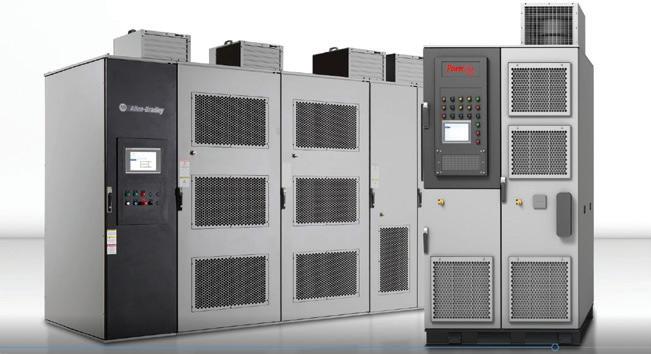
SUITABLE APPLICATIONS
PowerFlex 6000T MV drives are particularly well suited for all-purpose, non-regenerative applications such as fans, pumps, mills, conveyors and compressors. They are an ideal solution for motor control applications from 100...11,000 kW (200...15,000 Hp) and for motors rated from 2.3...11 kV.
Air-cooled PowerFlex 6000T drives are designed to maximise energy efficiency by enabling soft starting and variable-speed control, in normal duty and heavy-duty applications. To achieve low input harmonics and near-unity power factor, the drives use a Cascaded ‘H’ Bridge topology. This topology combines an integrally-mounted phase shifting isolation transformer with series-connected power cells for each phase.
PowerFlex 6000T AC drives allow for flexibility in a variety of applications and are available in many configurations based on motor voltage:
• Multiple control modes, including flux vector control, featuring up to 150 per cent starting torque with an encoder and 100 per cent starting torque without an encoder
• Simple, air cooled design at all voltage and power ratings
• Eco design main cooling fans provide higher efficiency and reduce losses
• Integrally-mounted multi-pulse isolation transformer helps ensure low line-side harmonics
• Automatic power cell bypass helps minimise downtime in critical applications
• Common modular power cells designed for easy removal, minimising Mean Time To Repair (MTTR)
UTILITY • NOVEMBER 2021 WWW.UTILITYMAGAZINE.COM.AU 62
TRANSFORMERS AND SUBSTATIONS | Sponsored editorial For further information on PowerFlex 6000T drives or other Rockwell Automation products, please call or email your local NHP Account Representative in Australia: 1300 NHP NHP nhpsales@nhp.com.au or New Zealand: 0800 NHP NHP sales@nhp-nz.com



NHP Electrical Engineering Products 1300 NHP NHP nhp.com.au AUS Introducing TemBreak Pro
High Performance Moulded Case Circuit Breakers Maximise reliability. Set securely, configure easily. Measure and control energy.
LISTEN UP:
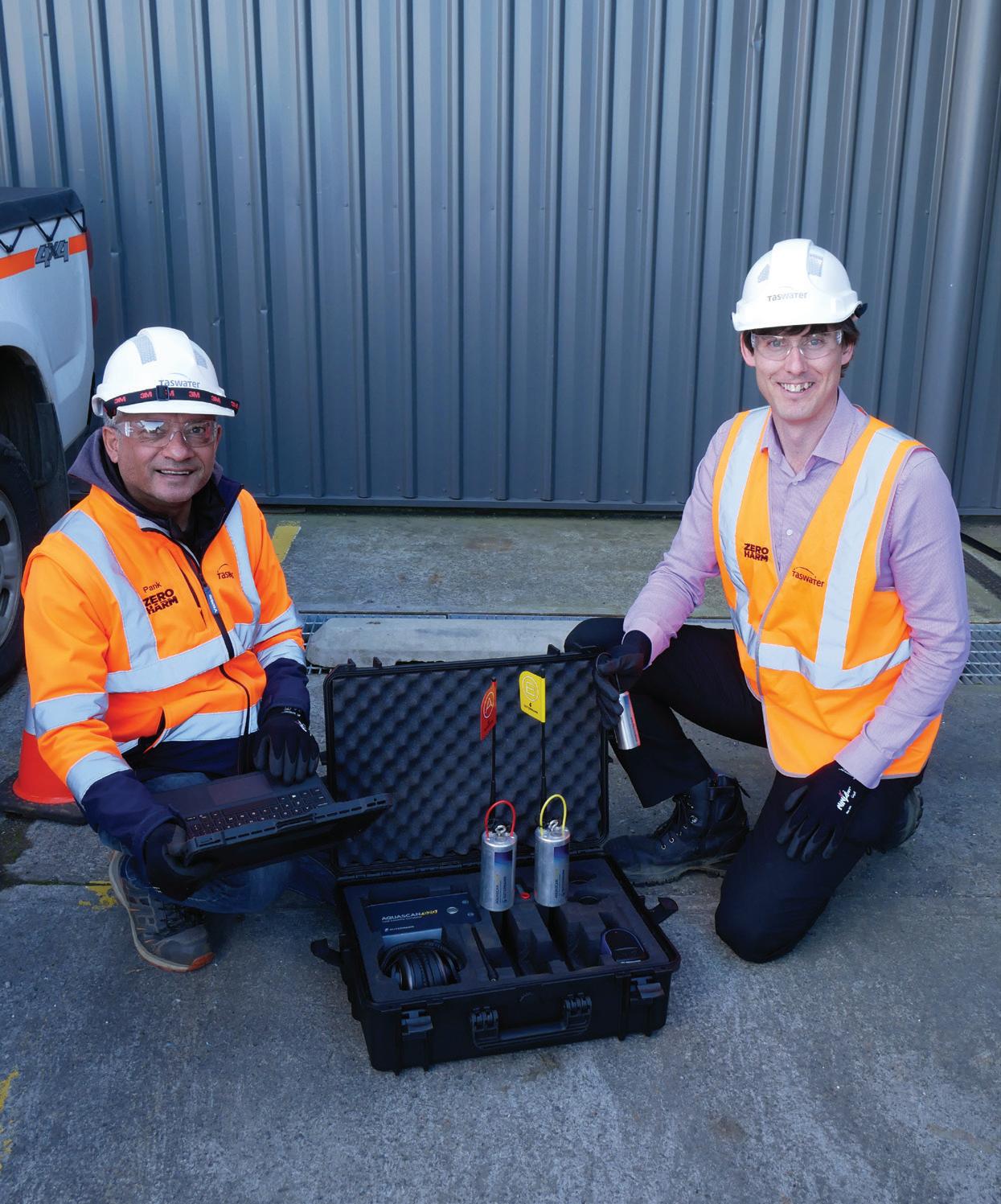
TASWATER’S ACTIVE LEAKAGE MANAGEMENT TECHNOLOGY
LEAK DETECTION 64
In a bid to address water losses in the network, TasWater has implemented active leakage management, featuring technology that listens for leaks that may not be visible to the naked eye.
Unaccounted for water has been identified in the Tasmanian Economic Regulator’s State of the Industry Report as an area in need of improvement, and TasWater is pleased to be implementing this technology, along with other initiatives to address this issue.
Customers expect water utilities to take the lead on water conservation and environmental impacts. When we ask them to conserve water each year, we need to do the same. Tackling unaccounted for water is one way TasWater is doing just that.
One initiative which has been rolled out in Tasmania is the Zonescan leak intelligence unit, where around 40 units are being used to listen for leaks within TasWater systems, and then identify them on a map.
SAVING 162 MEGALITRES OF WATER
Network Asset Performance Senior Engineer, Pankaj Mistry, said the Zonescan unit consists of one bluetoothenabled communication device, android tablet, and correlating loggers.
“We are using these devices across the state to help us identify leaks, some of which we know about but cannot find,” Mr Mistry said.
Since the roll out of the Zonescans in November last year, the number of leaks that have been detected and fixed has led to saving approximately 162 megalitres of water which would have otherwise been lost.
Not all water losses are as a result of leaks, but saving millions of litres of water through leak detection technology is an important step to address the issue.
Like other utilities, leaks come to the attention of TasWater through customers calling and reporting them to the customer service centre, and staff out in the field who come across them. These are known as reported leaks.
This technology gives us a more proactive approach to leak detection, not just identifying and resolving reported leaks.
“The process of active leakage control involves a team of staff sweeping an area using sound techniques to localise a leak, which is possible through technology like the Zonescans,” Mr Mistry said.
“Leak Noise Correlators are then operated on site, using specialist sounding software and technology that pinpoints the leak.
“Once we know the exact location, we can then deploy our staff to fix it.
“We usually have a team focus on an area for two to three days to ensure that zone is thoroughly covered, then they move to another zone or other areas of the network previously known for leaks.”
PINPOINTING LEAKS FASTER AND MORE ACCURATELY
To identify leaks, the Zonescan leak intelligence units need loggers either side of a specific area to hear the same noise so they can indicate if there is any possibility of a leak being present at that spot.
“The noise logger function in the Zonescan individually assesses the probability of a leak being present, based on the noise level,” Mr Mistry said.
Locations of the possible leaks can be viewed on the cloud based ‘Zonescan.net’ analysis system.
“With the Zonescan producing a correlation result within one metre of the leak, the average on-site pinpointing time is thirty minutes,” Mr Mistry said.
“In comparison, pinpointing leaks with standard noise loggers that do not correlate, takes an average of two hours and the operators often return at night to perform a correlation.
“When you add the travel time, there is a massive saving and reduction in manpower costs using a correlating logger like the Zonescan units.”
INCREASING COVERAGE
Another benefit to using leak detection technology is that it helps to conserve water by identifying leaks earlier.
“For example, using this technology we identified a leak in Claremont, a town north of Hobart, which was running at one litre per second.
“The saving from that one leak is about 86 cubic metres of water per day, which is a significant saving now that it’s been fixed.
“Zonescan units can also be easily moved around the network and require minimal staff to operate,” Mr Mistry said.
TasWater staff are currently targeting areas that have a higher number of leaks and bursts, before the initiative is rolled out more broadly.
“We intend to invest in more equipment and people to increase our coverage across the state, so we can continue to combat leaks within our networks.”
The staff who use the Zonescans are part of a dedicated team at TasWater who focus on our pipes, pump stations and other infrastructure to ensure they are working efficiently and effectively.
A HOLISTIC APPROACH TO IMPROVE RELIABILITY
The team also uses other equipment, not just the Zonescans, to identify leaks.
“In my role, I focus on all things non-revenue water state-wide, aiming to reduce any water loss in the network through bursts and leaks,” Mr Mistry said.
Non-revenue water is water which is treated but lost before it gets to the customer.
“Currently, I’m working on detecting leaks in the Clarence region, north of Hobart. We’re installing bulk water meters to measure the water flow going into a certain area.
“The data from the meters allows us to see whether any water is leaking in that section of pipe, so that a Zonescan can be deployed to find the leak’s exact location,” Mr Mistry said.
Reducing leaks in our network leads to an improved service and reliability for our customers.
These programs are just one way we are helping to improve reliability and water surety into the future for all users of our systems.
UTILITY • NOVEMBER 2021 WWW.UTILITYMAGAZINE.COM.AU 65 LEAK DETECTION
MANAGE WATER ASSETS
DURING
A CRISIS BY LEVERAGING SMART DEVICES
More frequent and extreme weather events are putting additional pressure on water utilities delivering critical water supply. Floods, bush fires, and extremely dry conditions can damage infrastructure, which is remote, not visible or is in inaccessible locations. Smart water meters and IoT sensors can provide rich data and insights informing support crews via alerts, enabling them to react quickly, addressing situations before they become a problem.
Take, for example, when a mains break occurs causing a significant leak, having district metered areas (DMAs) set up within Taggle’s Aqualus Water software can highlight these network losses. Action can then be taken quickly to isolate the issue and reduce further water losses. Pressure sensors within the network can help pinpoint the location of the break, as the pressure change is sudden and more pronounced closer to the break.
FLOOD, BUSHFIRE AND DROUGHT EVENTS
During a flood event it may be unsafe to carry out repairs for some time, putting a strain on water supplies.
Commercial and industrial customers with high water consumption can easily be identified with the Aqualus Water software. This enables the utility to proactively contact these customers requesting an emergency reduction in water use, saving scarce water for residential and emergency services.
Sewer overflows can also be easily avoided when early alerts from level sensors notify of potential blockages and problems within the network.
Dispatching teams quickly to clear blockages can make all the difference in preventing a costly overflow and EPA notification.
In the case of bush fires, pipes and other water infrastructure on rural properties can experience high breakage rates leading to significant water losses, particularly when residents have been evacuated. If utilities can remotely identify large leaks and manage work orders in a tactical fashion to shut off the water, then large savings can be made.
Similarly, during drought, significant water losses can go unnoticed as the hot dry ground quickly absorbs the additional water. Visualisation of the water network provides the opportunity to contact property owners with potential leaks to inform them of a hidden water loss issue.
GREAT VISIBILITY OF USAGE
If property owners are given access to their water usage data via the Aqualus Water Customer Portal, they can better self-administer their water usage with hourly water consumption data, and leak and high
consumption alerts and reports delivered straight to their email. During drought, the Aqualus Water Customer Portal is an extremely valuable tool in driving consumer behavioural changes, as high-water consumption activities are easily identified. That leaky tap which doesn’t look too bad can now be quantified, often with shocked responses to the scale of the leak, resulting in repairs getting done much faster.
There are many use cases for IoT sensors when discussing extreme weather events. Some of the sensors already in use by Taggle customers include compact weather stations, rain gauges, H2S gas, and level sensors on rivers and within the sewer network. These sensors are relatively cheap and easy to deploy on Taggle’s communication networks (Taggle Byron LPWAN and Myriota Satellite).
In a crisis there is much to be considered, and the ability to monitor assets and their performance can make all the difference in making informed decisions. As climate change is increasing the frequency of extreme weather events, it is important to have tools at the ready to make better informed decisions quickly. Taggle is able to provide the full end-to-end sensor to software turnkey solution or a portion of it depending on your utility’s requirements.
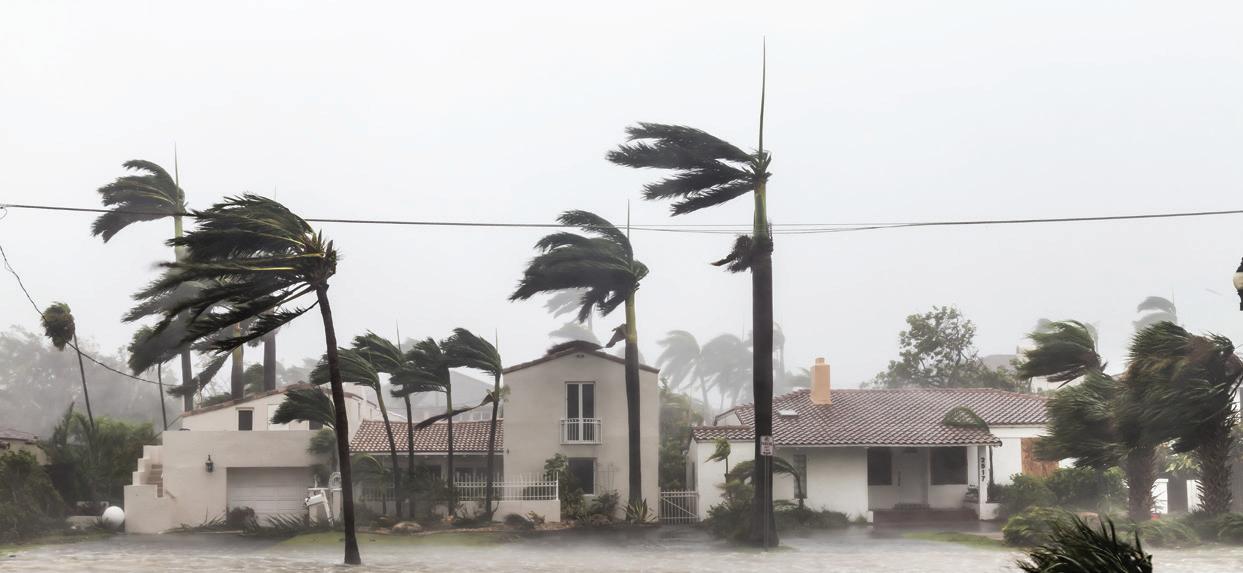
LEAK DETECTION | Sponsored editorial
For more information, please visit www.taggle.com.au. 66
COUNCIL MAGAZINE
your leading source of news for the local government sector
Council has been developed to keep you up-to-date with all of the latest news, discussions, innovation and projects in the local government sector.
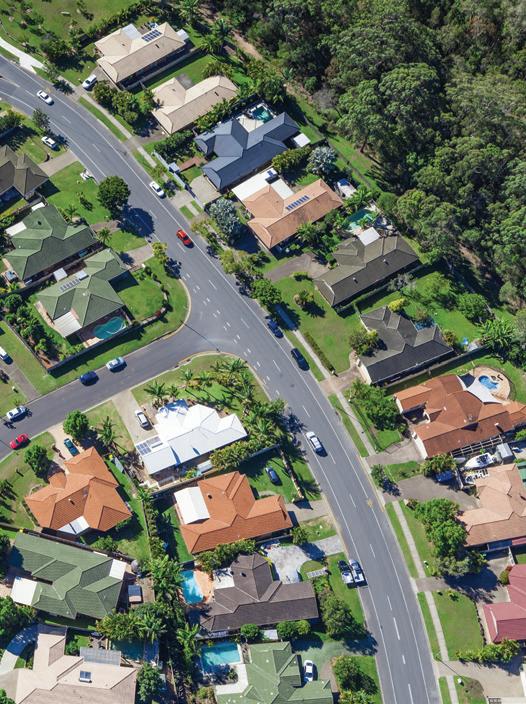

Council is fully integrated across print and online, featuring a website updated daily with the latest industry news, a weekly e-newsletter delivered direct to your inbox, and a quarterly magazine that can be read in print and online.
Published by industry publishing experts Monkey Media, Council will arm community decision-makers with the critical information they need to deliver a better future for cities, towns and suburbs all over Australia.


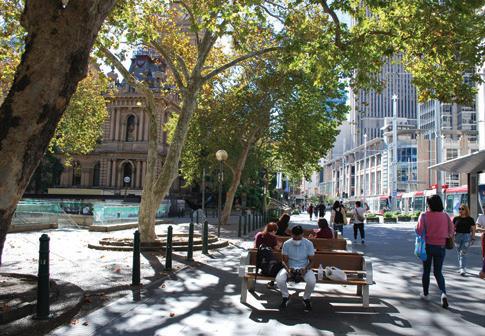
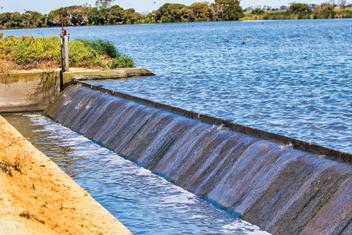
HEAD TO THE WEBSITE TODAY to sign up for the FREE WEEKLY NEWSLETTER!


www.councilmagazine.com.au
info@councilmagazine.com.au
Reverse
osmosis (RO)
is widely applied to remove salts and other substances from process
water.
Bacterial growth on
RO
membranes can greatly reduce the efficiency of this process,
so large amounts of chemicals (known as biocides) are dosed in the water, to prevent the proliferation of bacteria. Many biocides are oxidizers, and contact with RO membranes should be avoided.
For this reason, a tradeoff has to be achieved between the efficiency of chemical treatment and the prevention of damages caused by such substances.
In the Figure 1 example, this power plant used reverse osmosis to produce demineralized water for cooling of heat exchangers. Raw water was treated with a biocide, then passed ultrafiltration and was stored in a tank. RO was then applied. One ALVIM Sensor was installed before RO, in the feedwater line, and another one in the concentrate line.
The signal from the two ALVIM Sensors was acquired by the data acquisition system of the plant, along with the other data from the process. Laboratory analyses (CFU count)
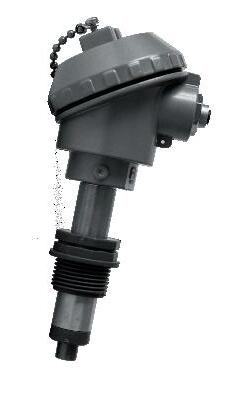
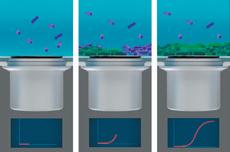
were periodically carried out on water samples taken from different points.
While this kind of analysis provides a rough indication of the number of free-floating (planktonic) bacteria in the water, the ALVIM Sensor monitors the growth of biofilm.
After the settlement of the first bacteria coming from water bulk, biofilm growth is no longer related to the presence of free-floating
bacteria. The microorganisms settle on surfaces, duplicate themselves, growing independently from the planktonic ones. More than 90 per cent of bacteria live in biofilms, and these structures provide better protection from external agents, including biocides and other chemicals. This makes biofilm up to 1000x more resistant to sanitation than free-floating bacteria.
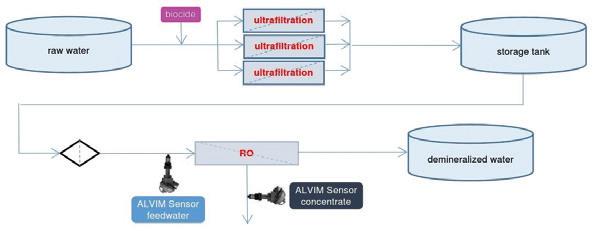
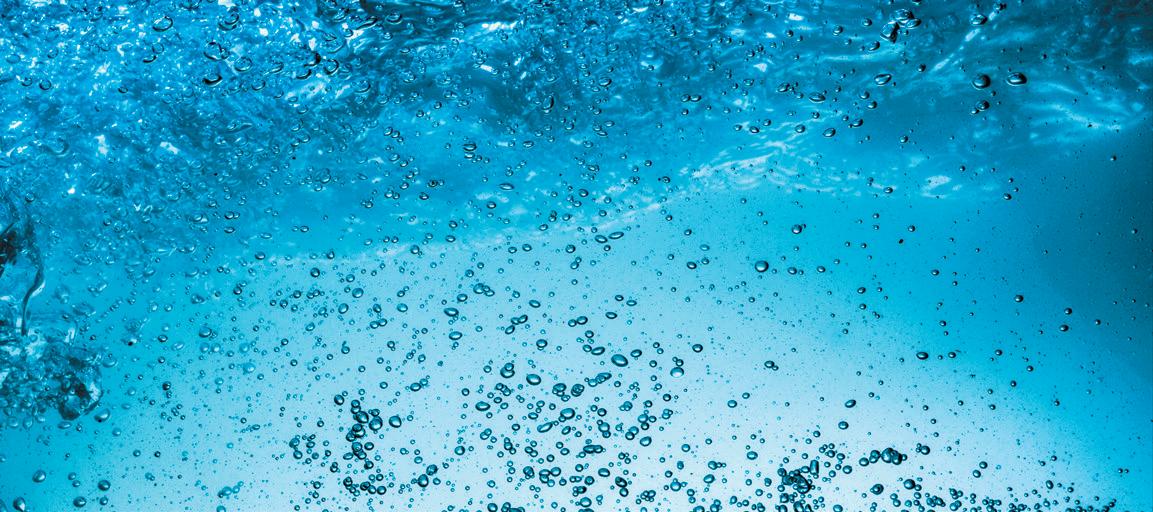
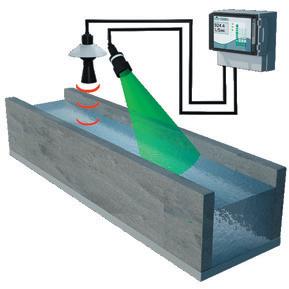
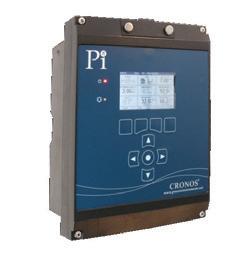
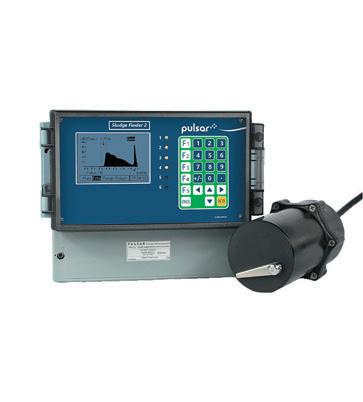
UTILITY • NOVEMBER 2021 WWW.UTILITYMAGAZINE.COM.AU 68
SAFETY | Sponsored editorial
& Velocity measurement Continuous Biofilm Monitoring Sample Biofilm growth signal over time LEVEL METERS BIOFILM ANALYSER ANALYTICAL CONTROLLERS PROCESS INSTRUMENTS PULSAR • Lightweight, compact design • No interruption to service • ATEX Ex mb Zones 1 & 2 approval • Minimal installation costs • Maintenance-free • RS485 Modbus • IP68 • Non-contacting • Cost-effective • Ultrasonic Transmitters and Controllers • Point Level Switches • Sludge Level Systems • Wireless Systems • Early detection of Bacterial Growth on surfaces • Monitoring & optimisation of sanitation requirements. NEW TURBIDITY MONITOR BINTECH SYSTEMS WATER SOLUTIONS 1300 363 163 sales@bintech.com.au www.bintech.com.au
INDUSTRIAL REVERSE OSMOSIS
FIGURE
1



69
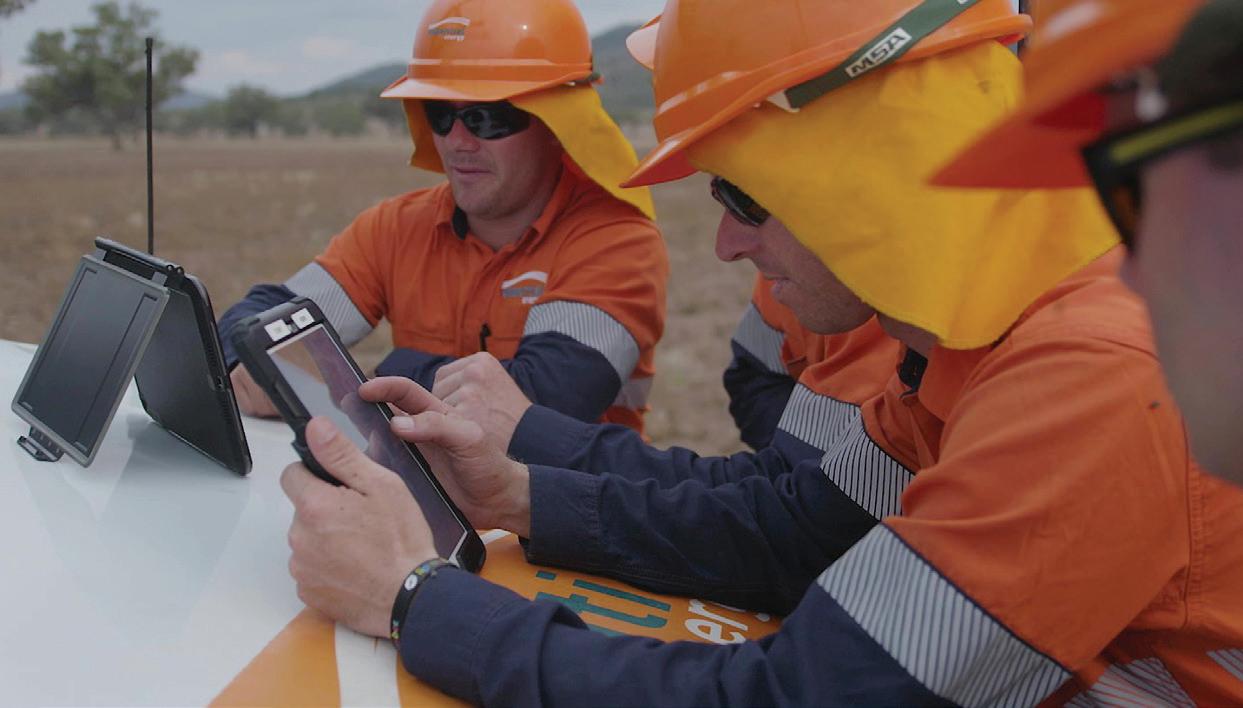
NEW DIGITAL AND TRAINING SAFETY INITIATIVES ESSENTIAL ENERGY’S
Essential Energy’s field crew take a leading role driving innovation, efficiency, and safety outcomes within the business. Recently, two new initiatives have been delivered that are paying dividends for employees right across the organisation.
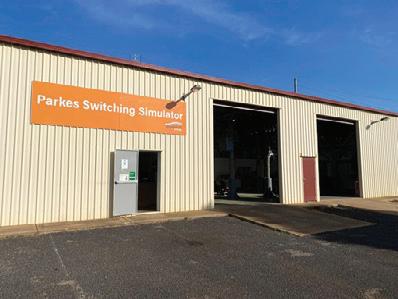
UTILITY • NOVEMBER 2021 WWW.UTILITYMAGAZINE.COM.AU 70
SAFETY
DIGITISING SAFETY ASSESSMENTS
Safety is Essential Energy’s number one priority. As the business has evolved over the years and decades, so have its safety procedures. Recently, the business implemented an electronic on-site Hazard Identification Risk Assessment Control (HIRAC). Until recently, completing the HIRAC – a key requirement for Essential Energy’s teams and an integral component of its corporate safety system – meant filling out one of twelve paper forms, depending on the task at hand, and involved field crews having to address up to 200 tick boxes on any given form. HIRACs were completed in large books that were carried around in work vehicles and stored in dozens of filing cabinets across depots.
Initiative Lead, Matt Lassau, said, “As part of the company-wide transformation program, leaders and end users identified that redesigning the HIRAC presented an opportunity to improve processes and safety engagement.
“From the outset, we understood that as important an enabler technology is, without addressing human behaviours and mindset, we would not achieve greater safety maturity.
The reimagined HIRAC is an interactive, engaging, and paperless tool that supports field teams to hold more collaborative team conversations and complete better quality onsite safety risk assessments on every worksite. Fully developed in-house, the user centric design maximises the benefits of mobile technology and allows Essential Energy’s field crews to drag-and-drop identified risks, interact
with asset maps, markup images, and use talk-to-text functionality.
Moving to the new digital HIRAC is driving improvements across Essential Energy’s business in a variety of ways including:
• Making safety data available in real time to build shared understandings and support improved safety outcomes
• Shifting from being a compliancebased activity (‘tick and flick’) to one that enables individuals and teams to focus on what matters
• Supporting individuals to stop, think, assess, and re-assess rather than being constrained by a prescriptive and rigid document
Thought Leadership, information sharing, and two-way feedback loops offered by the digital HIRAC, will undoubtedly have a positive impact on Essential Energy’s goal of keeping their people and customers safe.
SIMULATING SWITCHING IN A SAFE PLACE
Working in a high-risk environment, Essential Energy’s employees are continually updating their hands-on learning and professional development. One of its in-house training leaders was inspired to initiate a program to construct a switching simulator. The pilot was so successful that a further two simulators are planned or under construction in southern and western NSW, to enable all of Essential Energy’s crew to access this training.
Static and mobile network or switching simulators provide a safe, reliable and realistic learning environment which replicates the network configurations. It allows crews
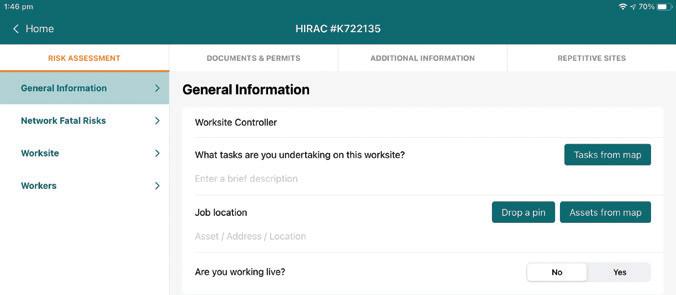
to link directly to system operations through Power On Mobile (POM), leveraging off digital technology utilised in the field.
This first simulator was commissioned at Rocks Ferry, NSW and is delivering a high standard of training outcomes for crews on the Mid-North Coast. The simulator delivers a realistic user experience while allowing crews to train in a safe and controlled environment.
Essential Energy has a strong focus on improving reliability for customers while keeping downward pressure on network charges. The construction and implementation of a simulated network supports that focus by enabling risks to the network and the risk of disruption to customers to be minimised, while at the same time providing crews with realistic training in switching and communications procedures.
Essential Energy has plans to launch two additional simulators across the network in addition to the first at Rocks Ferry – one at Parkes, and one at Wagga Wagga, to bring this training opportunity to all crew across its footprint. The simulator at Parkes is nearing completion.
Andrew Hinchcliffe, Technical Training Manager, said, “We have over 1,100 authorised operators switching our overhead, underground and Zone substation devices.
“Switching is a high-risk task and the network simulator projects reflect the investment in the ongoing competence of our staff. They are amazing training facilities which provide all-weather access and exposure to all three network scenarios, helping our operators build and maintain the high levels of expertise required to keep the lights on for our customers.”
Static simulators are already paying dividends for Essential Energy’s crew, and have the potential to be utilised further by the business. The business’ training team is currently investigating the feasibility of including the simulators in apprentice training programs.
“Advances to our award-winning apprenticeship program are another dividend from this great initiative, which was initiated by our field staff,” Mr Hinchcliffe said.
UTILITY • NOVEMBER 2021 WWW.UTILITYMAGAZINE.COM.AU 71
A SCREENSHOT SHOWING THE FIRST STEP OF ESSENTIAL ENERGY’S INNOVATIVE NEW DIGITAL HIRAC.
SAFETY
INSPIRING CONFIDENCE AND IMPROVING PROCESS SAFETY
LineVu is a video-based system designed to detect contamination in high pressure gas systems, enable alarm notifications, and allow live video access to both office-based and field-based engineers.
By providing better data to base operational decisions regarding process safety and efficiency on, the system improves accountability of gas suppliers to gas network systems and can boost production in gas treatment plants.
With live data, immediate action can be taken to prevent or minimise further contamination entering a gas network system, and recorded data can be used as evidence to recover pigging and clean-up costs from suppliers who breach supply agreements.
Everyone wants to get the most from the assets they have, but being able to see what is happening in a
high pressure gas treatment plant or gas pipeline has not been possible until now. Liquid carry-over, foam or even hydrate formation are common problems that need attention as soon as they occur. Unexpected liquids appearing in gas systems are the cause of large-scale loss and process failures, and can have an impact on asset integrity.
LineVu is a high precision camera system which can be used to
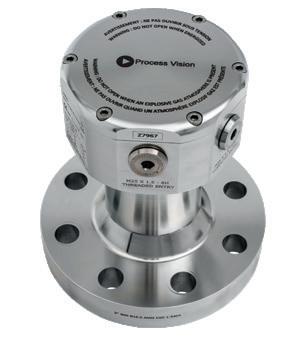
determine the real flow limits of a gas/ liquid separator system to support and improve flow modelling of ‘as built’ processing plants.
Permanent installation allows process failure events to be detected early, prevents loss and damage of assets such as compressors or absorber beds, and makes foam control easier to manage.
For more information, please contact AMS Instrumentation & Calibration on 03 9017 8225, Freecall (NZ) 0800 442 743, email sales@ams-ic.com.au or visit the web site at www.ams-ic.com.au.
INSTRUMENTATION & CALIBRATION PTY LTD SPECIALISTS
www.ams-ic.com.au
AMS have been suppliers of instrumentation and calibration equipment to all industries since 1973 representing some of the world’s leading manufacturers of the equipment in their field.





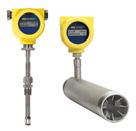





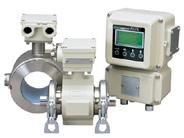


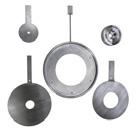
Flow Measurement Specialists

www.ams-ic.com.au
sales@ams-ic.com.au
UTILITY • NOVEMBER 2021 WWW.UTILITYMAGAZINE.COM.AU 72
SAFETY | Sponsored editorial

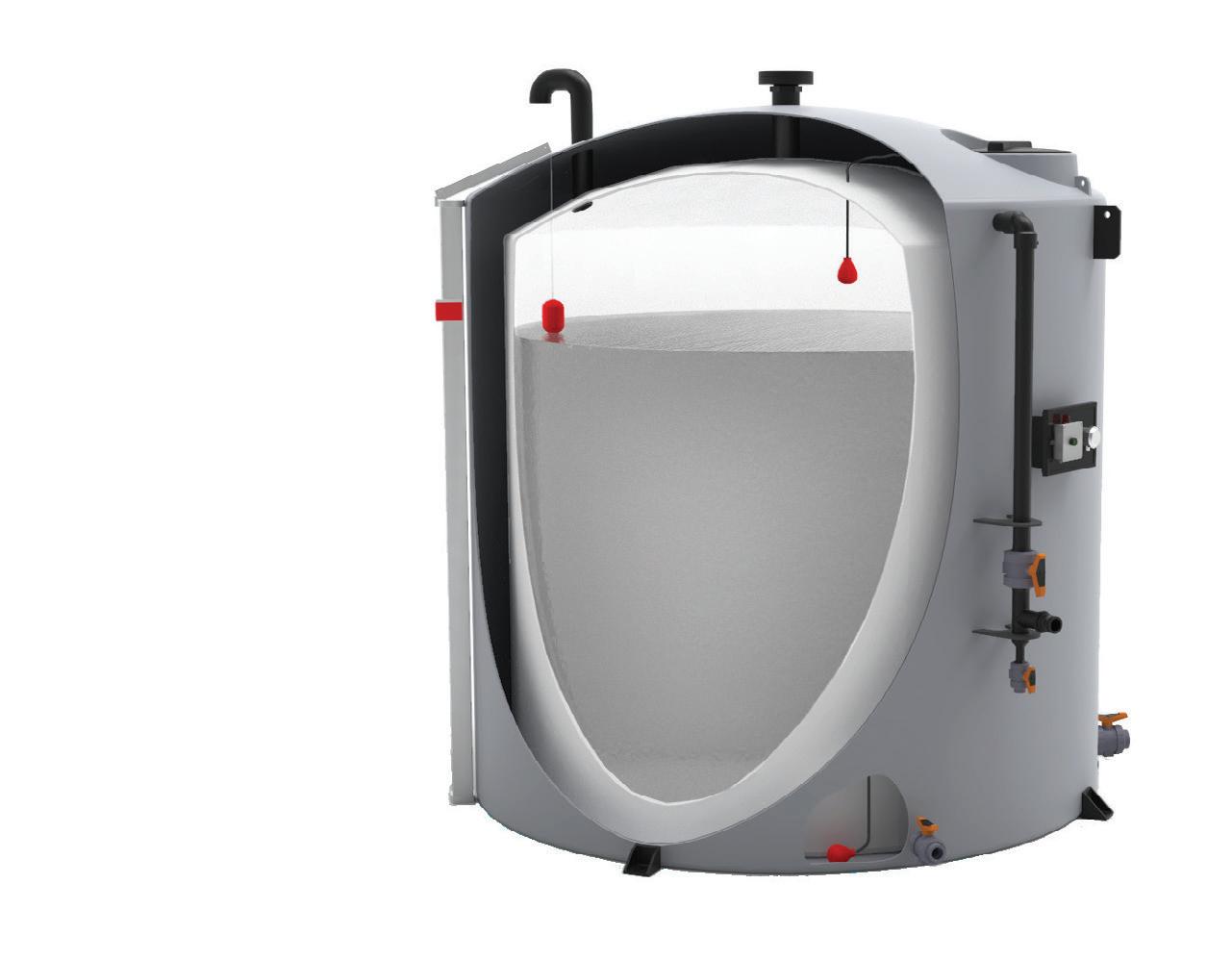
1300 062 064 | polymaster.com.au See our range 25 YEAR DESIGN LIFE
TECHNOLOGY REDUCING COSTS FOR PUMP MAINTENANCE AND DOWNTIME FOR WATER UTILITIES
Monitoring and maintaining the infrastructure of Australian water utilities is an expensive and ongoing commitment, particularly as often assets are aging and deteriorating. The distance between assets in these large networks also adds to the cost of maintenance.
Advances in machine learning algorithms are enabling Siemens to work with water and wastewater utilities to help reduce maintenance expenditure through the early detection and identification of potential failures in water and wastewater pumping stations.
At its Australian headquarters in Melbourne, Siemens engineers have developed SIDRIVE IQ Snap Advanced Health Analytics, a vendor-agnostic solution that uses data already gathered by water utilities, overlayed with the Siemens algorithm.
“Through the early detection of abnormal conditions in water and wastewater pump station drive trains, pump station operators have greater transparency over their assets and more control over their maintenance planning,” Dr Liam Pettigrew, a Senior Data Scientist at Siemens Australia, said.
“The algorithm analyses long-term trends in existing SCADA data to see how a particular pump has been operating over time and how current operations compare, providing real-time updates on the condition of the asset.
“When an irregularity is detected, it sends an alert to the operations team informing them to send maintenance teams to investigate. Predictions of a higher failure risk on pump drive trains in both water and wastewater pumping stations occur from one day to over 14 days in advance of actual breakdowns occurring.”
MAKING DATA-DRIVEN DECISIONS
Dr Pettigrew said undertaking a digital overhaul of a vast number of assets and pumps can be daunting for utilities, and recommends starting with the existing data from their SCADA and asset management systems to see what value can already be added before installing any new hardware and sensors.
Through SIDRIVE IQ Snap, Siemens clients have the ability to predict the estimated time until event failure which is provided through a live dashboard, automated failure notification and automated monthly reports. Critical information is continuously pushed from the pump station drive train and aggregated in a secure web portal for aroundthe-clock visibility of pump drive train operation and status from any location.
This continuous monitoring and feedback provides the necessary information to make data-driven decisions that move the industry towards its goal of a full prescriptive analytics solution.
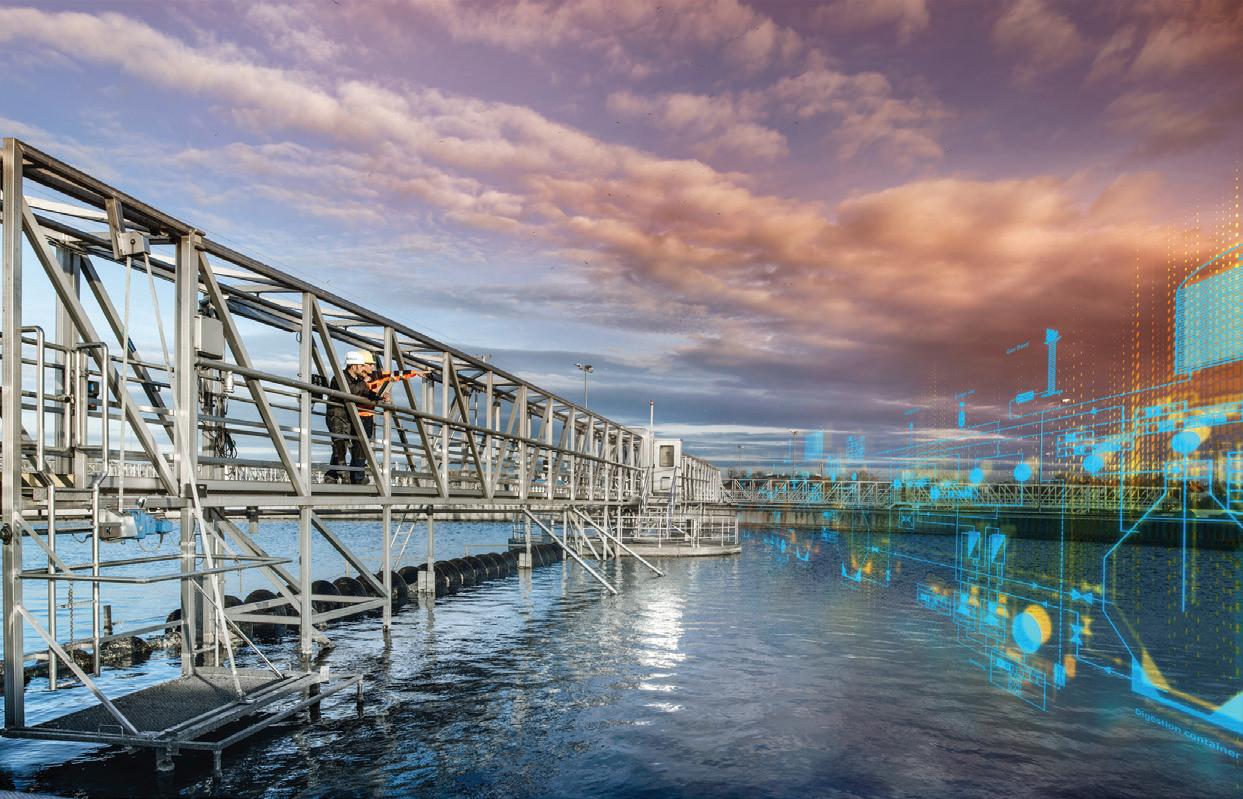
“Our clients are finding true value in the SIDRIVE IQ Snap Advanced Analytics Platform. The ability to detect abnormal operation and predict failure/imminent failure of pump stations drive trains has allowed for better maintenance planning.
“This has reduced OPEX costs associated with maintenance and inventory whilst also improving safety through the reduction of required site visits and emergency breakdown repairs. Siemens customers are seeing positive improvements in plant standstill versus uptime,” Dr Pettigrew said.
SAFETY | Sponsored editorial
For more information, please visit www.siemens.com.au
74
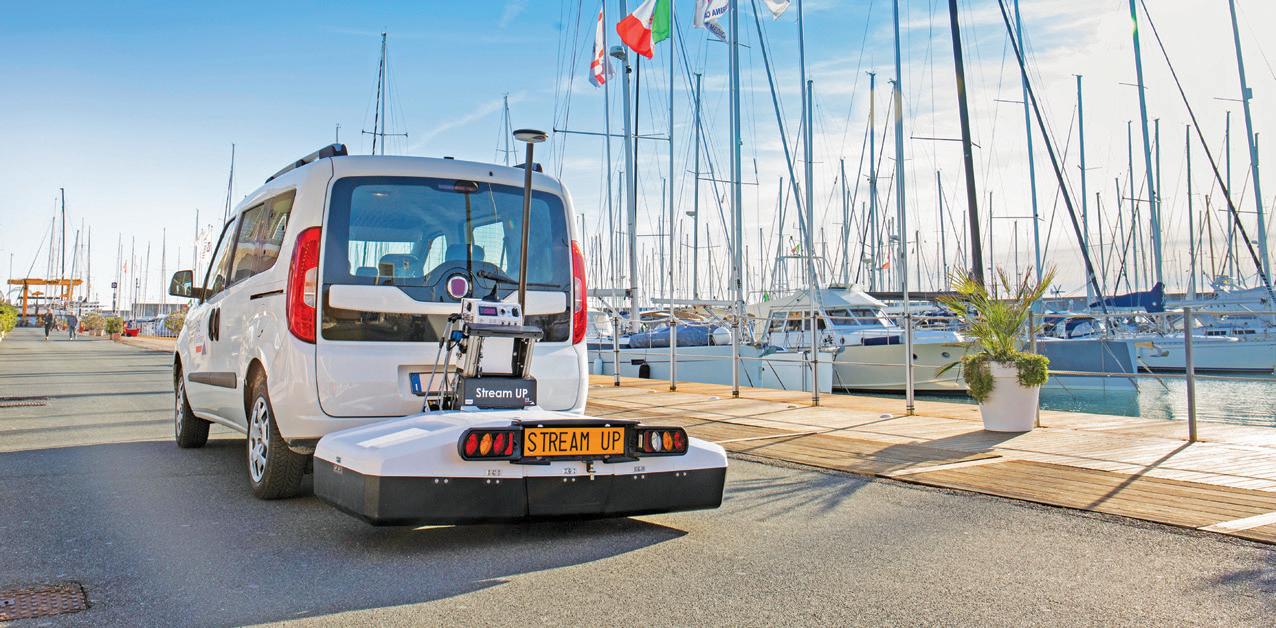
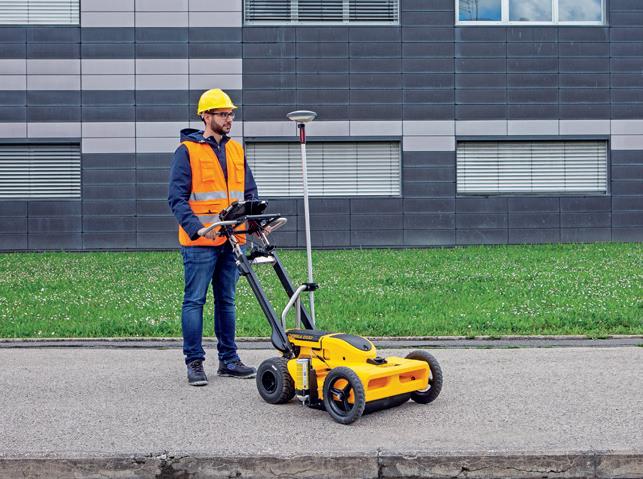
The leader in multi-frequency and multi-channel Ground Penetrating Radar
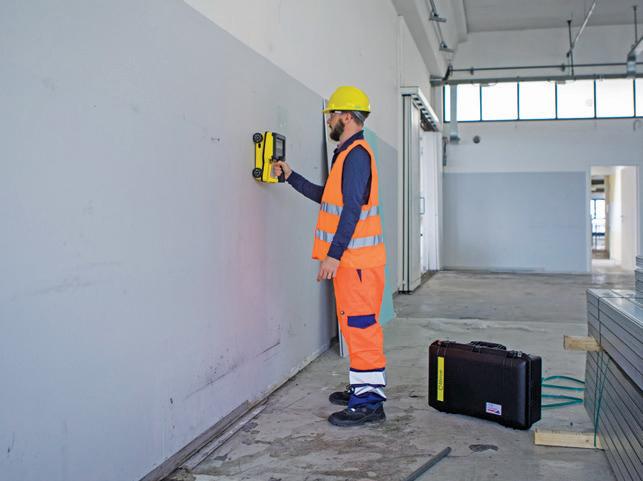
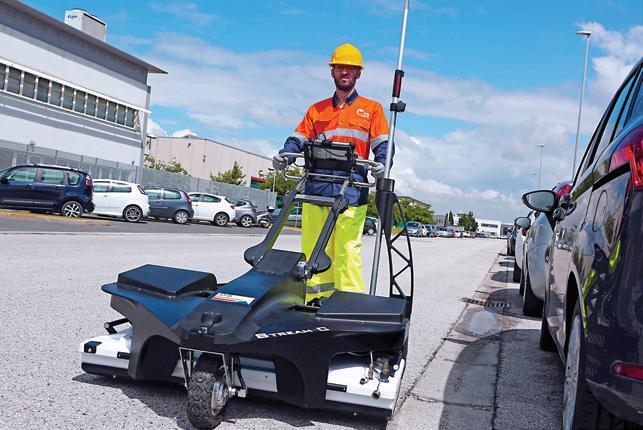

C-thrue – See Thru Concrete Structures and Reveal True Data: all-in-one dual polarisation GPR for accurate scanning and real time analysis of shallow and deep targets in concrete structures.
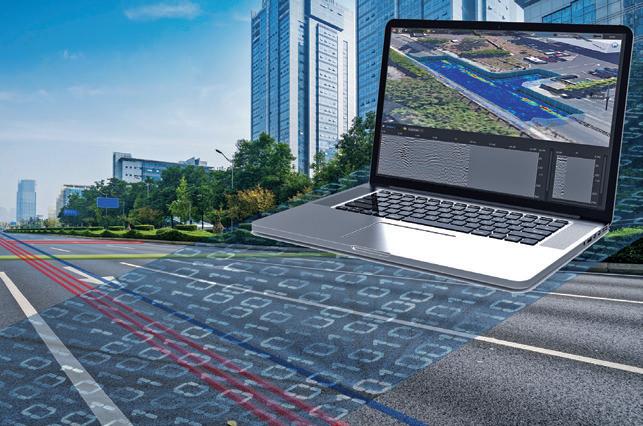
IQMaps: a new post-processing software application for advanced GPR data analysis with real time processing and 3D visualisation.
www.idsgeoradar.com/products/ground-penetrating-radar or contact Mark Bell from the IDS Georadar Brisbane Office
Email: mark.bell@idsgeoradar.com
Stream UP: a multi-channel, multi frequency, double polarized and lightweight GPR system for high speed utility mapping of large urban areas.
For more information please visit our website
//
: 07
8874
Phone
3117
Opera Duo: dual frequency two antenna GPR system for visualising shallow and deep utilities.
Stream C: high quality, high productivity and simple to use compact array radar system for accurate real-time 3D mapping of utilities.

ALBANY TO DENMARK PIPELINE SECURES
DENMARK'S WATER FUTURE
UTILITY • NOVEMBER 2021 WWW.UTILITYMAGAZINE.COM.AU 76 HORIZONTAL DIRECTIONAL DRILLING
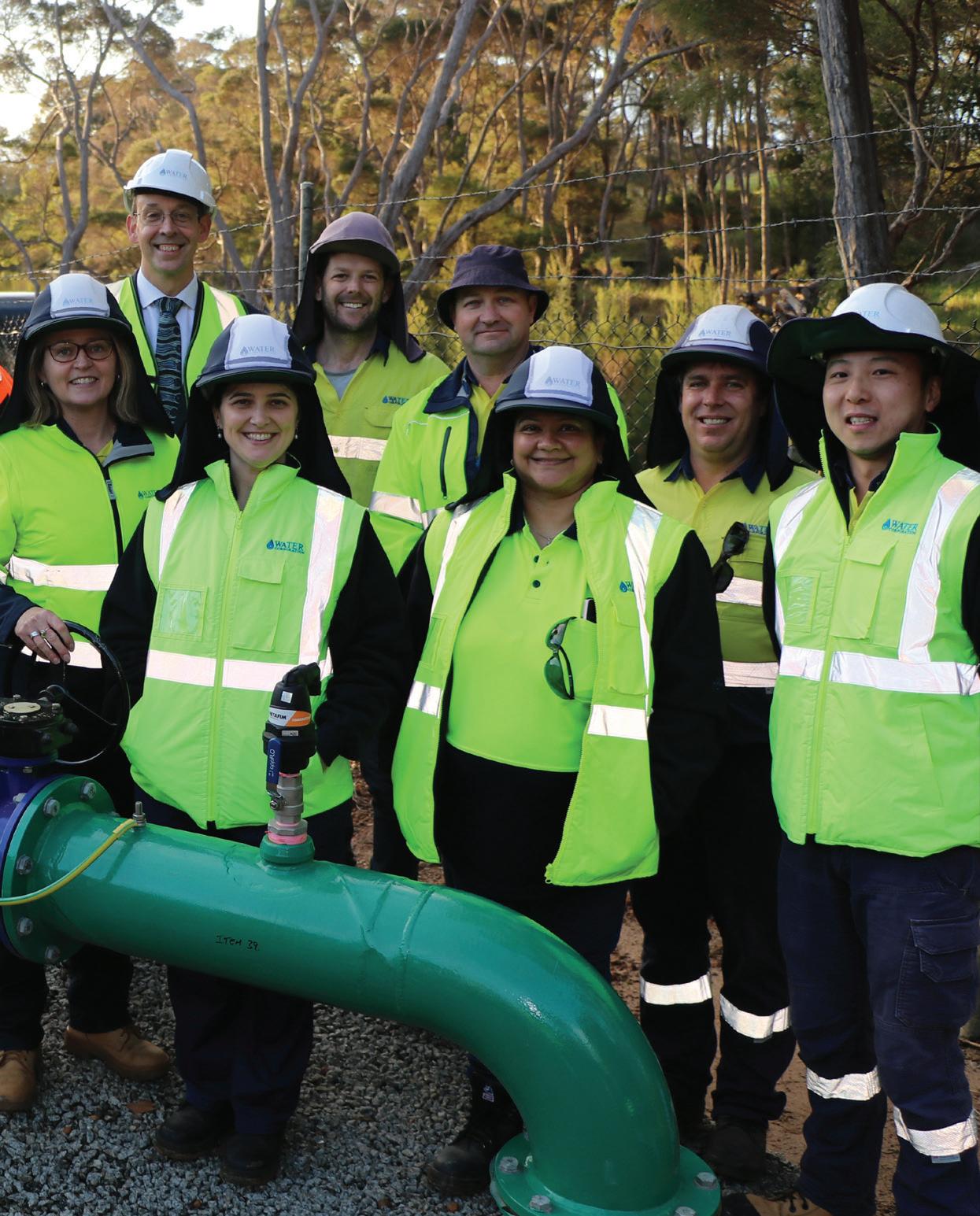
Water Corporation recently completed a major 43km pipeline to future-proof water supply to the town of Denmark, with Horizontal Directional Drilling techniques employed to help the project avoid disruption to three river and waterway crossing reserves.
UTILITY • NOVEMBER 2021 WWW.UTILITYMAGAZINE.COM.AU 77
HORIZONTAL DIRECTIONAL DRILLING
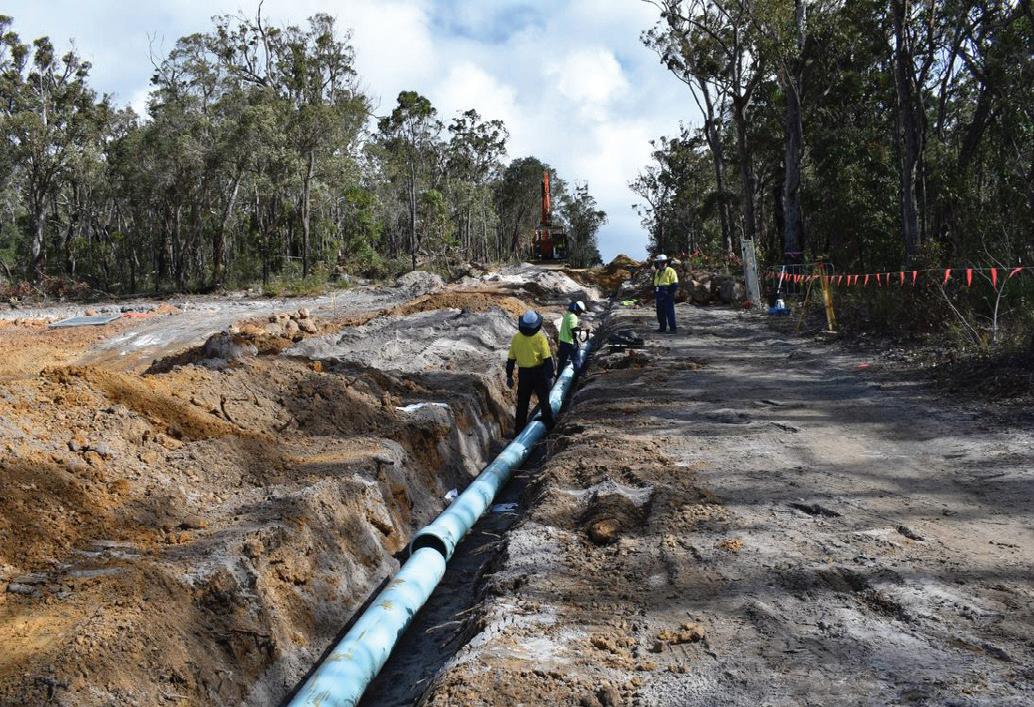
Situated on Western Australia’s picturesque south coast, Denmark lies within one of the most climateimpacted regions anywhere in the world.
Just two years ago the town was facing Stage 5 water restrictions and possible supplemental water carting after four of its driest years on record. Simply put, rainfall was no longer a reliable water source for the growing community.
In 2019, the WA Government announced plans for a $25 million, 43km pipeline connecting Denmark to the Lower Great Southern Towns Water Supply Scheme, which supplies the nearby port city of Albany and several smaller communities.
The project was designed to secure Denmark’s water supply into the future by ensuring it was no longer solely reliant on rainfall into the town’s largest dam, Quickup Dam.
Construction began in July 2020 and was carried out over a nine-month period. The 43km pipeline – consisting of approximately 7,200 lengths of 250mm PVC – was installed by Western Australian-based civil construction contractor, Georgiou Group. Further work involving mechanical, electrical and instrumentation control, was completed by Australianowned contractor Guidera O’Connor.
Construction was carried out under strict environmental and regulatory conditions, which included:
• Minimal clearing of native flora - less than 200 square meters allowed for the entire 43km pipeline
• Rare and threatened flora to be protected along the pipeline route
• No construction work to occur within river and waterway reserves
HDD ALLOWED FOR MINIMAL DISRUPTION
Working with Georgiou Group and design consultancy Jacobs Engineering, the project team was able to further reduce the total amount of clearing to just 144 square meters. Furthermore, not a single tree was removed during construction thanks to careful route planning through precleared areas such as farms, road reserves and firebreaks.
A local ecologist was engaged to identify rare and threatened flora along the pipeline route. Identified flora was then barricaded for the duration of the construction, ensuring it remained undisturbed while the pipeline was installed.
The pipeline traversed three river and waterway crossing reserves. To avoid construction within each of these reserves, Horizontal Directional Drilling (HDD) specialist CD Drilling was engaged to carry out drill shots at each crossing. HDD techniques allowed the pipeline to be installed seamlessly underneath waterways, with all construction activities occurring outside the reserve boundaries.
HDD works took place over a two-month period using a Vermeer D60x90 drill rig to drill a 400mm diameter hole underneath each river crossing. The rig then pulled the 315mm diameter HDPE pipe through the hole, before pumping cement into the cavity to seal it in place. The largest drill shot length was around 193m beneath the Hay River.
STRONG PUSH FOR LOCAL COMPANIES AND MATERIALS
The project was ultimately completed within its $25 million budget, with a strong focus on creating employment opportunities through the hiring of local workers and use of local materials and services.
UTILITY • NOVEMBER 2021 WWW.UTILITYMAGAZINE.COM.AU 78 HORIZONTAL DIRECTIONAL DRILLING
To encourage local industry participation, businesses were invited to register for subcontracting opportunities prior to the tender process beginning. This was announced via the project website, as well as through Water Corporation and Local Government social media channels.
The approach proved incredibly successful, attracting interest from 63 local businesses and ultimately leading to over $6.2 million being invested in the local community.
As well as positive economic outcomes, the project also created employment opportunities for 13 Aboriginal people and three Aboriginal-owned businesses during construction.
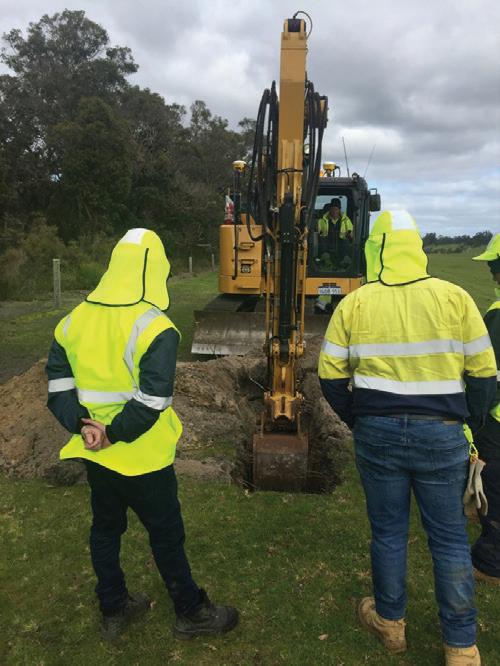
SECURING FUTURE WATER SUPPLY
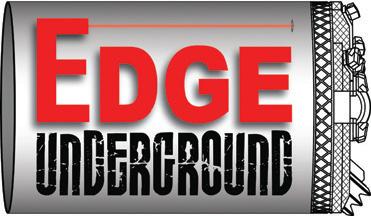
ABOUT US
Edge Underground is a precision microtunnelling contractor that operates in Australia and the USA. With a focus on innovative technology and expertise, Edge Underground designs and enhances the performance of trenchless equipment.
OUR SERVICES
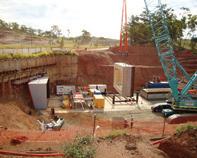

With the project now complete and the pipeline ready for operation, Water Corporation will monitor water levels at Quickup Dam and assess when to bring the new pipe online. This is currently anticipated for around mid-2022.
In the long term, it is expected that Denmark will be supplied via the pipeline in winter and spring, alternating to Quickup Dam in summer and autumn when demand is higher.
The pipeline is capable of supplying Denmark with up to 2.2 million litres of water per day under gravity flow from Chorkerup tank (part of the LGSTWSS). Further capacity is available to increase this to four million litres per day as the town’s population grows in the future.
In Western Australia, the impacts of climate change on rainfall are stark. For Water Corporation, this means futureproofing projects like the Albany to Denmark Pipeline are going to be increasingly vital to ensuring communities and customers continue to enjoy a reliable supply of high-quality drinking water.
• Microtunnelling
• Pipe Jacking
• Thrust Boring
• Laser Tunnel Boring
• Box Culvert Jacking
•
quotes@edgeunderground.co 8 www.edgeunderground.co ( JACKED 1300 522533
Canopy Tubes GUIDED BORING SPECIALISTS *
HOW HDD SUPPORTS INFRASTRUCTURE ASSET RESILIENCE
The Australian infrastructure sector faces many challenges, including aging assets, digitalisation, and the increasingly intense effects of climate change. Individually they are difficult to manage, but together they present both a perfect storm and an opportunity for innovation. Here, Maxibor explores how Horizontal Directional Drilling (HDD) can provide innovative solutions to facilitate infrastructure resilience in these challenging times.
Maxibor is an independent, Australian-owned HDD design and construct company with operational bases in Queensland, New South Wales and Victoria.
Maxibor provides HDD services across the water and sewer, rail, power, gas, telecommunications, mining, defence, fuel, sea cable, data centre and renewables sectors.
It has one of the largest HDD fleets in Australia including maxi-rigs, midi-rigs, rock-rigs and smaller rigs, with capacity to complete pipeline bores from 20m to 3km in length, with diameters from 63mm to 1.6m in diameter.
MEETING ENVIRONMENTAL REQUIREMENTS
The accelerating impact of age is besetting Australia’s key infrastructure assets across the water and sewer, power and telecommunications sectors. Their current condition makes them all much more susceptible to the impacts of severe climate events in the form of wind, fire, flood, erosion, drought and inundation. Even road and rail assets are becoming exposed.
The digitalisation of critical infrastructure asset management, and the almost total functional dependency of the broader community on technology, makes the security of services and the resilience of assets a priority for all Australians.
Parallel to this is the growing need for government and private sector infrastructure investments to meet Environment, Sustainability and Governance (ESG) requirements. Both ESG and climate are at the top of funders’ risks and they want to be able to demonstrate that they are investing in a way that optimises outcomes for all stakeholders.
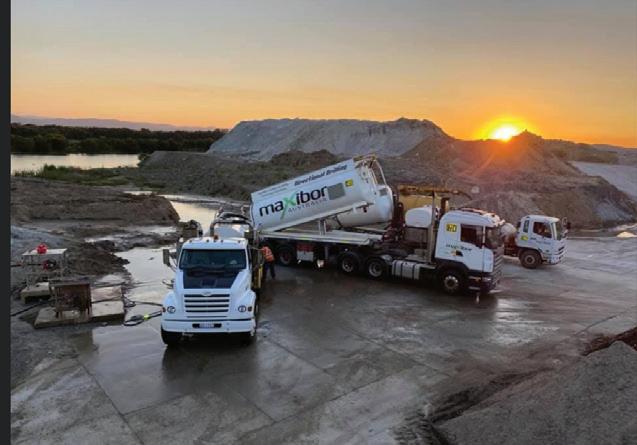
In this context, trenchless technology, particularly HDD, can provide solutions which are compatible with the critical needs of funders, asset owners and the broader community.
COLLABORATION BETWEEN THE INFRASTRUCTURE SECTOR AND HDD INDUSTRY
Installing infrastructure ‘down under’ is an apt solution for Australia. Having telecommunications and electricity assets underground provides many obvious safety and environmental benefits. You just need to look at the ravages of the more extreme weather events like the 2019-20 bushfires to see that having infrastructure securely installed at depth provides for a safer community during these events. It also facilitates the recovery process, as services can be restored faster, meaning business and life can get back to normal within a shorter period.
But how can the infrastructure sector work with the HDD industry to achieve greater infrastructure asset resilience?
Early involvement in projects is where most value can be added. Whether it be concept development or early design, early-stage involvement of HDD design and delivery expertise can bring innovative ideas and ultimately better solutions to challenging infrastructure projects.
HDD Engineering’s Stephen Loneragan – one of Australia’s leading and original HDD design engineers with experience in complex multidisciplinary global projects – said application of early HDD design and delivery expertise to projects is particularly important in the face of new challenges presented by climate change.
“Having the combined HDD engineering design and contractor delivery experience at the project table will enable more informed decisions to be made and outcomes optimised,” Mr Loneragan said.
UTILITY • NOVEMBER 2021 WWW.UTILITYMAGAZINE.COM.AU 80
HORIZONTAL DIRECTIONAL DRILLING | Sponsored editorial
This is reflected in Maxibor increasingly being required to provide insights into how HDD can create solutions to projects. Input to early design concepts, together with informed construction methodology options and costings, all assist project stakeholders in making better early decisions.
Maxibor Owner and CEO, Rodney O’Meley, said, “Our push for early cooperative involvement in projects reflects the importance we place on the longer-range view – if a project is designed well, its chances of successful delivery and longer-term value are much more likely to be better achieved.
“Investment in disaster resilient infrastructure needs to be seen not as an additional expense, but as an opportunity to create shared value for businesses and society”.
HOW ELSE CAN HDD BE PART OF THE SOLUTION?
On major new projects such as Inland Rail, Snowy 2.0 and gas pipelines, the use of HDD to install infrastructure in more environmentally and culturally sensitive areas helps to, not only protect the infrastructure long-term, but also preserve the environment during delivery and in extreme weather events.
A recent example where HDD has been able to provide innovation solutions is the sand backpass project on the Gold Coast. Maxibor is using HDD to install parts of the 7.8km pipeline to return natural sand to the areas where it has
been eroded. This will increase the resilience of these iconic beaches to more extreme weather events.
HDD also provides an ideal solution to assist with the landing of sea cables. HDD maxi-rigs are being used across Australia to achieve safer out to sea connections of international and local cables. HDD is also an important part in the installation of desalination plants to help mitigate the effects of drought.
In urban areas, installing fibre into data centres without disturbing the existing infrastructure and going under rivers, is contributing to the build of these privately owned assets with minimal impact on the community and environment. International cables and data centres are now integral in providing the technology we all depend on daily. HDD helps to install them safely and for them to be maintained in a resilient manner.
The use of emissions-friendly electric rig spreads such as Maxibor’s Gallagher HDD660e maxi-rig (The Hulk) is also assisting in a cleaner and quieter delivery of HDD services, especially in well-established metropolitan areas.
In 2021, the trenchless industry in Australia is celebrating its 30th year and Maxibor’s staff have been there for most of those three decades. Now, more than ever, is an ideal time to seek out and understand how HDD can be part of the infrastructure asset resilience solution in the face of climate change.
»
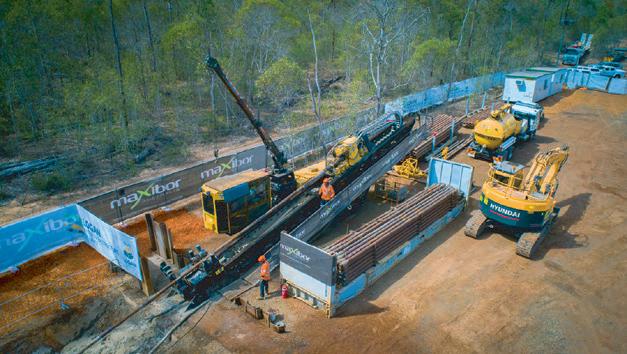
UTILITY • NOVEMBER 2021 WWW.UTILITYMAGAZINE.COM.AU 81
editorial | HORIZONTAL DIRECTIONAL DRILLING AUSTR ALIA’S LEADING HDD SPECIALIST Maxibor is using its network of experience to deliver better project outcomes to asset owners and principal contractors alike 02 4966 5583 www.maxibor com.au admin@maxibor com.au Follow us on LinkedIn, Facebook & Twitter » Quality and collaborative HDD design and construct services
Expertise to advise at the
time in the project delivery cycle
Gas, water and sewer, rail, road, power, telecommunications, mining, residential development and renewables
Maxi-rigs capable of long and wide
Sponsored
»
right
»
»
diameter bores in hard rock and difficult conditions
Build a future we
to. For more information contact David Turner on 0499 375 511 or visit www.maxibor.com.au.
all look forward
CELEBRATING 85 YEARS OF INNOVATION
Leading pipeline infrastructure company, Interflow, is celebrating its 85 th year of uplifting communities through the provision of world-class water and wastewater services. As the company approaches this incredible milestone, its people are pausing to reflect on their journey that has been characterised by innovation, agility, and a steadfast dedication to solving customers’ problems.
Interflow is Australia and New Zealand’s leading provider of trenchless pipeline infrastructure solutions. Throughout its history, the organisation has pioneered technologies and renewal methods that have received national and international recognition for their industry-leading status.
From day one, the organisation’s founder, Harold ‘Bill’ Weaver, was committed to ‘challenging the status quo’. In 1936, Bill set out on a mission to support the growth of budding communities along the east coast of Australia, through the construction of water, sewerage and drainage systems for developing towns. As a result of Bill’s ability to identify gaps in the market and develop services to meet the needs of his customers, the company was able to expand its operations across the country.

A GENERATION-LED, FAMILYOWNED BUSINESS
Over the years, the leadership of Interflow has been handed down from father to son, for three generations.
The organisation’s current Managing Director, Geoff Weaver, has been responsible for expanding Interflow’s operations across Australia, establishing international operations in New Zealand, negotiating two twentyyear exclusive Australasian licenses for
spirally wound rehabilitation products, and taking a leading role in the development of trenchless technology.
Geoff said the company’s ongoing success has been guided by the core values laid out by his grandfather.
“My grandfather’s ethos was simple. He was committed to challenging the status quo and finding new and better ways to do things,” he said.
“He strove to ensure that every action taken by the company, both in the way it treated its people and customers, reflected the core values of honesty, reliability, competence and respect.”
Geoff said that in addition to these core values, Interflow’s success should be attributed to the commitment and dedication of its people.
“Interflow’s innovation has always been spurred by two simple questions: What do our customers need, and can we challenge ourselves to do better?”
Geoff said this passion has led to the development of many world-class technologies that changed the civil engineering landscape forever.
“As early as the 1990s, we pioneered the use of trenchless technology to improve project efficiency, reduce
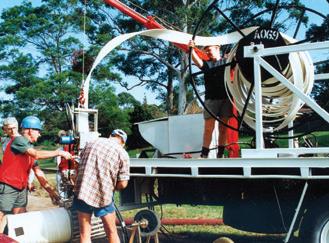
costs and minimise any impact to the environment and community,” he said.
“Each generation of leadership has been responsible for refining these methods and developing new technologies to further improve the experience of our customers and communities.”
As the company prepares for its anniversary celebrations throughout November, Geoff reflects on what the future may have in store.
“One thing is for sure, we will continue to grow, innovate, and challenge ourselves to be our best every day,” he said.
“As we celebrate this incredible milestone, we look forward to the next 85 years of supporting our customers and uplifting communities with pipeline infrastructure solutions for generations to come.”
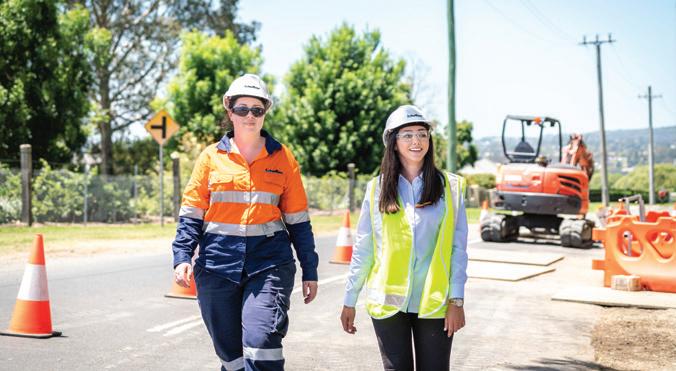
HORIZONTAL DIRECTIONAL DRILLING | Sponsored editorial UTILITY • NOVEMBER 2021 WWW.UTILITYMAGAZINE.COM.AU 82

“We look forward to the next 85 years of supporting our customers and uplifting communities.”
Celebrating 85 years of innovation
Geoff Weaver, Managing Director
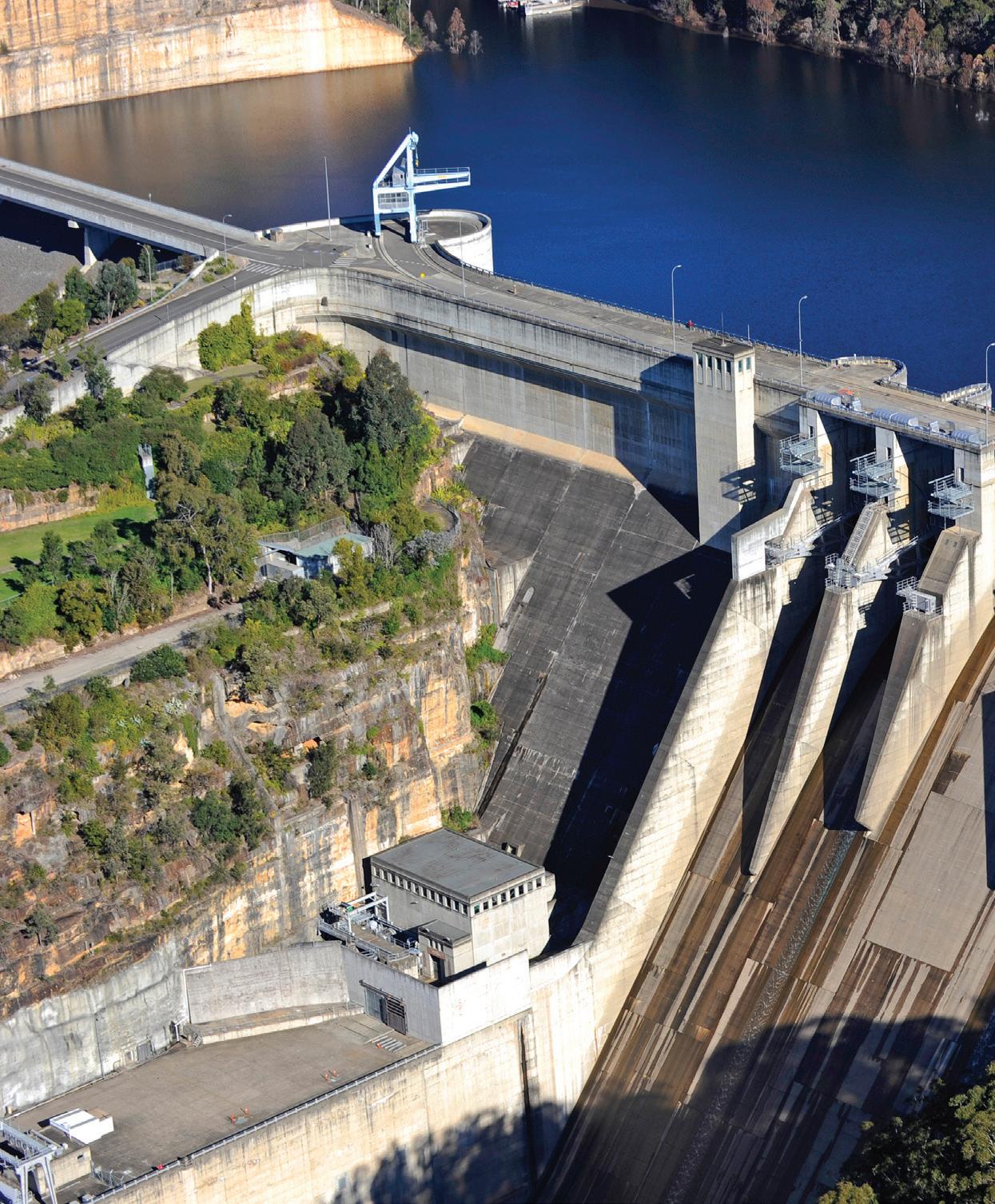
UTILITY • NOVEMBER 2021 WWW.UTILITYMAGAZINE.COM.AU 84
DAMS
Reimagining DAM SAFETY
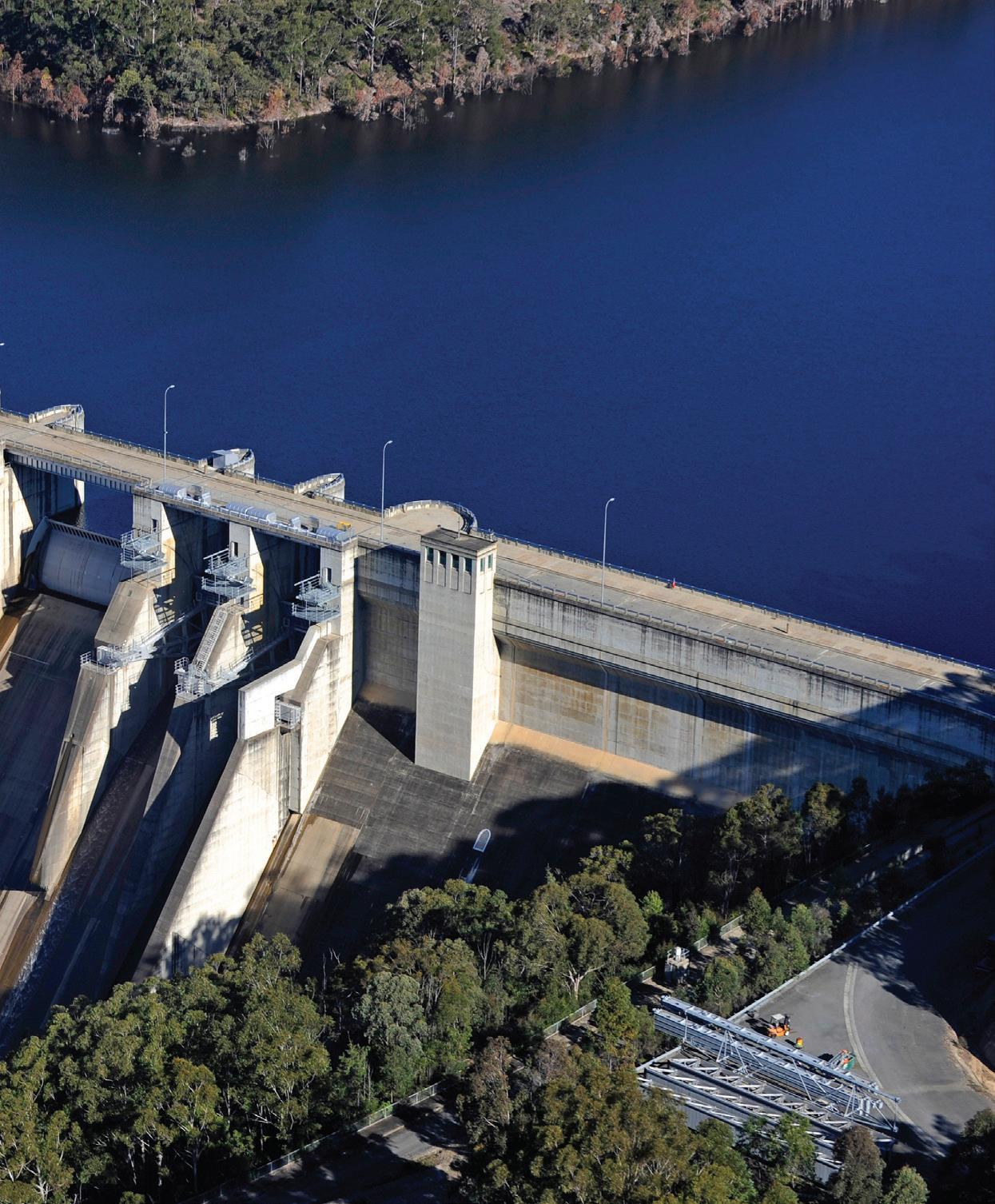
As the owner of most of the state’s large supply dams, WaterNSW gives the highest priority to the ongoing safety of its dams to protect people, property, and the environment from the harmful effects of failure or mis-operation of its dams and reservoirs.
UTILITY • NOVEMBER 2021 WWW.UTILITYMAGAZINE.COM.AU 85 management DAMS

Delivering Operational Excellence is one of the corporate strategic priorities, given that WaterNSW is the largest bulk water supplier in Australia. This drives the business to focus on excelling in the delivery of its core operations, by being a simpler, more efficient, and responsive business to better service the needs of its customers, community, and stakeholders.
As a learning organisation, WaterNSW is constantly scanning for good practice from other dam owners across the world, as well as other major hazard industries including aircraft, railway and nuclear. The benchmarking effort has enabled the business to define its desired state in areas such as management systems and processes, technology applications, advanced analytics, and data science.
The changes to dam safety regulations in NSW provided a burning platform that has inspired the business’ transformation drive. As such, WaterNSW is driven to actively contribute to the development and implementation of leading-edge industry practice.
SAFETY MANAGEMENT SYSTEM
WaterNSW has implemented some foundational elements that underpin its capability uplift in dam safety management. This includes the development and implementation of a Dam Safety Management System (DSMS) that conforms with the ISO 55001 Standard. This DSMS provides a framework for dam safety management activities, decision making and supporting processes.
DATA MANAGEMENT
At the heart of the dam safety activities is a robust surveillance program which is WaterNSW’s front line of defence for the safe operation of its dams and reservoirs. The primary objective of surveillance is to detect anomalies, and attract the attention of the responsible person in a timely manner to enable prevention measures to be taken to protect lives, property, and environment.
The key criteria for effective surveillance data, that enables engineering judgement and effective decision making regarding the safety status of the dam, are data variety, volume, and velocity. Thus, WaterNSW views data as the bedrock of a
risk-informed, data-driven decision support system for dam safety.
Hence WaterNSW built DamGuard, a bespoke mobile and cloud webbased data management solution. This replaced the traditional data capturing process of using handwritten surveillance sheets to mobile capture and storage of data in real or near real-time from both manual and SCADA information.
This information is stored in a data lake. The system has automated quality assurance, provides dashboards, and alerts for rapid assessment, and includes an analytical workbench for deeper modelling analysis.
DamGuard has accelerated the data collection process and frees up Dam Safety staff to spend more time on analysis and decision making. DamGuard was awarded an iTnews Benchmark Award in 2020 in the IoT category.
SEEKING DEEPER INSIGHTS THROUGH APPLICATION OF DATA SCIENCE
WaterNSW is now looking to maximise the value of the data in DamGuard. One area of initial focus is the development of new types of
UTILITY • NOVEMBER 2021 WWW.UTILITYMAGAZINE.COM.AU 86 DAMS
alarms which have a justifiable basis in dam safety risk, and are categorised in a way that dam safety engineers know the importance or urgency of each alarm and thus the priority with which they should act.
A Behavioural Alarm Discovery Project is underway that will identify a hierarchy of defensible alarms based on a data-scientific analysis of the historical record of surveillance data collected daily in DamGuard.
The Data Science approach will enable the extraction of knowledge from the large amounts of data through the application of advanced techniques including data mining, clustering/ classification, data modelling, machine learning and regression. In addition, a data scientific approach is expected to provide a more consistent, transparent and accurate assessment of conditions in all dams.
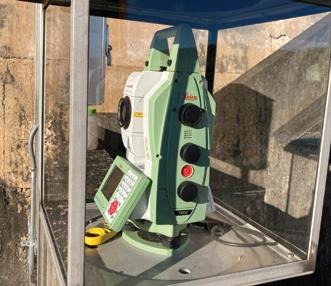
CAPTURING THE RIGHT DATA
In parallel with the development and implementation of DamGuard and its additional capabilities, the monitoring data to be captured must be designed or re-designed to consider potential failure modes associated with the higher levels of risk. They should be able to identify any abnormal behaviour which could lead to potential reduction of safety.
A Risk-Based Surveillance Method (RBSM) was developed and is now being applied across the portfolio to review the suitability of the current monitoring system and determine the optimum variety of critical information and instruments required. In some instances, additional instruments and sensors are needed. This is opening opportunities to adapt new technologies or modernise the system.
The RBSM evaluation has been completed at three dam sites. This
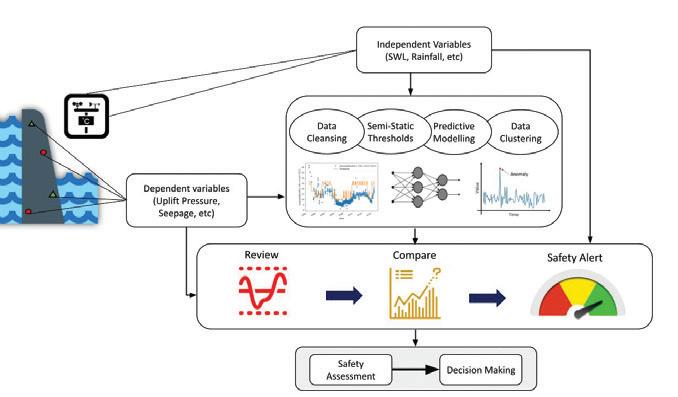
has resulted in a program of works to implement a comprehensive monitoring system, including the supply and installation of new instruments, and the retrofit and upgrade of existing monitoring equipment.
The monitoring sensors are telemetry based so that monitoring data is fed back automatically to WaterNSW’s SCADA centralised data platform. The Geodetic Survey Monitoring networks at these sites have been automated. The automated survey networks have been commissioned. The benefits from the near real-time monitoring, that includes improved warning time and less site presence by staff, have been instantly realised.
EMBRACING NEW TECHNOLOGIES
Extensive new developments in dam instrumentation have emerged on the dam monitoring market. Many of these developments are spin-offs of developments in other commercially viable fields of technology. The main advantage of some of these instrumentation methods is that they can be applied or installed in existing dams with relatively limited installation work.
One example of this is the evaluation of a satellite-based Interferometric Synthetic Aperture Radar (InSAR) technique at WaterNSW. The reliability and consistency of the InSAR methods has been found to be suitable for use in the long-term monitoring of dam deformations. This is now being considered for wider application across the portfolio.
EVIDENCE BASED DECISION MAKING
After all the expense and hard work of putting in place monitoring systems for a dam, then collecting data and information (including automated methods for some or all the instruments), and then storing and managing the collected data and information, the payoff comes in being able to assess the condition, performance, and behaviour of the dam accurately and confidently.
Furthermore, there is an urgent need to transition from the traditional reactive analysis to proactive evaluation using AI technologies, where an emerging threat to dam safety can be identified before it initiates, allowing more time to intervene.
In this case, the actual measured performance of dams will be compared to predicted values from Behavioural Analytical Models that are currently being developed. This promotes increased understanding of the dam in question. The effective and timely presentation of this information to dam safety engineers will enable quality insights and intelligence to be obtained that informs the safety evaluation and safety decisions.
Bill Gates said in his book, Business @ The Speed of Thought, “The most meaningful way to differentiate your company is to do an outstanding job with information. How you gather, manage, and use information will determine whether you will win or lose”. WaterNSW will continue striving to use data and information to make better safety decisions in near realtime.
For more information, please contact Sam Banzi, Head of Dam Safety and Engineering, WaterNSW at Sam.Banzi@waternsw.com.au.
UTILITY • NOVEMBER 2021 WWW.UTILITYMAGAZINE.COM.AU 87
DAMS
WATER LEVEL AND PRESSURE INSTRUMENTS TO MEET ALL APPLICATIONS
With growth in population and associated infrastructure, water is becoming more and more of a precious commodity. This means water market stakeholders need to find the best equipment and services to support water capture, storage and distribution.
Over the past 30 years, VEGA Australia has worked with the Australian water industry to understand, develop and manufacture level and pressure instruments that meet this requirement.
For the water industry, there are some criteria that cannot be compromised on, including: quality, suitability, reliability and performance. As a German manufacturer, VEGA understands the demanding needs of a vast array of installations and applications that vary across all sectors in this market.
By working with the industry, VEGA is able to offer solutions that fit the needs of these challenges. Whether that be as simple as a level switch, or a complex control loop, there is no one-stop solution. That is why, when it comes to applications, it offers a number of choices in each category that are defined as suitable for use, by the conditions of the applications.
DIFFERENT REQUIREMENTS AROUND THE COUNTRY
Being one of the major industries within Australia has allowed VEGA Australia to gain first-hand knowledge of what forms of technology suit the particular outcome required for
an application. That experience is shared within the water industry to take the gamble away from the client having to make assumptions, which can cause costly mistakes.
The Australian water industry makeup varies across all the states, and therefore VEGA needs to work at both a local and state level. For example, New South Wales regional councils are responsible for their water and wastewater infrastructure, but in Western Australia, the large majority is handled by Water Corporation.
Another uniqueness about Western Australia is the vast area it covers, requiring travel to these distant regions to service the customer as diligently as the metropolitan area. VEGA Australia recognises this, and has committed to covering these regions for many years. It has employed technical people to sell and support equipment as a standard, because support forms a major part of the respected relationship that has been created.
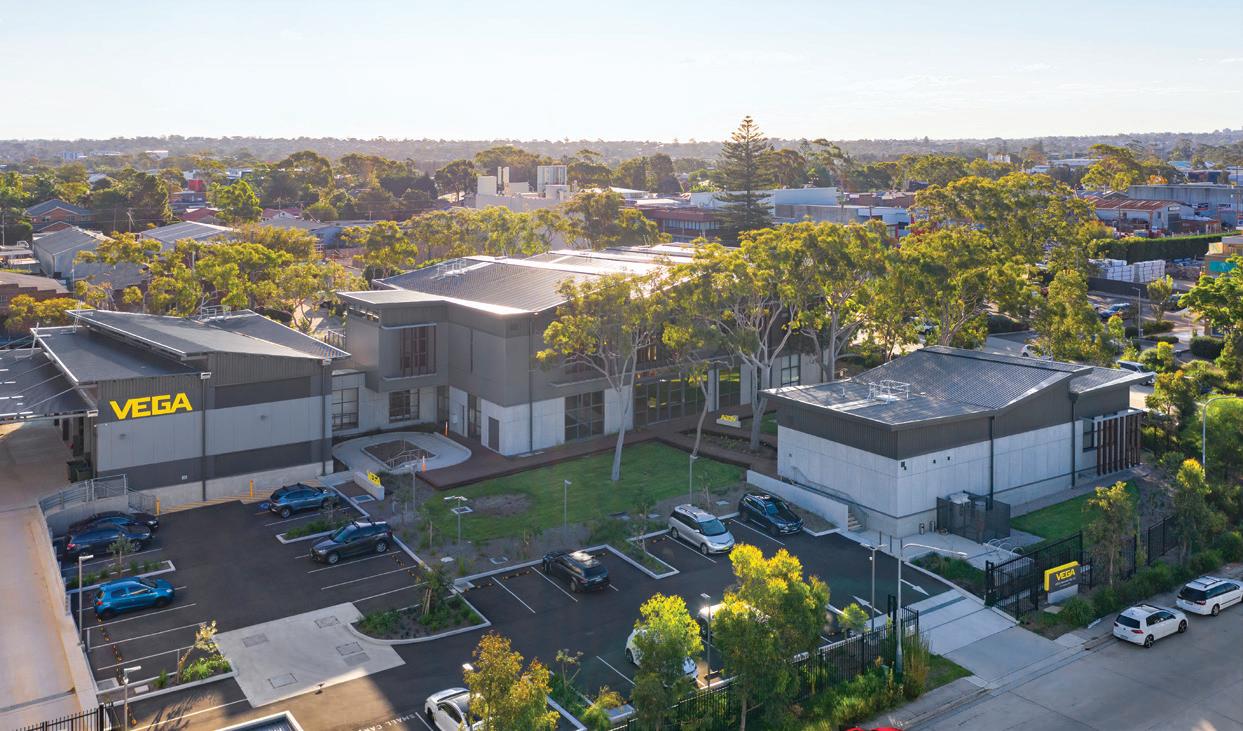
BLUETOOTH COMMUNICATION CHANGING THE GAME
Advancements in technology have also created requirements for instruments to work from batteries/solar panels and the digital form of output communications. VEGA
88
DAMS | Sponsored editorial
instruments are at the forefront of this advancement, as it has developed instruments that can operate on low voltage supplies and have industry-accepted outputs such as 4 –20mA HART, Modbus and SDI 12.
Another development has been the introduction of Bluetooth communication. VEGA received feedback from a number of industries that felt there was a definite need for a simpler way of programming and communicating with field mounted instruments. VEGA listened and took on the challenge by developing instruments that are Bluetooth enabled. It also recognised that there is a very large installed base of instruments already supplied and working in the field, so it made Bluetooth compatible with instruments that were manufactured as far back as 2002.
These days, most people have access to smartphones and tablets, which was the driver behind the development of the Bluetooth app VEGATOOLS. This free downloadable app (available from the App Store or Google Play stores) allows access to all VEGA instruments that have Bluetooth functionality, and for VEGA transmitters, this is almost 100 per cent. From the app, you not only have the ability to set up the instrument but also diagnostics to identify any abnormalities within the instrument. It also allows for the field technicians to access instruments in a location away from any unsafe working areas.
YOU HAVE TO KNOW WHAT YOU SELL
In the last two years the world as we know it has changed, and site access for visitors and service technicians has been heavily restricted. VEGA has acknowledged this and for a number of years has offered all its customers support, either via onsite practical training or remote technical support via a variety of communication protocols. At VEGA, it is not enough to just identify and offer the correct instrument, it is also vital to offer after sales support.
For the different technologies that VEGA offers, there is a mandate that all sales and support personnel are given in-depth practical training on the functionality of the instruments; because you have to know and
understand what you sell. There have also been challenges relating to international freight delays which have been mostly overcome by increasing the off-the-shelf stock within its Sydney warehouse. VEGA understands how these things can happen and that replacement speed is the number one requirement.
CONTINUOUS INNOVATION
VEGA is often asked by clients how much these technologies can be improved. This is always a great question, as technology advances quickly and VEGA’s R&D department is constantly working on improvements for the future. IIoT has set new standards and the ability for instruments to provide accurate up-to-date information on a constant basis is now seen as a basic function rather than a ‘nice to have’. These developments are partly driven by the industry as needs and requirements change and improve. VEGA takes all feedback onboard and, if feasible, sets to work to offer a solution.
Focusing on the development and manufacture of level and pressure instrumentation has allowed VEGA to concentrate its resources into these two important forms of measurement technologies. Its recent release of water industry based instruments has proven that it has met the needs and requirements for the industry. As with all technology developments, the units have become more compact while increasing their ability to offer reliable, accurate and fit-for-purpose application solutions.
So whether you are looking to monitor a dam level or deep water bores, the upgrade of open channel flow into a treatment plant or the pressure of liquids within pipes and pumps, or even the monitoring of levels within added chemical tanks, VEGA can offer best in class suitable instruments, that can give you the satisfaction that a solution is available and proven in field.
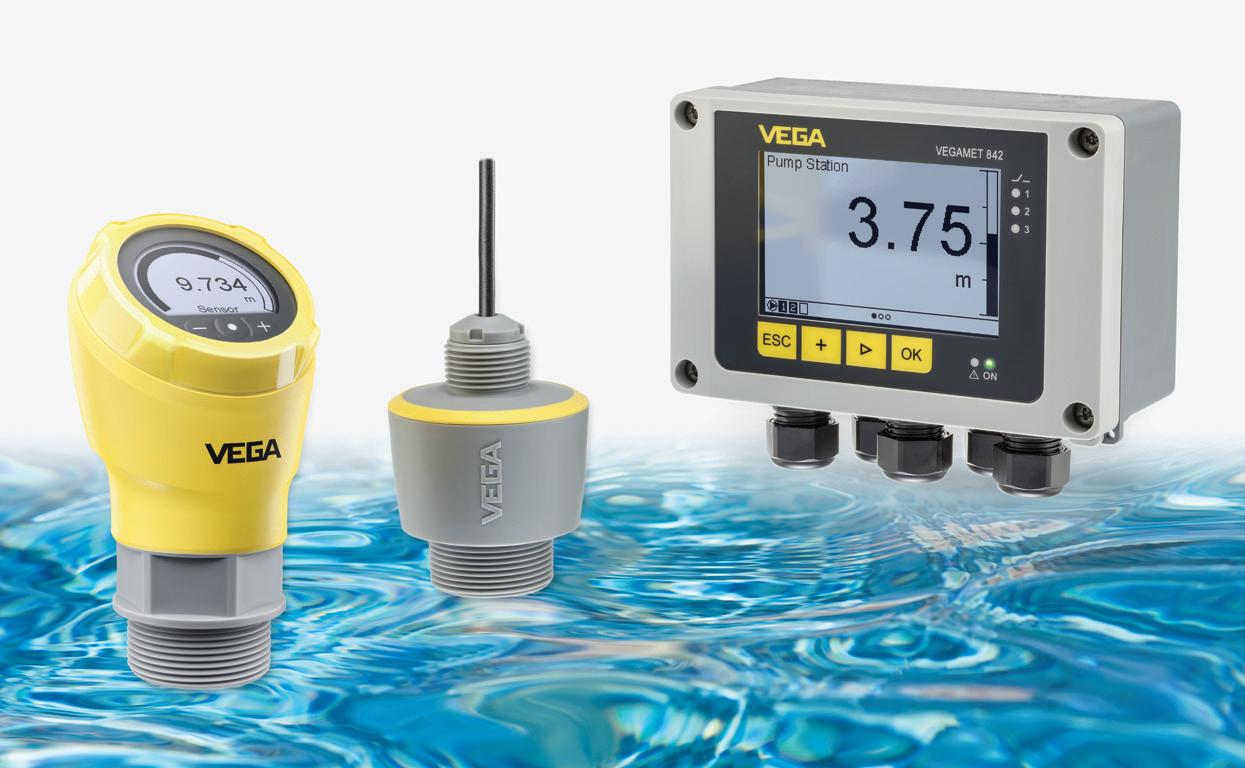
Sponsored editorial | DAMS
89
MICROTUNNELLING
What are the benefits of selecting a microtunneling contractor with versatile equipment?
When it comes to microtunnelling, there are a number of challenges that can derail a project, costing time and money. That's why choosing a contractor with versatile equipment is important, as it increases the likelihood that your project will successfully be completed on time and on budget.
One of the key benefits to selecting a microtunnelling contractor with versatile equipment is the reduction of risk throughout the project delivery.
When working with versatile equipment, a project is able to adapt – this, along with knowledge surrounding the existing ground conditions, can dramatically reduce risk in a microtunnelling project.
Versatility is especially crucial considering the geotechnical information provided at the start of a project isn’t always 100 per cent accurate, and contractors often arrive on site to find different conditions than were expected – with unexpected ground conditions a common reason for project delays or installation failure.
Versatile equipment means that even if contractors can’t predict what lies beneath them, they can be assured the equipment can get the job done, despite unforeseen issues.
The AXIS laser guided boring system is a versatile pitch-launched microtunnelling machine, designed to provide contractors with a versatile solution that combines productivity, accuracy and efficiency.
Rather than jacking it into unconfirmed ground conditions, which can be risky, the AXIS uses vacuum extraction to perform a pilot line, allowing the contractor to visually inspect the ground and select the best drill head for the prevailing ground conditions, before committing to jacking the final line.
CHANGING CONDITIONS ARE HANDLED WITH EASE
Another factor for contractors to consider are ground conditions, which can be notoriously volatile during microtunnelling projects. Different ground conditions – such as varying soil types, groundwater conditions, the presence of rock and debris, and fractured rock and sand – require different drill heads and approaches.
This means an unexpected change to the ground midway through jacking can be time consuming and costly, as most machines are only designed to move forward and the drill head will need to be dug out from above in order to change it.
The AXIS guided boring system is the only machine on the market designed to deal with changing ground conditions, using technology that allows it to retract.
DIFFERENT PIPE MATERIALS AND DIAMETERS CAN BE USED
Versatile guided boring systems such as the AXIS also have the ability to use different pipe materials and diameters for different projects.
This versatility provides contractors with more options to select the best material and diameter for the ground conditions, traditional preference and project specifications, such as costs and matching with existing infrastructure.
Usually microtunneling equipment relies on the use of a jacking pipe to transmit thrust from the jacking station, to the drill head, to progress the line.
This means that customised drill heads are needed to allow for the installation of different sized pipes – this can be costly, especially if the contractor isn’t going to use the pipe size often or ever again.
As the AXIS guided boring system uses vacuum extraction where, self supporting ground, the force on a pipe is just its own weight – this means that any type of pipe can be used, it’s just the ground conditions that determine what type.
This means it can install a range of piping materials, such as PVC, PVE, clay, concrete, steel encased, ductile iron and HDPE – a mix of high and low strength materials.
Furthermore, the AXIS guided boring system only requires one drill head to complete a pilot line. When it is finished, the reaming tool, which is relatively inexpensive, just needs to be changed to suit the diameter required.
The system is regularly used to install pipes in the 300-600mm range, boasting projects up to 900mm; this is because the system can install pipe using the pilot and pull back method, or the jack and ream method.
From reducing risk, avoiding project delays from changing ground conditions and allowing for a variety of pipe materials and configurations, there are multiple benefits to selecting a contractor with versatile microtunnelling equipment.
ABOUT STUART HARRISON
Global microtunnelling pioneer Stuart Harrison is the Managing Director of Edge Underground, where he specialises in on-grade microtunnelling installations with millimetre accuracy.
Stuart is also the inventor of the AXIS Guided Boring system, and he is constantly working to improve the effectiveness of this and other trenchless systems used in the installation of gravity sewers.
To discuss your next microtunnelling installation, contact Stuart on 1300 JACKED or at stuart@edgeunderground.co
90 UTILITY • NOVEMBER 2021 WWW.UTILITYMAGAZINE.COM.AU
BRISBANE 16-18 MARCH
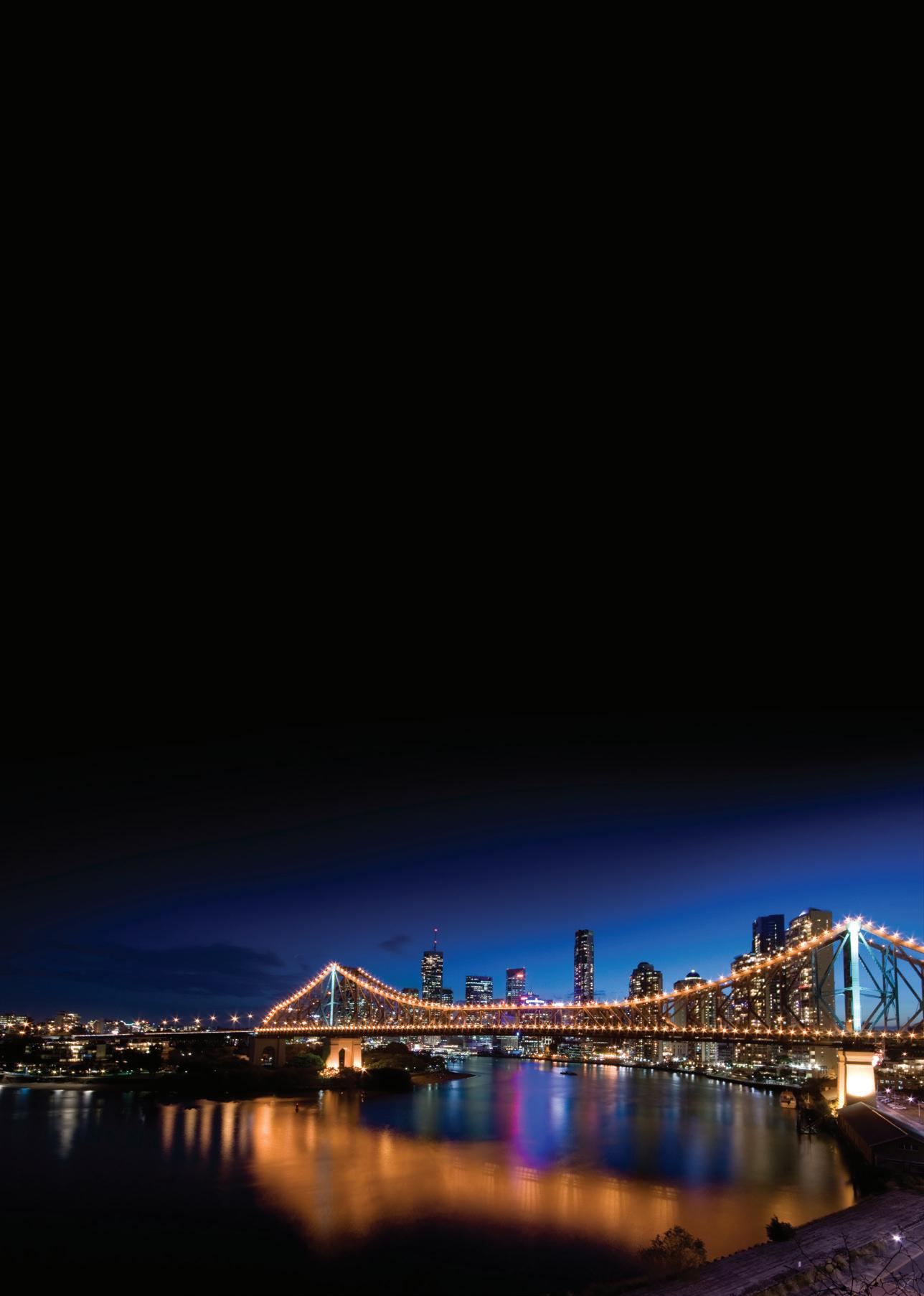
Brisbane Convention & Exhibition Centre
Exhibition + Sponsorship Opportunities are still available!
For further information visit: www.EN2022.com.au
New dates announced
PRINCIPAL SPONSOR
MAY 2022
EVENT DISTRIBUTION (TBC)
OZWATER
MAJOR FEATURES
WATER MANAGEMENT
DEMAND MANAGEMENT
ENERGY NETWORKS
SUSTAINABILITY
SPECIAL FOCUS
INSPECTION, CCTV & CONDITION ASSESSMENT
MOBILITY
VEGETATION MANAGEMENT
ENERGY STORAGE
FUTURE FUELS
2022
NOVEMBER 2022
EVENT DISTRIBUTION (TBC)
MAJOR FEATURES
RENEWABLES
CORROSION
DISASTER MANAGEMENT
RETAIL, BILLING & CRM
SPECIAL FOCUS
TRANSFORMERS & SUBSTATIONS
PIPELINE INTEGRITY & LEAK DETECTION DAMS LAND ACCESS SAFETY EQUIPMENT & MACHINERY HORIZONTAL DIRECTIONAL DRILLING (HDD)
UTILITY • NOVEMBER 2021 WWW.UTILITYMAGAZINE.COM.AU SECTION 92 EDITORIAL SCHEDULE Advertisers’ index Aerometrex 7 AMS Instrumentation & Calibration 72 Aussie Trenchless 18 Bintech Systems 68 Boerger Pumps Asia 14-15 Burkert Fluid Control Systems 28-29 Council Magazine 67 Daly's Constructions (Australia) 58-59 Echo MS 48-49 Edge Underground 79 Energy Networks Australia (ENA) 91 Enviroline Group 10 Fluke Australia 60, IFC FMT-Field Machine Tools 41 Gentrack 47 Harcor 9 IDS Georadar 75 Innovyze 32-33 Interflow 82-83 Iota Services 17 Kwik-Zip 61 Lanco Group 12 Logsys Power Services 38-39 Maxibor Australia 80-81 Mc Robert Contracting Services OBC NHP Electrical Engineering Products 62-63 Pezzimenti Trenchless 16 Piping Specialty Supply Service 13 Polymaster 73 Projex Group 37 Raedlinger Primus Line 45 SalesForce 46, 69 Siemens 40, 74 Smart Energy Water (SEW) 26-27 Steel Mains 57 Taggle Systems 66 True Water Australia 19 VEGA Australia 88-89 Veolia Water Technologies (Australia) 11 Vermeer Australia 5 WIOA IBC EVENT DISTRIBUTION (TBC) AUGUST
MAJOR FEATURES WATER OPERATIONS AND TREATMENT STORMWATER ASSET MANAGEMENT SMART GRIDS SPECIAL FOCUS GAS PIPELINES TRENCHLESS TECHNOLOGY IoT AND SCADA IRRIGATION WASTE MANAGEMENT EQUIPMENT & MACHINERY PUMPS, VALVES & FILTERS PIPE & CONDUIT SALES DEADLINE 24 JUNE 2022 MAJOR FEATURES BIG DATA CYBER SECURITY SOLAR SYDNEY WATER SPECIAL FOCUS MAPPING, GIS & SURVEYING UTILITY LOCATION SEWER REHABILITATION EMBEDDED NETWORKS DISTRIBUTED GENERATION CUSTOMER EXPERIENCE EQUIPMENT & MACHINERY DRONES SWITCHGEAR FEBRUARY 2022 SALES DEADLINE 3 DECEMBER 2021 EVENT DISTRIBUTION
WIOA NSW WIOA QLD ENERGY NETWORKS 2022 ENLIT AUSTRALIA
(TBC)
EQUIPMENT & MACHINERY SMART METERS MICROTUNNELLING SALES DEADLINE 1 APRIL 2022
SALES DEADLINE TBC

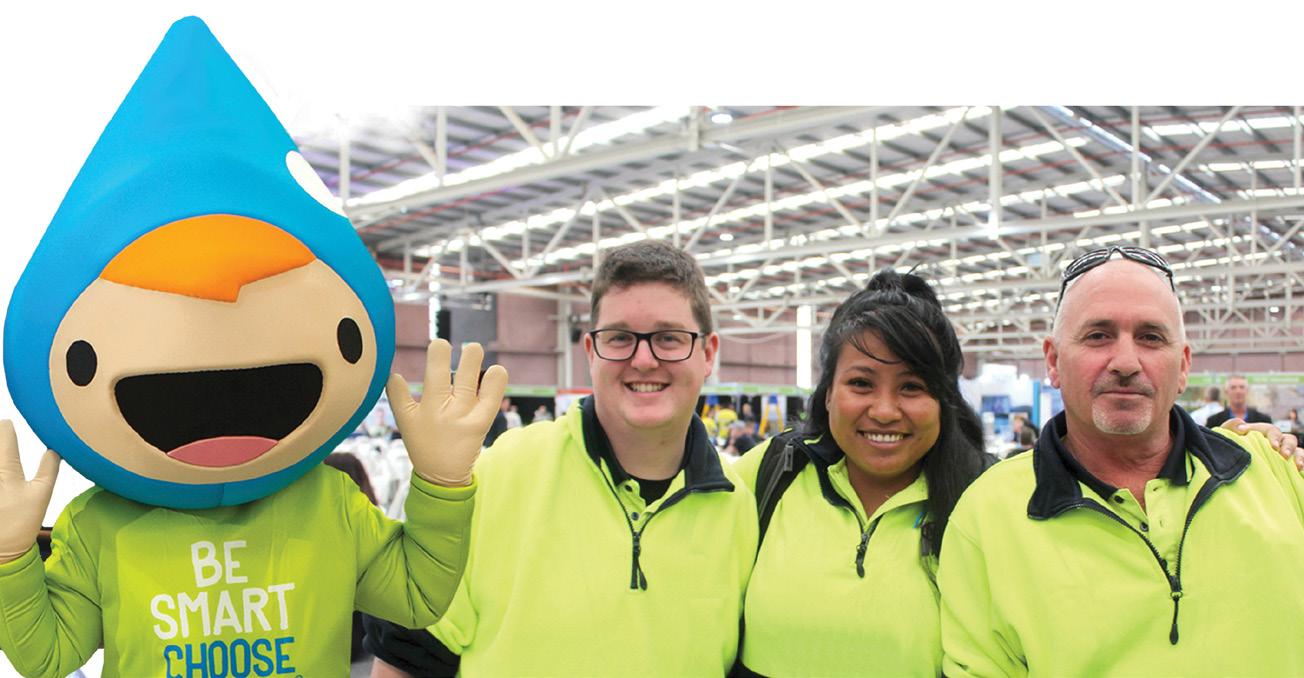
All industry personnel involved in the operation and maintenance of urban, rural and industrial water related infrastructure for the management, conveyance, treatment, discharge and reuse of water and trade wastes should attend this conference.
• 22+ speakers over 2 days
• 150+ exhibiting companies
• Ixom 2021 Best Tasting Tap Water in Victoria
• Victorian Main Tapping competition
• Listen to the experience of others through the latest “operational” technical and research based information platform and poster presentations.
WIOA is a national association facilitating the collection, development and exchange of quality information between people undertaking operational roles in the water industry.
• View and discuss the latest advances in technical equipment, products and services with suppliers and trade consultants.
• Update your knowledge and skills through interaction with fellow water industry employees.
Supported by Promoting best practice in water management by building the knowledge, skills and networks of operators.
Sponsored by Hosted by Media Partners

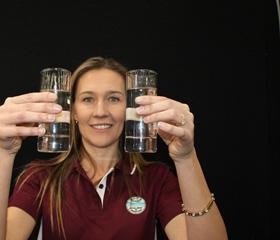



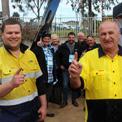










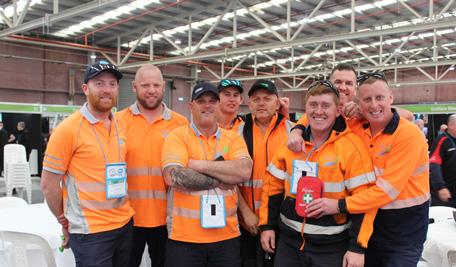
NOV REGISTER NOW wioaconferences.org.au/vic-2021 E info@wioa.org.au
24+25
NEW DATE Join us at our 2021 Victorian Water
Operations Conference & Exhibition Bendigo Exhibition Centre
Industry

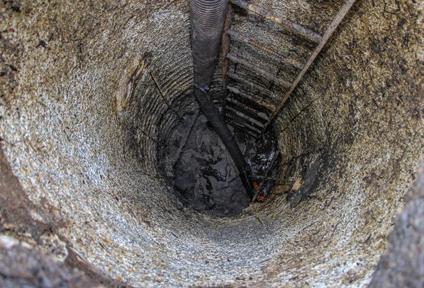

✓ MANHOLE REFURBISHMENT
• Structural rehabilitation of access chambers
• Relining of pipe connections, channels, benching and walls with PVC for 100% gas tight lining
• Stops further deterioration from gas attack
• Patented technology
• 50 year guarantee
✓ SEWER PUMP STATION REFURBISHMENT
• Structural relining of sewer pump stations
• PVC lining provides complete corrosion protection
• Replacement of damaged pipework, mechanical components and lids
• Patented technology
• 50 year guarantee
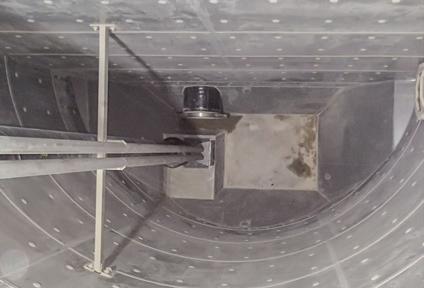

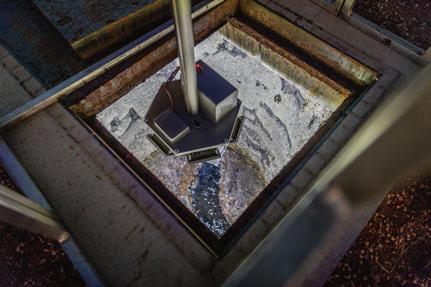

✓ 3D LASER SCANNING AND ASSET INSPECTION
• 3D scan of sewer asset
• Assess structural integrity of asset
• Determine amount of concrete deterioration
• Detailed interactive report with 3D modelling
• High definition video footage and photographs





www.mcrobertcontracting.com.au 08 9411 0666 office.admin@mcrobert.com.au
BEFORE
BEFORE AFTER AFTER BEFORE




























































 by April Shepherd, Journalist, Utility Magazine
by April Shepherd, Journalist, Utility Magazine



































































































































































